

How to Write a Book Review: The Ultimate Guide
WHAT IS A BOOK REVIEW?

Traditionally, book reviews are evaluations of a recently published book in any genre. Usually, around the 500 to 700-word mark, they briefly describe a text’s main elements while appraising the work’s strengths and weaknesses. Published book reviews can appear in newspapers, magazines, and academic journals. They provide the reader with an overview of the book itself and indicate whether or not the reviewer would recommend the book to the reader.
WHAT IS THE PURPOSE OF A BOOK REVIEW?
There was a time when book reviews were a regular appearance in every quality newspaper and many periodicals. They were essential elements in whether or not a book would sell well. A review from a heavyweight critic could often be the deciding factor in whether a book became a bestseller or a damp squib. In the last few decades, however, the book review’s influence has waned considerably, with many potential book buyers preferring to consult customer reviews on Amazon, or sites like Goodreads, before buying. As a result, book review’s appearance in newspapers, journals, and digital media has become less frequent.
WHY BOTHER TEACHING STUDENTS TO WRITE BOOK REVIEWS AT ALL?
Even in the heyday of the book review’s influence, few students who learned the craft of writing a book review became literary critics! The real value of crafting a well-written book review for a student does not lie in their ability to impact book sales. Understanding how to produce a well-written book review helps students to:
● Engage critically with a text
● Critically evaluate a text
● Respond personally to a range of different writing genres
● Improve their own reading, writing, and thinking skills.
Not to Be Confused with a Book Report!
WHAT’S THE DIFFERENCE BETWEEN A BOOK REVIEW AND A BOOK REPORT?

While the terms are often used interchangeably, there are clear differences in both the purpose and the format of the two genres. Generally speaking, book reports aim to give a more detailed outline of what occurs in a book. A book report on a work of fiction will tend to give a comprehensive account of the characters, major plot lines, and themes in the book. Book reports are usually written around the K-12 age range, while book reviews tend not to be undertaken by those at the younger end of this age range due to the need for the higher-level critical skills required in writing them. At their highest expression, book reviews are written at the college level and by professional critics.
Learn how to write a book review step by step with our complete guide for students and teachers by familiarizing yourself with the structure and features.
BOOK REVIEW STRUCTURE
ANALYZE Evaluate the book with a critical mind.
THOROUGHNESS The whole is greater than the sum of all its parts. Review the book as a WHOLE.
COMPARE Where appropriate compare to similar texts and genres.
THUMBS UP OR DOWN? You are going to have to inevitably recommend or reject this book to potential readers.
BE CONSISTENT Take a stance and stick with it throughout your review.
FEATURES OF A BOOK REVIEW
PAST TENSE You are writing about a book you have already read.
EMOTIVE LANGUAGE Whatever your stance or opinion be passionate about it. Your audience will thank you for it.
VOICE Both active and passive voice are used in recounts.
A COMPLETE UNIT ON REVIEW AND ANALYSIS OF TEXTS

⭐ Make MOVIES A MEANINGFUL PART OF YOUR CURRICULUM with this engaging collection of tasks and tools your students will love. ⭐ All the hard work is done for you with NO PREPARATION REQUIRED.
This collection of 21 INDEPENDENT TASKS and GRAPHIC ORGANIZERS takes students beyond the hype, special effects and trailers to look at visual literacy from several perspectives offering DEEP LEARNING OPPORTUNITIES by watching a SERIES, DOCUMENTARY, FILM, and even VIDEO GAMES.
ELEMENTS OF A BOOK REVIEW
As with any of the writing genres we teach our students, a book review can be helpfully explained in terms of criteria. While there is much to the ‘art’ of writing, there is also, thankfully, a lot of the nuts and bolts that can be listed too. Have students consider the following elements before writing:
● Title: Often, the title of the book review will correspond to the title of the text itself, but there may also be some examination of the title’s relevance. How does it fit into the purpose of the work as a whole? Does it convey a message or reveal larger themes explored within the work?
● Author: Within the book review, there may be some discussion of who the author is and what they have written before, especially if it relates to the current work being reviewed. There may be some mention of the author’s style and what they are best known for. If the author has received any awards or prizes, this may also be mentioned within the body of the review.
● Genre: A book review will identify the genre that the book belongs to, whether fiction or nonfiction, poetry, romance, science-fiction, history etc. The genre will likely tie in, too with who the intended audience for the book is and what the overall purpose of the work is.
● Book Jacket / Cover: Often, a book’s cover will contain artwork that is worthy of comment. It may contain interesting details related to the text that contribute to, or detract from, the work as a whole.
● Structure: The book’s structure will often be heavily informed by its genre. Have students examine how the book is organized before writing their review. Does it contain a preface from a guest editor, for example? Is it written in sections or chapters? Does it have a table of contents, index, glossary etc.? While all these details may not make it into the review itself, looking at how the book is structured may reveal some interesting aspects.
● Publisher and Price: A book review will usually contain details of who publishes the book and its cost. A review will often provide details of where the book is available too.

BOOK REVIEW KEY ELEMENTS
As students read and engage with the work they will review, they will develop a sense of the shape their review will take. This will begin with the summary. Encourage students to take notes during the reading of the work that will help them in writing the summary that will form an essential part of their review. Aspects of the book they may wish to take notes on in a work of fiction may include:
● Characters: Who are the main characters? What are their motivations? Are they convincingly drawn? Or are they empathetic characters?
● Themes: What are the main themes of the work? Are there recurring motifs in the work? Is the exploration of the themes deep or surface only?
● Style: What are the key aspects of the writer’s style? How does it fit into the wider literary world?
● Plot: What is the story’s main catalyst? What happens in the rising action? What are the story’s subplots?
A book review will generally begin with a short summary of the work itself. However, it is important not to give too much away, remind students – no spoilers, please! For nonfiction works, this may be a summary of the main arguments of the work, again, without giving too much detail away. In a work of fiction, a book review will often summarise up to the rising action of the piece without going beyond to reveal too much!

The summary should also provide some orientation for the reader. Given the nature of the purpose of a review, it is important that students’ consider their intended audience in the writing of their review. Readers will most likely not have read the book in question and will require some orientation. This is often achieved through introductions to the main characters, themes, primary arguments etc. This will help the reader to gauge whether or not the book is of interest to them.
Once your student has summarized the work, it is time to ‘review’ in earnest. At this point, the student should begin to detail their own opinion of the book. To do this well they should:
i. Make It Personal
Often when teaching essay writing we will talk to our students about the importance of climbing up and down the ladder of abstraction. Just as it is helpful to explore large, more abstract concepts in an essay by bringing it down to Earth, in a book review, it is important that students can relate the characters, themes, ideas etc to their own lives.
Book reviews are meant to be subjective. They are opinion pieces, and opinions grow out of our experiences of life. Encourage students to link the work they are writing about to their own personal life within the body of the review. By making this personal connection to the work, students contextualize their opinions for the readers and help them to understand whether the book will be of interest to them or not in the process.
ii. Make It Universal
Just as it is important to climb down the ladder of abstraction to show how the work relates to individual life, it is important to climb upwards on the ladder too. Students should endeavor to show how the ideas explored in the book relate to the wider world. The may be in the form of the universality of the underlying themes in a work of fiction or, for example, the international implications for arguments expressed in a work of nonfiction.
iii. Support Opinions with Evidence
A book review is a subjective piece of writing by its very nature. However, just because it is subjective does not mean that opinions do not need to be justified. Make sure students understand how to back up their opinions with various forms of evidence, for example, quotations, statistics, and the use of primary and secondary sources.
EDIT AND REVISE YOUR BOOK REVIEW

As with any writing genre, encourage students to polish things up with review and revision at the end. Encourage them to proofread and check for accurate spelling throughout, with particular attention to the author’s name, character names, publisher etc.
It is good practice too for students to double-check their use of evidence. Are statements supported? Are the statistics used correctly? Are the quotations from the text accurate? Mistakes such as these uncorrected can do great damage to the value of a book review as they can undermine the reader’s confidence in the writer’s judgement.
The discipline of writing book reviews offers students opportunities to develop their writing skills and exercise their critical faculties. Book reviews can be valuable standalone activities or serve as a part of a series of activities engaging with a central text. They can also serve as an effective springboard into later discussion work based on the ideas and issues explored in a particular book. Though the book review does not hold the sway it once did in the mind’s of the reading public, it still serves as an effective teaching tool in our classrooms today.

Teaching Resources
Use our resources and tools to improve your student’s writing skills through proven teaching strategies.
BOOK REVIEW GRAPHIC ORGANIZER (TEMPLATE)

101 DIGITAL & PRINT GRAPHIC ORGANIZERS FOR ALL CURRICULUM AREAS

Introduce your students to 21st-century learning with this GROWING BUNDLE OF 101 EDITABLE & PRINTABLE GRAPHIC ORGANIZERS. ✌ NO PREP REQUIRED!!! ✌ Go paperless, and let your students express their knowledge and creativity through the power of technology and collaboration inside and outside the classroom with ease.
Whilst you don’t have to have a 1:1 or BYOD classroom to benefit from this bundle, it has been purpose-built to deliver through platforms such as ✔ GOOGLE CLASSROOM, ✔ OFFICE 365, ✔ or any CLOUD-BASED LEARNING PLATFORM.
Book and Movie review writing examples (Student Writing Samples)
Below are a collection of student writing samples of book reviews. Click on the image to enlarge and explore them in greater detail. Please take a moment to both read the movie or book review in detail but also the teacher and student guides which highlight some of the key elements of writing a text review
Please understand these student writing samples are not intended to be perfect examples for each age or grade level but a piece of writing for students and teachers to explore together to critically analyze to improve student writing skills and deepen their understanding of book review writing.
We would recommend reading the example either a year above and below, as well as the grade you are currently working with to gain a broader appreciation of this text type .

BOOK REVIEW VIDEO TUTORIALS

OTHER GREAT ARTICLES RELATED TO BOOK REVIEWS

Transactional Writing

How to write a text response

How to Write a Compare and Contrast Essay

How to Write Excellent Expository Essays
Book Review
Book Review Examples
Last updated on: Nov 20, 2023
Good Book Review Examples to Help you Write a Great Review
By: Nova A.
Reviewed By: Chris H.
Published on: Mar 30, 2021

A book review is a common assignment that allows the students to demonstrate the author’s intentions in the book. It also provides them with the chance not only to criticize but also to give constructive criticism on how they can make improvements.
The purpose of writing a book review is to come up with your opinion about the author’s ideas presented in the book. On the other hand, a book analysis is completely based on opinions that are relevant to the book.
Writing a review is something that can be done with any book that you read. However, some genres are harder to write. But with a proper plan, you can easily write a great review on any book.
Read some short book review examples in this guide. They will help you understand the key elements of writing a great review in no time.

On this Page
Academic Book Review Examples
If you are assigned to write a book review, referring to some examples will be of great help. In addition, reading examples before starting the writing process will help you understand what elements are needed for a great book review. There are also many review sites online you can get help from.
Academic book reviews follow a fairly simple structure. It usually includes an introduction, middle paragraphs, and a conclusion that sums up all the ideas.
For a great book review, here are the things you need to focus on during the writing process.
- The main argument presented by the author
- Author’s methodologyAppropriateness for the audience
- Relationship to the real world
Have a look at the following book review examples for kids before beginning the writing process.
Book Review Examples for Middle School Students
Book Review Example For Kids
Book Review Examples for High School Students

Paper Due? Why Suffer? That's our Job!
Book Review Examples for College Students
Book Review Examples for University Students
How to Write a Book Review - Examples
If you don’t know how to write a book review, look at the following steps.
The first step is to plan and create an outline that includes all the points that you will have to cover in the review. Don’t forget to include all the information about the characters, plot information, and some other parts of the chosen book.
The three parts of a book review are:
1. Provide a Summary
What is the book about? Write about the main characters and what is the conflict that is discussed in the book.
2. Provide Your Evaluation
Share your thoughts about the book and what elements work best.
3. Rate the Book
Rate and recommend the book to others who will enjoy reading this book.
If you need to submit a book review soon, we suggest you start reading some book reviews online. Here you can also find some good book review writing examples to understand how to craft each section of a book review.
Book Review Introduction Examples
Thesis Statement Book Review Examples
Tough Essay Due? Hire Tough Writers!
Book Review Conclusion Examples
Critical Book Review Examples
A book review is a critical evaluation of the book, movie, or any other literary work. It has two goals: the first is to inform the readers about the content of the book, and the second is to evaluate your judgment about the book.
A book review is more than a book report. A review is basically a critical essay that evaluates the merits of a literary work. The purpose of writing a book review is not to prove that you have read a book but to show that you think critically about the chosen book.
When you are asked to write a critical book review, you need to identify, summarize and evaluate the ideas of the author. In simpler words, you will be examining and evaluating another person’s work from your point of view.
Science Book Review Examples
A scientific book review will contain the same elements as writing a review for a fiction book; some elements might vary. When you are reviewing a scientific text, you need to pay attention to the writing style and the validity of the content.
Most students turn to non-fictional sources of information. It is important to make sure the information you provide in your review is factual and scientific.
Book review writing can be difficult if you don’t know how to follow the standard protocols. That’s where our reliable book review writing service aims to provide the necessary help.
No matter what your academic level is, we can provide you with the best book review writing help. This type of writing assignment can be tricky and time-consuming. So, if you don’t know how to crack this task, better get professional help.
We at 5StarEssays.com provide exceptional book review writing help. Not only book reviews, but we also provide the best ‘ write an essay for me ’ help to students. Moreover, we also have an AI essay writer to help you with tight deadlines, give it a try now!
Frequently Asked Questions
How do you write a book review example.
Here are some steps that will help you to write a book review example.
- Start writing with few sentences and describe what the book is all about
- Focus on your thoughts
- Mention things that you dont like about the book.
- Summarize your thoughts.
- Give rating to the book.

Thesis, Law
As a Digital Content Strategist, Nova Allison has eight years of experience in writing both technical and scientific content. With a focus on developing online content plans that engage audiences, Nova strives to write pieces that are not only informative but captivating as well.
Was This Blog Helpful?
Keep reading.
- Book Review - An Easy Guide To Write A Review

People Also Read
- what is a topic sentence
- classification essay
- how to start an essay
- literary analysis essay topics
- writing a book review
Burdened With Assignments?

Advertisement
- Homework Services: Essay Topics Generator
© 2024 - All rights reserved
- Our Writers
- How to Order
- Assignment Writing Service
- Report Writing Service
- Buy Coursework
- Dissertation Writing Service
- Research Paper Writing Service
- All Essay Services
- Buy Research Paper
- Buy Term Paper
- Buy Dissertation
- Buy Case study
- Buy Presentation
- Buy Personal statement
Book Review Writing
Book Review Examples
Book Review Examples to Help You Get Started

People also read
How to Write a Book Review - A Step By Step Guide
A Complete Book Review Format Guide For Students
Are you in desperate need of some assistance to up your book review writing game?
We know that penning down a review can come off as a tricky challenge, but do not worry!
To help you write book reviews that carry the essence of the book and engage readers, we have collected a handful of book review examples in this blog.
The included examples will enable you to understand different writing styles and approaches taken toward book review writing . So, you can use your words effectively to craft the perfect book review.
Let’s kickstart things off!
- 1. Good Book Review Examples for Students
- 2. Short Book Review Examples for Fiction Books
- 3. Non-Fiction Book Review Examples
Good Book Review Examples for Students
You might be a professional writer, or you may not have any experience in writing book reviews. Rest assured, we’ll show you how to write perfect book reviews with the help of a sample template and great examples.
See this template to know what you should include in your book review:
Book Review Template
Here is a good book review example for 4th-grade students:

Paper Due? Why Suffer? That's our Job!
Book Review Examples for Middle School Students
Reading reviews written by others can help you get a feel and flavor of good book reviews. Learning how to write a perfect book review can help students to:
- Critically analyze a text
- Give a personal opinion on the text
- Improve analyzing and critical thinking skills
Here are some interesting book review examples suitable for middle school students.
Book Review Example for Middle School Students
Book Review Example for Kids
Book Review of Any Book in 300 Words
Science Book Review Example
Book Review Examples For High School Students
Below, you can also find some good book review examples for high school students. These real-life examples can help you get a clear understanding of the standard book review format that you should follow.
Book Review Example for High School Students
Book Review Examples for Class 9
Book Review Example for Grade 10
Book Review Examples for College Students
As a college student, you are required to demonstrate that you have examined the book from different angles. The points you raise in your book review need to be supported with clear facts and evidence.
The following are some interesting critical book review examples for college students to learn how to write a perfect review.
Book Review Example for Class 12
Short Book Review for Students
Conclusion of Book Review Example
Short Book Review Examples for Fiction Books
Fiction book reviews follow the same basic formula as writing book reviews of any other genre. For your help, we have compiled exciting examples of fiction book reviews that you can get valuable assistance from.
Short Book Review Example for Fiction Books
Book Review of Hazel Wood by Melissa Albert
“The Hazel Wood” by Melissa Albert is a work of fiction and falls into fantasy and young adult fiction genres. The novel revolves around fantastical fairy tales, and magical realism, blurring the lines between reality and fantasy.
Here is an example of a comprehensive review of the book Hazel Wood:
Tough Essay Due? Hire Tough Writers!
Non-Fiction Book Review Examples
For reviewing a non-fiction book, you are required to describe the book and summarize major points of interest. You should evaluate the author’s contribution to a subject that you may know very little about.
Here is a great non-fiction book review example to help you come up with a critical perspective on a text.
Non-Fiction Book Review Example
Hopefully, with the help of the above examples, you get a better idea of how to write a perfect book review.
To wrap it up, Writing a great book review is a tricky task, no matter if you are a high school, college, or university student. Book review writing might seem like a simple task, but it requires excellent analyzing and critical thinking skills.
But, not everyone can crack this task easily. They might need additional help from expert book review writers. That’s why our professional essay writing service offers book review writing help whenever you need it.
Professional essay writers at MyPerfectWords.com can help you with all your academic requests within your specified timeline. Just contact our customer service and we’ll handle all your queries promptly.
Keep the words flowing!

Write Essay Within 60 Seconds!

Cathy has been been working as an author on our platform for over five years now. She has a Masters degree in mass communication and is well-versed in the art of writing. Cathy is a professional who takes her work seriously and is widely appreciated by clients for her excellent writing skills.

Paper Due? Why Suffer? That’s our Job!
Keep reading


Book Reviews
What this handout is about.
This handout will help you write a book review, a report or essay that offers a critical perspective on a text. It offers a process and suggests some strategies for writing book reviews.
What is a review?
A review is a critical evaluation of a text, event, object, or phenomenon. Reviews can consider books, articles, entire genres or fields of literature, architecture, art, fashion, restaurants, policies, exhibitions, performances, and many other forms. This handout will focus on book reviews. For a similar assignment, see our handout on literature reviews .
Above all, a review makes an argument. The most important element of a review is that it is a commentary, not merely a summary. It allows you to enter into dialogue and discussion with the work’s creator and with other audiences. You can offer agreement or disagreement and identify where you find the work exemplary or deficient in its knowledge, judgments, or organization. You should clearly state your opinion of the work in question, and that statement will probably resemble other types of academic writing, with a thesis statement, supporting body paragraphs, and a conclusion.
Typically, reviews are brief. In newspapers and academic journals, they rarely exceed 1000 words, although you may encounter lengthier assignments and extended commentaries. In either case, reviews need to be succinct. While they vary in tone, subject, and style, they share some common features:
- First, a review gives the reader a concise summary of the content. This includes a relevant description of the topic as well as its overall perspective, argument, or purpose.
- Second, and more importantly, a review offers a critical assessment of the content. This involves your reactions to the work under review: what strikes you as noteworthy, whether or not it was effective or persuasive, and how it enhanced your understanding of the issues at hand.
- Finally, in addition to analyzing the work, a review often suggests whether or not the audience would appreciate it.
Becoming an expert reviewer: three short examples
Reviewing can be a daunting task. Someone has asked for your opinion about something that you may feel unqualified to evaluate. Who are you to criticize Toni Morrison’s new book if you’ve never written a novel yourself, much less won a Nobel Prize? The point is that someone—a professor, a journal editor, peers in a study group—wants to know what you think about a particular work. You may not be (or feel like) an expert, but you need to pretend to be one for your particular audience. Nobody expects you to be the intellectual equal of the work’s creator, but your careful observations can provide you with the raw material to make reasoned judgments. Tactfully voicing agreement and disagreement, praise and criticism, is a valuable, challenging skill, and like many forms of writing, reviews require you to provide concrete evidence for your assertions.
Consider the following brief book review written for a history course on medieval Europe by a student who is fascinated with beer:
Judith Bennett’s Ale, Beer, and Brewsters in England: Women’s Work in a Changing World, 1300-1600, investigates how women used to brew and sell the majority of ale drunk in England. Historically, ale and beer (not milk, wine, or water) were important elements of the English diet. Ale brewing was low-skill and low status labor that was complimentary to women’s domestic responsibilities. In the early fifteenth century, brewers began to make ale with hops, and they called this new drink “beer.” This technique allowed brewers to produce their beverages at a lower cost and to sell it more easily, although women generally stopped brewing once the business became more profitable.
The student describes the subject of the book and provides an accurate summary of its contents. But the reader does not learn some key information expected from a review: the author’s argument, the student’s appraisal of the book and its argument, and whether or not the student would recommend the book. As a critical assessment, a book review should focus on opinions, not facts and details. Summary should be kept to a minimum, and specific details should serve to illustrate arguments.
Now consider a review of the same book written by a slightly more opinionated student:
Judith Bennett’s Ale, Beer, and Brewsters in England: Women’s Work in a Changing World, 1300-1600 was a colossal disappointment. I wanted to know about the rituals surrounding drinking in medieval England: the songs, the games, the parties. Bennett provided none of that information. I liked how the book showed ale and beer brewing as an economic activity, but the reader gets lost in the details of prices and wages. I was more interested in the private lives of the women brewsters. The book was divided into eight long chapters, and I can’t imagine why anyone would ever want to read it.
There’s no shortage of judgments in this review! But the student does not display a working knowledge of the book’s argument. The reader has a sense of what the student expected of the book, but no sense of what the author herself set out to prove. Although the student gives several reasons for the negative review, those examples do not clearly relate to each other as part of an overall evaluation—in other words, in support of a specific thesis. This review is indeed an assessment, but not a critical one.
Here is one final review of the same book:
One of feminism’s paradoxes—one that challenges many of its optimistic histories—is how patriarchy remains persistent over time. While Judith Bennett’s Ale, Beer, and Brewsters in England: Women’s Work in a Changing World, 1300-1600 recognizes medieval women as historical actors through their ale brewing, it also shows that female agency had its limits with the advent of beer. I had assumed that those limits were religious and political, but Bennett shows how a “patriarchal equilibrium” shut women out of economic life as well. Her analysis of women’s wages in ale and beer production proves that a change in women’s work does not equate to a change in working women’s status. Contemporary feminists and historians alike should read Bennett’s book and think twice when they crack open their next brewsky.
This student’s review avoids the problems of the previous two examples. It combines balanced opinion and concrete example, a critical assessment based on an explicitly stated rationale, and a recommendation to a potential audience. The reader gets a sense of what the book’s author intended to demonstrate. Moreover, the student refers to an argument about feminist history in general that places the book in a specific genre and that reaches out to a general audience. The example of analyzing wages illustrates an argument, the analysis engages significant intellectual debates, and the reasons for the overall positive review are plainly visible. The review offers criteria, opinions, and support with which the reader can agree or disagree.
Developing an assessment: before you write
There is no definitive method to writing a review, although some critical thinking about the work at hand is necessary before you actually begin writing. Thus, writing a review is a two-step process: developing an argument about the work under consideration, and making that argument as you write an organized and well-supported draft. See our handout on argument .
What follows is a series of questions to focus your thinking as you dig into the work at hand. While the questions specifically consider book reviews, you can easily transpose them to an analysis of performances, exhibitions, and other review subjects. Don’t feel obligated to address each of the questions; some will be more relevant than others to the book in question.
- What is the thesis—or main argument—of the book? If the author wanted you to get one idea from the book, what would it be? How does it compare or contrast to the world you know? What has the book accomplished?
- What exactly is the subject or topic of the book? Does the author cover the subject adequately? Does the author cover all aspects of the subject in a balanced fashion? What is the approach to the subject (topical, analytical, chronological, descriptive)?
- How does the author support their argument? What evidence do they use to prove their point? Do you find that evidence convincing? Why or why not? Does any of the author’s information (or conclusions) conflict with other books you’ve read, courses you’ve taken or just previous assumptions you had of the subject?
- How does the author structure their argument? What are the parts that make up the whole? Does the argument make sense? Does it persuade you? Why or why not?
- How has this book helped you understand the subject? Would you recommend the book to your reader?
Beyond the internal workings of the book, you may also consider some information about the author and the circumstances of the text’s production:
- Who is the author? Nationality, political persuasion, training, intellectual interests, personal history, and historical context may provide crucial details about how a work takes shape. Does it matter, for example, that the biographer was the subject’s best friend? What difference would it make if the author participated in the events they write about?
- What is the book’s genre? Out of what field does it emerge? Does it conform to or depart from the conventions of its genre? These questions can provide a historical or literary standard on which to base your evaluations. If you are reviewing the first book ever written on the subject, it will be important for your readers to know. Keep in mind, though, that naming “firsts”—alongside naming “bests” and “onlys”—can be a risky business unless you’re absolutely certain.
Writing the review
Once you have made your observations and assessments of the work under review, carefully survey your notes and attempt to unify your impressions into a statement that will describe the purpose or thesis of your review. Check out our handout on thesis statements . Then, outline the arguments that support your thesis.
Your arguments should develop the thesis in a logical manner. That logic, unlike more standard academic writing, may initially emphasize the author’s argument while you develop your own in the course of the review. The relative emphasis depends on the nature of the review: if readers may be more interested in the work itself, you may want to make the work and the author more prominent; if you want the review to be about your perspective and opinions, then you may structure the review to privilege your observations over (but never separate from) those of the work under review. What follows is just one of many ways to organize a review.
Introduction
Since most reviews are brief, many writers begin with a catchy quip or anecdote that succinctly delivers their argument. But you can introduce your review differently depending on the argument and audience. The Writing Center’s handout on introductions can help you find an approach that works. In general, you should include:
- The name of the author and the book title and the main theme.
- Relevant details about who the author is and where they stand in the genre or field of inquiry. You could also link the title to the subject to show how the title explains the subject matter.
- The context of the book and/or your review. Placing your review in a framework that makes sense to your audience alerts readers to your “take” on the book. Perhaps you want to situate a book about the Cuban revolution in the context of Cold War rivalries between the United States and the Soviet Union. Another reviewer might want to consider the book in the framework of Latin American social movements. Your choice of context informs your argument.
- The thesis of the book. If you are reviewing fiction, this may be difficult since novels, plays, and short stories rarely have explicit arguments. But identifying the book’s particular novelty, angle, or originality allows you to show what specific contribution the piece is trying to make.
- Your thesis about the book.
Summary of content
This should be brief, as analysis takes priority. In the course of making your assessment, you’ll hopefully be backing up your assertions with concrete evidence from the book, so some summary will be dispersed throughout other parts of the review.
The necessary amount of summary also depends on your audience. Graduate students, beware! If you are writing book reviews for colleagues—to prepare for comprehensive exams, for example—you may want to devote more attention to summarizing the book’s contents. If, on the other hand, your audience has already read the book—such as a class assignment on the same work—you may have more liberty to explore more subtle points and to emphasize your own argument. See our handout on summary for more tips.
Analysis and evaluation of the book
Your analysis and evaluation should be organized into paragraphs that deal with single aspects of your argument. This arrangement can be challenging when your purpose is to consider the book as a whole, but it can help you differentiate elements of your criticism and pair assertions with evidence more clearly. You do not necessarily need to work chronologically through the book as you discuss it. Given the argument you want to make, you can organize your paragraphs more usefully by themes, methods, or other elements of the book. If you find it useful to include comparisons to other books, keep them brief so that the book under review remains in the spotlight. Avoid excessive quotation and give a specific page reference in parentheses when you do quote. Remember that you can state many of the author’s points in your own words.
Sum up or restate your thesis or make the final judgment regarding the book. You should not introduce new evidence for your argument in the conclusion. You can, however, introduce new ideas that go beyond the book if they extend the logic of your own thesis. This paragraph needs to balance the book’s strengths and weaknesses in order to unify your evaluation. Did the body of your review have three negative paragraphs and one favorable one? What do they all add up to? The Writing Center’s handout on conclusions can help you make a final assessment.
Finally, a few general considerations:
- Review the book in front of you, not the book you wish the author had written. You can and should point out shortcomings or failures, but don’t criticize the book for not being something it was never intended to be.
- With any luck, the author of the book worked hard to find the right words to express her ideas. You should attempt to do the same. Precise language allows you to control the tone of your review.
- Never hesitate to challenge an assumption, approach, or argument. Be sure, however, to cite specific examples to back up your assertions carefully.
- Try to present a balanced argument about the value of the book for its audience. You’re entitled—and sometimes obligated—to voice strong agreement or disagreement. But keep in mind that a bad book takes as long to write as a good one, and every author deserves fair treatment. Harsh judgments are difficult to prove and can give readers the sense that you were unfair in your assessment.
- A great place to learn about book reviews is to look at examples. The New York Times Sunday Book Review and The New York Review of Books can show you how professional writers review books.
Works consulted
We consulted these works while writing this handout. This is not a comprehensive list of resources on the handout’s topic, and we encourage you to do your own research to find additional publications. Please do not use this list as a model for the format of your own reference list, as it may not match the citation style you are using. For guidance on formatting citations, please see the UNC Libraries citation tutorial . We revise these tips periodically and welcome feedback.
Drewry, John. 1974. Writing Book Reviews. Boston: Greenwood Press.
Hoge, James. 1987. Literary Reviewing. Charlottesville: University Virginia of Press.
Sova, Dawn, and Harry Teitelbaum. 2002. How to Write Book Reports , 4th ed. Lawrenceville, NY: Thomson/Arco.
Walford, A.J. 1986. Reviews and Reviewing: A Guide. Phoenix: Oryx Press.
You may reproduce it for non-commercial use if you use the entire handout and attribute the source: The Writing Center, University of North Carolina at Chapel Hill
Make a Gift
How to Write a Book Review: A Comprehensive Tutorial With Examples

You don’t need to be a literary expert to craft captivating book reviews. With one in every three readers selecting books based on insightful reviews, your opinions can guide fellow bibliophiles toward their next literary adventure.
Learning how to write a book review will not only help you excel at your assigned tasks, but you’ll also contribute valuable insights to the book-loving community and turn your passion into a professional pursuit.
In this comprehensive guide, PaperPerk will walk you through a few simple steps to master the art of writing book reviews so you can confidently embark on this rewarding journey.
What is a Book Review?
A book review is a critical evaluation of a book, offering insights into its content, quality, and impact. It helps readers make informed decisions about whether to read the book.
Writing a book review as an assignment benefits students in multiple ways. Firstly, it teaches them how to write a book review by developing their analytical skills as they evaluate the content, themes, and writing style .
Secondly, it enhances their ability to express opinions and provide constructive criticism. Additionally, book review assignments expose students to various publications and genres, broadening their knowledge.
Furthermore, these tasks foster essential skills for academic success, like critical thinking and the ability to synthesize information. By now, we’re sure you want to learn how to write a book review, so let’s look at the book review template first.
Table of Contents
Book Review Template
How to write a book review- a step by step guide.
Check out these 5 straightforward steps for composing the best book review.
Step 1: Planning Your Book Review – The Art of Getting Started
You’ve decided to take the plunge and share your thoughts on a book that has captivated (or perhaps disappointed) you. Before you start book reviewing, let’s take a step back and plan your approach. Since knowing how to write a book review that’s both informative and engaging is an art in itself.
Choosing Your Literature
First things first, pick the book you want to review. This might seem like a no-brainer, but selecting a book that genuinely interests you will make the review process more enjoyable and your insights more authentic.
Crafting the Master Plan
Next, create an outline that covers all the essential points you want to discuss in your review. This will serve as the roadmap for your writing journey.
The Devil is in the Details
As you read, note any information that stands out, whether it overwhelms, underwhelms, or simply intrigues you. Pay attention to:
- The characters and their development
- The plot and its intricacies
- Any themes, symbols, or motifs you find noteworthy
Remember to reserve a body paragraph for each point you want to discuss.
The Key Questions to Ponder
When planning your book review, consider the following questions:
- What’s the plot (if any)? Understanding the driving force behind the book will help you craft a more effective review.
- Is the plot interesting? Did the book hold your attention and keep you turning the pages?
- Are the writing techniques effective? Does the author’s style captivate you, making you want to read (or reread) the text?
- Are the characters or the information believable? Do the characters/plot/information feel real, and can you relate to them?
- Would you recommend the book to anyone? Consider if the book is worthy of being recommended, whether to impress someone or to support a point in a literature class.
- What could improve? Always keep an eye out for areas that could be improved. Providing constructive criticism can enhance the quality of literature.
Step 2 – Crafting the Perfect Introduction to Write a Book Review
In this second step of “how to write a book review,” we’re focusing on the art of creating a powerful opening that will hook your audience and set the stage for your analysis.
Identify Your Book and Author
Begin by mentioning the book you’ve chosen, including its title and the author’s name. This informs your readers and establishes the subject of your review.
Ponder the Title
Next, discuss the mental images or emotions the book’s title evokes in your mind . This helps your readers understand your initial feelings and expectations before diving into the book.
Judge the Book by Its Cover (Just a Little)
Take a moment to talk about the book’s cover. Did it intrigue you? Did it hint at what to expect from the story or the author’s writing style? Sharing your thoughts on the cover can offer a unique perspective on how the book presents itself to potential readers.
Present Your Thesis
Now it’s time to introduce your thesis. This statement should be a concise and insightful summary of your opinion of the book. For example:
“Normal People” by Sally Rooney is a captivating portrayal of the complexities of human relationships, exploring themes of love, class, and self-discovery with exceptional depth and authenticity.
Ensure that your thesis is relevant to the points or quotes you plan to discuss throughout your review.
Incorporating these elements into your introduction will create a strong foundation for your book review. Your readers will be eager to learn more about your thoughts and insights on the book, setting the stage for a compelling and thought-provoking analysis.
How to Write a Book Review: Step 3 – Building Brilliant Body Paragraphs
You’ve planned your review and written an attention-grabbing introduction. Now it’s time for the main event: crafting the body paragraphs of your book review. In this step of “how to write a book review,” we’ll explore the art of constructing engaging and insightful body paragraphs that will keep your readers hooked.
Summarize Without Spoilers
Begin by summarizing a specific section of the book, not revealing any major plot twists or spoilers. Your goal is to give your readers a taste of the story without ruining surprises.
Support Your Viewpoint with Quotes
Next, choose three quotes from the book that support your viewpoint or opinion. These quotes should be relevant to the section you’re summarizing and help illustrate your thoughts on the book.
Analyze the Quotes
Write a summary of each quote in your own words, explaining how it made you feel or what it led you to think about the book or the author’s writing. This analysis should provide insight into your perspective and demonstrate your understanding of the text.
Structure Your Body Paragraphs
Dedicate one body paragraph to each quote, ensuring your writing is well-connected, coherent, and easy to understand.
For example:
- In Jane Eyre , Charlotte Brontë writes, “I am no bird; and no net ensnares me.” This powerful statement highlights Jane’s fierce independence and refusal to be trapped by societal expectations.
- In Normal People , Sally Rooney explores the complexities of love and friendship when she writes, “It was culture as class performance, literature fetishized for its ability to take educated people on false emotional journeys.” This quote reveals the author’s astute observations on the role of culture and class in shaping personal relationships.
- In Wuthering Heights , Emily Brontë captures the tumultuous nature of love with the quote, “He’s more myself than I am. Whatever our souls are made of, his and mine are the same.” This poignant line emphasizes the deep, unbreakable bond between the story’s central characters.
By following these guidelines, you’ll create body paragraphs that are both captivating and insightful, enhancing your book review and providing your readers with a deeper understanding of the literary work.
How to Write a Book Review: Step 4 – Crafting a Captivating Conclusion
You’ve navigated through planning, introductions, and body paragraphs with finesse. Now it’s time to wrap up your book review with a conclusion that leaves a lasting impression . In this final step of “how to write a book review,” we’ll explore the art of writing a memorable and persuasive conclusion.
Summarize Your Analysis
Begin by summarizing the key points you’ve presented in the body paragraphs. This helps to remind your readers of the insights and arguments you’ve shared throughout your review.
Offer Your Final Conclusion
Next, provide a conclusion that reflects your overall feelings about the book. This is your chance to leave a lasting impression and persuade your readers to consider your perspective.
Address the Book’s Appeal
Now, answer the question: Is this book worth reading? Be clear about who would enjoy the book and who might not. Discuss the taste preferences and circumstances that make the book more appealing to some readers than others.
For example: The Alchemist is a book that can enchant a young teen, but those who are already well-versed in classic literature might find it less engaging.
Be Subtle and Balanced
Avoid simply stating whether you “liked” or “disliked” the book. Instead, use nuanced language to convey your message. Highlight the pros and cons of reading the type of literature you’ve reviewed, offering a balanced perspective.
Bringing It All Together
By following these guidelines, you’ll craft a conclusion that leaves your readers with a clear understanding of your thoughts and opinions on the book. Your review will be a valuable resource for those considering whether to pick up the book, and your witty and insightful analysis will make your review a pleasure to read. So conquer the world of book reviews, one captivating conclusion at a time!
How to Write a Book Review: Step 5 – Rating the Book (Optional)
You’ve masterfully crafted your book review, from the introduction to the conclusion. But wait, there’s one more step you might consider before calling it a day: rating the book. In this optional step of “how to write a book review,” we’ll explore the benefits and methods of assigning a rating to the book you’ve reviewed.
Why Rate the Book?
Sometimes, when writing a professional book review, it may not be appropriate to state whether you liked or disliked the book. In such cases, assigning a rating can be an effective way to get your message across without explicitly sharing your personal opinion.
How to Rate the Book
There are various rating systems you can use to evaluate the book, such as:
- A star rating (e.g., 1 to 5 stars)
- A numerical score (e.g., 1 to 10)
- A letter grade (e.g., A+ to F)
Choose a rating system that best suits your style and the format of your review. Be consistent in your rating criteria, considering writing quality, character development, plot, and overall enjoyment.
Tips for Rating the Book
Here are some tips for rating the book effectively:
- Be honest: Your rating should reflect your true feelings about the book. Don’t inflate or deflate your rating based on external factors, such as the book’s popularity or the author’s reputation.
- Be fair:Consider the book’s merits and shortcomings when rating. Even if you didn’t enjoy the book, recognize its strengths and acknowledge them in your rating.
- Be clear: Explain the rationale behind your rating so your readers understand the factors that influenced your evaluation.
Wrapping Up
By including a rating in your book review, you provide your readers with an additional insight into your thoughts on the book. While this step is optional, it can be a valuable tool for conveying your message subtly yet effectively. So, rate those books confidently, adding a touch of wit and wisdom to your book reviews.
Additional Tips on How to Write a Book Review: A Guide
In this segment, we’ll explore additional tips on how to write a book review. Get ready to captivate your readers and make your review a memorable one!
Hook ’em with an Intriguing Introduction
Keep your introduction precise and to the point. Readers have the attention span of a goldfish these days, so don’t let them swim away in boredom. Start with a bang and keep them hooked!
Embrace the World of Fiction
When learning how to write a book review, remember that reviewing fiction is often more engaging and effective. If your professor hasn’t assigned you a specific book, dive into the realm of fiction and select a novel that piques your interest.
Opinionated with Gusto
Don’t shy away from adding your own opinion to your review. A good book review always features the writer’s viewpoint and constructive criticism. After all, your readers want to know what you think!
Express Your Love (or Lack Thereof)
If you adored the book, let your readers know! Use phrases like “I’ll definitely return to this book again” to convey your enthusiasm. Conversely, be honest but respectful even if the book wasn’t your cup of tea.
Templates and Examples and Expert Help: Your Trusty Sidekicks
Feeling lost? You can always get help from formats, book review examples or online college paper writing service platforms. These trusty sidekicks will help you navigate the world of book reviews with ease.
Be a Champion for New Writers and Literature
Remember to uplift new writers and pieces of literature. If you want to suggest improvements, do so kindly and constructively. There’s no need to be mean about anyone’s books – we’re all in this literary adventure together!
Criticize with Clarity, Not Cruelty
When adding criticism to your review, be clear but not mean. Remember, there’s a fine line between constructive criticism and cruelty. Tread lightly and keep your reader’s feelings in mind.
Avoid the Comparison Trap
Resist the urge to compare one writer’s book with another. Every book holds its worth, and comparing them will only confuse your reader. Stick to discussing the book at hand, and let it shine in its own light.
Top 7 Mistakes and How to Avoid Them
Writing a book review can be a delightful and rewarding experience, especially when you balance analysis, wit, and personal insights. However, some common mistakes can kill the brilliance of your review.
In this section of “how to write a book review,” we’ll explore the top 7 blunders writers commit and how to steer clear of them, with a dash of modernist literature examples and tips for students writing book reviews as assignments.
Succumbing to the Lure of Plot Summaries
Mistake: Diving headfirst into a plot summary instead of dissecting the book’s themes, characters, and writing style.
Example: “The Bell Jar chronicles the life of a young woman who experiences a mental breakdown.”
How to Avoid: Delve into the book’s deeper aspects, such as its portrayal of mental health, societal expectations, and the author’s distinctive narrative voice. Offer thoughtful insights and reflections, making your review a treasure trove of analysis.
Unleashing the Spoiler Kraken
Mistake: Spilling major plot twists or the ending without providing a spoiler warning, effectively ruining the reading experience for potential readers.
Example: “In Metamorphosis, the protagonist’s transformation into a monstrous insect leads to…”
How to Avoid: Tread carefully when discussing significant plot developments, and consider using spoiler warnings. Focus on the impact of these plot points on the overall narrative, character growth, or thematic resonance.
Riding the Personal Bias Express
Mistake: Allowing personal bias to hijack the review without providing sufficient evidence or reasoning to support opinions.
Example: “I detest books about existential crises, so The Sun Also Rises was a snoozefest.”
How to Avoid: While personal opinions are valid, it’s crucial to back them up with specific examples from the book. Discuss aspects like writing style, character development, or pacing to support your evaluation and provide a more balanced perspective.
Wielding the Vague Language Saber
Mistake: Resorting to generic, vague language that fails to capture the nuances of the book and can come across as clichéd.
Example: “This book was mind-blowing. It’s a must-read for everyone.”
How to Avoid: Use precise and descriptive language to express your thoughts. Employ specific examples and quotations to highlight memorable scenes, the author’s unique writing style, or the impact of the book’s themes on readers.
Ignoring the Contextualization Compass
Mistake: Neglecting to provide context about the author, genre, or cultural relevance of the book, leaving readers without a proper frame of reference.
Example: “This book is dull and unoriginal.”
How to Avoid: Offer readers a broader understanding by discussing the author’s background, the genre conventions the book adheres to or subverts, and any societal or historical contexts that inform the narrative. This helps readers appreciate the book’s uniqueness and relevance.
Overindulging in Personal Preferences
Mistake: Letting personal preferences overshadow an objective assessment of the book’s merits.
Example: “I don’t like stream-of-consciousness writing, so this book is automatically bad.”
How to Avoid: Acknowledge personal preferences but strive to evaluate the book objectively. Focus on the book’s strengths and weaknesses, considering how well it achieves its goals within its genre or intended audience.
Forgetting the Target Audience Telescope
Mistake: Failing to mention the book’s target audience or who might enjoy it, leading to confusion for potential readers.
Example: “This book is great for everyone.”
How to Avoid: Contemplate the book’s intended audience, genre, and themes. Mention who might particularly enjoy the book based on these factors, whether it’s fans of a specific genre, readers interested in character-driven stories, or those seeking thought-provoking narratives.
By dodging these common pitfalls, writers can craft insightful, balanced, and engaging book reviews that help readers make informed decisions about their reading choices.
These tips are particularly beneficial for students writing book reviews as assignments, as they ensure a well-rounded and thoughtful analysis.!
Many students requested us to cover how to write a book review. This thorough guide is sure to help you. At Paperperk, professionals are dedicated to helping students find their balance. We understand the importance of good grades, so we offer the finest writing service , ensuring students stay ahead of the curve. So seek expert help because only Paperperk is your perfect solution!
What is the difference between a book review and a report?
Who is the target audience for book reviews and book reports, how do book reviews and reports differ in length and content, can i write professional book reviews, what are the key aspects of writing professional book reviews, how can i enhance my book-reviewing skills to write professional reviews, what should be included in a good book review.
Order Original Papers & Essays
Your First Custom Paper Sample is on Us!
Timely Deliveries
No Plagiarism & AI
100% Refund
Try Our Free Paper Writing Service
Related blogs.

Connections with Writers and support
Privacy and Confidentiality Guarantee
Average Quality Score

How To Write A Book Review: 6 Steps To Take
Adiba Jaigirdar
Adiba Jaigirdar is an Irish-Bangladeshi writer, poet, and teacher. She resides in Dublin, Ireland and has an MA in postcolonial studies. She is currently working on her own postcolonial novel and hopes that someday it will see the light of day outside of her computer screen. Twitter: @adiba_j
View All posts by Adiba Jaigirdar
Whether you’re a student, a novice blogger, or just someone looking to become a more active user of Goodreads, writing a book review is an important skill to have! Here are six steps for how to write a book review for school and beyond.

1. Begin with a brief summary of the book
This is probably the best way to introduce any review because it gives context. But make sure to not go into too much detail. Keep it short and sweet since an official summary can be found through a quick google search!
2. Pick out the most important aspects of the book
I usually break this down with character, world-building, themes, and plot. But this might vary between books, genres, and your tastes!
Dedicate a paragraph to each of these important aspects, discussing how well the author dealt with it, along with what you enjoyed and what you didn’t enjoy.
3. Include brief quotes as examples
Including quotes is always a great idea, because it gives examples for everything that you’re saying! If your review talks about a character being particularly witty, a witty line from the character lets your readers see exactly what kind of witty character you’re dealing with here.
But be careful: lengthy quotes can take up big chunks of space and overpower your review. Short quotes will usually get your points across while letting your work shine through.
4. Write a conclusion that summarises everything
Like your introduction, keep your conclusion short and sweet! It should bring up the main points of your review, along with your overall opinion of the book.
5. Find similar books
A great way to wrap up a review is to find similar books to the one you’re reviewing. So you can say, “if you were a fan of X book, I think you’ll definitely like this one!”
You can also be more specific, looking at the exact things that might make two books similar. So you can suggest something like…“if you liked that the main character in X book was a kick-ass superhero, then you’ll love the main character of this book!”
6. Give it a star rating
A star rating is obviously encouraged in a lot of review sites, but they’re not necessary! If you do want to give a star rating, you can go the conventional “out of five/ten” route. You could also try something slightly less conventional, and break down your star-rating into different categories for character/plot/world-building, etc.
Now go forth and review! And share any tips you have for how to write a book review in the comments.
You Might Also Like

How To Write A Book Review: A Student Guide
- What Is A Book Review?
- How To Write A Book Review
- Helpful Tips
If you’ve ever taken an English course or studied literature in any capacity, chances are you’re already very familiar with the idea of a book review. Maybe you’ve even written a book review or two throughout your academic career—hopefully after taking the time to actually read the book in question.
But even with their ubiquity within classrooms around the world, the task of writing a book review can still be daunting. After all, you’re attempting to boil down an entire book into a few short paragraphs! That’s no easy feat. Before you get started on your review, you might be wondering: How much of the book’s plot do I actually need to summarize? Do I need to mention every character in the order that they appear in the story? And what does one talk about in a book review, anyway?
Whether you’re writing a book review for school or just want some helpful tips to level up your Goodreads game, we’ll break down the different sections of a standard book review in this ultimate how-to guide.
What is a book review ?
A book review is a written evaluation of a book in any genre. Often around 500 to 1,000 words in length, book reviews provide a brief summary of the text, analyze its overall merit, and describe the reviewer’s personal opinions and reading experience. Think of it as a more nuanced way of recommending a favorite book— your review serves as your own individual stamp of approval.
If you’ve ever been assigned a book review in an academic setting, you already know that they’re meant to help students retain and further engage with their required reading. But book reviews can also appear outside of the classroom, too. Professional book critics, avid readers, and even bookish content creators may review a book for a major publication, for a personal blog, or on popular book reviewing websites like Goodreads and StoryGraph.
What is the difference between a book review and a book report ?
In casual conversation, one might use the terms “book review” and “book report” interchangeably. And while book reviews and book reports certainly share a few key similarities, there are some important differences that distinguish the two from an academic standpoint.
Often assigned to students in the K-12 age range, book reports give a strictly objective account of what happened in a book. Think major plot points, main characters, and big-picture ideas. They don’t often include the added elements of critical analysis and a subjective review, which is why they’re typically reserved for younger students with less experience with writing and literature.
Book reviews, on the other hand, are more than just a play-by-play of what happened; they require a higher level of critical thinking and engagement with the text. After providing a brief summary of the text, book reviews typically move into a deeper analysis of literary elements, which could include plot, characters, themes, or even the writing style itself. A book review also usually concludes with the reviewer’s personal thoughts, experience, rating, and recommendation (or non-recommendation) of the book.
Get a better grasp on the nuances that set book reports apart from book reviews with this helpful article.
How to write a book review
Section 1: introduction.
To begin your book review, it’s a good idea to start with a compelling hook that captures your audience’s attention and encourages them to continue reading. Don’t give anything major away in these first few sentences—just focus on setting the tone, creating some intrigue, or presenting an interesting question.
Example: With more than 300 million records sold worldwide and a career in music spanning over six decades, Elton John is easily one of the most prolific artists of all time. The singer’s official autobiography, aptly titled Me , gives readers an up-close-and-personal look at the man behind the music.
Section 2: Summary
Next, briefly recap the book you read with a high-level synopsis. Not only does this help clue your audience in on what the book is even about, but it also sets up your thoughts and opinions regarding the book with some important context.
For fiction book summaries, focus on plot points, primary and secondary characters, and overall themes—just be sure to leave out any big reveals and avoid discussing spoilers that could ruin someone’s reading experience. If you’re reviewing a nonfiction book, you can discuss the author’s main ideas, arguments, or thesis statements by section. Don’t forget to mention any essential information about the book in this section, which can include basics like the title, author, publication year, and whether or not it’s part of a series, for example.
Example: Published in 2019 by Henry Holt & Co., Elton John’s personal memoir aims to capture as much of the British singer, pianist, and composer’s fascinating life as possible. The book begins by recounting John’s early childhood experiences growing up in the suburbs of London then moves into his rise to fame and continued success as a musician and producer today.
Make Your Writing Shine!
- By clicking "Sign Up", you are accepting Dictionary.com Terms & Conditions and Privacy policies.
- Phone This field is for validation purposes and should be left unchanged.
Section 3: Critical analysis
Once you’ve recapped the book and provided your audience with all of the need-to-know details, it’s time to dive a little deeper. The critical analysis section of your book review is where you can start to sprinkle in your own thoughts, feelings, and opinions about the text.
If you’re writing a book review in an academic setting or as an assignment for school, you may be required to write about specific literary elements within the text. (Be sure to refer back to your assignment’s instructions for more information!) But if you’ve got free range to write about anything and aren’t sure where to start, here are a few prompts to get your creative juices flowing:
- Characterization: Who are the primary characters, and how do they affect the story? Are they particularly likable or relatable? What do you think their individual arcs represent?
- Structure/form: How does structure play a role in storytelling? Does the author write in long, stream-of-consciousness paragraphs or short, quippy vignettes? Do you think the book would have benefited from a different structure?
- Writing style: How would you describe this author’s writing style? Is it accessible and conversational or rigid and academic? Does this writing style lend itself well to this specific story or genre?
- Themes & ideas: Can you easily identify the story’s main ideas or motifs? What do you think they represent? Are they effective? Why or why not?
Example: I found Elton John’s honesty, vulnerability, and conversational writing style incredibly refreshing as I read this book. It felt less like reading a nonfiction book and more like catching up with a friend. The singer doesn’t pull any punches as he shares everything from delightful anecdotes of his experience as a father to the heart-wrenching details of his struggle with drug addiction. I can’t imagine how difficult it must be to live such a public life; I commend and admire John’s continued openness.
Section 4: Conclusion, personal recommendation, and rating (if applicable)
Finally, wrap up your book review by stating whether or not you personally recommend the book to your intended audience. Don’t throw your audience for a loop by bringing up anything new in this section. Your conclusion should be a natural progression from the previous sections—it’s the cherry on top, if you will.
Note: if you’re writing a book review for a school assignment, you may be able to skip this section based on your assignment’s directions. On the other hand, if you’re writing your review for your personal blog or on a popular bookish site like Goodreads or StoryGraph, it may be helpful to include a star rating, too.
Example: I highly recommend this book to longtime fans of Elton John and casual listeners alike. I grew up listening to Elton John’s greatest hits on the radio, and it was so interesting to learn more about his upbringing, creative inspiration, and life experiences in this book.
Like book reviews and reports, the five-paragraph essay is a classic part of any student’s academic arsenal. Learn how to master it here!
Helpful tips for writing a book review
Read (and re-read) your assignment’s directions. Following your teacher or professor’s instructions is key to nailing a book review assignment in an academic setting. You may be required to follow a certain structure, hit a specified word count, or discuss certain literary devices in your review.
Take notes while you read. Especially when it comes to writing the summary portion of the book review, it can be helpful to actively take notes while you’re reading. Note-taking can help you focus on the main ideas and trace narrative through-lines while they’re fresh in your mind, rather than trying to remember every last detail after you’ve already finished the book. Plus, your notes will serve as a helpful cheat sheet to look back on in case you do end up forgetting something.
Remember to proofread! As with any piece of writing, it’s important to check your work for grammar errors, misspellings, and typos. You don’t want to lose credibility (or points on your grade) for silly mistakes.
Don’t be too harsh. Even if you truly despised the book you read, it’s a good idea to write as if the author of the book might read your review one day. Jumping at the chance to tear down someone’s writing is unnecessary; keep your criticism constructive and remember that authors have feelings, too!
Roused by reading and want to write a book of your own? Check out some tips to get started.

Ways To Say
Synonym of the day

Join Discovery, the new community for book lovers
Trust book recommendations from real people, not robots 🤓
Blog – Posted on Wednesday, Apr 03
How to write a book review in 3 steps.

If the idea of reading for free — or even getting paid to read — sounds like a dream come true, remember that it isn’t a pipe dream. There are many places aspiring book reviewers can read books for free, such as Reedsy Discovery — a new platform for reviewing indie books. Of course, if you’re giving serious thought to becoming a book reviewer, your first step should be learning how to write a book review. To that end, this post covers all the basics of literary criticism. Let’s get started!
The three main steps of writing a book review are simple:
- Provide a summary: What is story about? Who are the main characters and what is the main conflict?
- Present your evaluation: What did you think of the book? What elements worked well, and which ones didn’t?
- Give your recommendation: Would you recommend this book to others? If so, what kinds of readers will enjoy it?
You can also download our free book review templates and use it as a guide! Otherwise, let’s take a closer look at each element.
Pro-tip : But wait! How are you sure if you should become a book reviewer in the first place? If you're on the fence, or curious about your match with a book reviewing career, take our quick quiz:
Should you become a book reviewer?
Find out the answer. Takes 30 seconds!
How to write a review of a book
Step 1. provide a summary.
Have you ever watched a movie only to realize that all the good bits were already in the trailer? Well, you don’t want the review to do that. What you do want the summary to do is reveal the genre, theme, main conflict, and main characters in the story — without giving away spoilers or revealing how the story ends.
A good rule of thumb is not to mention anything that happens beyond the midpoint. Set the stage and give readers a sense of the book without explaining how the central issue is resolved.
Emily W. Thompson's review of The Crossing :
In [Michael] Doane’s debut novel, a young man embarks on a journey of self-discovery with surprising results.
An unnamed protagonist (The Narrator) is dealing with heartbreak. His love, determined to see the world, sets out for Portland, Oregon. But he’s a small-town boy who hasn’t traveled much. So, the Narrator mourns her loss and hides from life, throwing himself into rehabbing an old motorcycle. Until one day, he takes a leap; he packs his bike and a few belongings and heads out to find the Girl. Read more...
Here are a few more reviews with well-written summaries for you to check out. The summary tend to be the longest part of the book review, so we won’t turn this post into a novel itself by pasting them all here: Le Cirque Navire reviewed by Anna Brill, The Heart of Stone reviewed by Kevin R. Dickinson, Fitting Out: The Friendship Experiment reviewed by Lianna Albrizio.
Non-fiction summary tip: The primary goal of a non-fiction summary is to provide context: what problems or issues has the book spotted, and how does it go about addressing them? Be sure to mention the authors of the title and what experience or expertise they bring to the title. Check Stefan Kløvning’s review of Creativity Cycling for an example of a summary that establishes the framework of the book within the context of its field.
Step 2. Present your evaluation
While you should absolutely weave your own personal take of a book into the review, your evaluation shouldn’t only be based on your subjective opinion. Along with presenting how you reacted to the story and how it affected you, you should also try to objectively critique the stronger and weaker elements of the story, and provide examples from the text to back up your points.
To help you write your evaluation, you should record your reactions and thoughts as you work your way through a novel you’re planning on reviewing. Here are some aspects of the book to keep in mind as you do.
Your evaluation might focus heartily on the book’s prose:
Donald Barker's review of Mercenary :
Such are the bones of the story. But, of course, it is the manner in which Mr Gaughran puts the bones back together and fills them with life that makes “Mercenary” such a great read. The author’s style seems plain; it seems straightforward and even simple. But an attempt at imitation or emulation quickly proves that simple it is not. He employs short, punchy sentences that generate excellent dialogue dripping with irony, deadpan humour and wit. This, mixed with good descriptive prose, draws the characters – and what characters they are – along with the tumultuous events in which they participated amidst the stinking, steaming heat of the South American jungle, out from the past to the present; alive, scheming, drinking, womanising and fighting, onto the written page.
You can give readers a sense of the book by drawing comparisons to other well-known titles or authors:
Laura Hartman's review of The Mystery of Ruby's Mistletoe :
Reading Ms. Donovan’s book is reminiscent to one of my favorite authors, Dame Agatha Christie. Setting up the suspects in a snowbound house, asking them to meet in the drawing room and the cleverly satisfying conclusion was extremely gratifying. I can picture Miss Marple and Hercule Poirot nodding at Ms. Donovan saying “Well done!”
Not everyone’s tastes are the same, and you can always acknowledge this by calling out specific story elements in your evaluation:
Kevin R. Dickinson's review of The Heart of Stone :
Whether you enjoy Galley’s worldbuilding will depend heavily on preference. Galley delivers information piecemeal, letting the characters, not the author, navigate the reader through Hartlund. A notable example is the magic system, an enigmatic force that lacks the ridge structures of, say, a Brandon Sanderson novel. While the world’s magical workings are explained, you only learn what the characters know and many mysteries remain by the end. Similar choices throughout make the world feel expansive and authentic.
Non-fiction evaluation tip: A book’s topic is only as compelling as its supporting arguments. Your evaluation of a nonfiction book should address that: how clearly and effectively are the points communicated? Turn back to Stefan’s critique for an example of a non-fiction critique that covers key takeaways and readability, without giving away any “big reveals.”
Step 3. Give your recommendation
At the end of the day, your critique needs to answer this question: is this a book you would (or wouldn’t) recommend to other readers? You might wrap up by comparing it to other books in the same genre, or authors with similar styles, such as: “Fans of so-and-so will enjoy this book.”
Let’s take a look at a few more tips:
You don’t need to write, “I recommend this book” — you can make it clear by highlighting your favorable opinion:
Following in the footsteps of Jack Kerouac and William Least Heat-Moon, Doane offers a coming of age story about a man finding himself on the backroads of America. Doane’s a gifted writer with fluid prose and insightful observations, using The Narrator’s personal interactions to illuminate the diversity of the United States.
Despite his flaws, it’s a pleasure to accompany The Narrator on his physical and emotional journey. The unexpected ending is a fitting denouement to an epic and memorable road trip.
Add more punch to your rating by mentioning what kind of audience will or won’t enjoy the book:
Charleigh Aleyna Reid's review of The King of FU :
I would recommend this book to anyone who grew up in the 90’s and would like to reminisce about the time, someone who is interested to see what it was like to be a 90’s kid, or perhaps anyone who is looking for a unique, funny story about someone’s life.
Unless you found the title absolutely abhorrent, a good way to balance out a less favorable book review it to share what you did like about the book — before ultimately stating why you wouldn’t recommend the novel:
Nicola O's review of Secrets of the Sea Lord :
Overall, there are plenty of enjoyable elements in this story and fans of Atlantis and mer mythology should give it a try. Despite this, it does not rise above a three-star rating, and while I had some difficulty pinning down why this is, I concluded that it comes from a surprisingly unsophisticated vocabulary. There are a couple of graphic sex scenes, which is absolutely fine in a paranormal romance, but if they were removed, I could easily imagine this as an appealing story for middle-schoolers.
Non-fiction recommendation tip: As with fiction book reviews, share why you did or didn’t enjoy the title. However, in one of the starkest divergences from fiction book reviews it’s more important than ever that you mention your expectations coming into the non-fiction book. For instance, if you’re a cow farmer who’s reading a book on the benefits of becoming a vegetarian, you’re coming in with a large and inherent bias that the book will struggle to alter. So your recommendation should cover your thoughts about the book, while clearly taking account your perspective before you started reading. Let’s look once more at Stefan’s review for an example of a rating that includes an explanation of the reviewer’s own bias.
Bonus tips for writing a book review
Let’s wrap up with a few final tips for writing a compelling review.
- Remember, this isn’t a book report. If someone wants the summary of a book, they can read the synopsis. People turn to book reviews for a fellow reader’s take on the book. And for that reason...
- Have an opinion. Even if your opinion is totally middle-of-the-line — you didn’t hate the book but you didn’t love it either — state that clearly, and explain why.
- Make your stance clear from the outset. Don’t save your opinion just for the evaluation/recommendation. Weave your thoughts about the book into your summary as well, so that readers have an idea of your opinion from the outset.
- Back up your points. Instead of just saying, “the prose was evocative” — show readers by providing an actual passage that displays this. Same goes for negative points — don’t simply tell readers you found a character unbelievable, reference a certain (non-spoiler) scene that backs this up.
- Provide the details. Don’t forget to weave the book’s information into the review: is this a debut author? Is this one installment of a series? What types of books has the author written before? What is their background? How many pages does the book have? Who published the book? What is the book’s price?
- Follow guidelines. Is the review you’re writing for Goodreads? For The New York Times ? The content and tone of your review will vary a good deal from publication to publication.
- Learn from others. One of the best ways to learn how to write a great review is to read other reviews! To help you out with that, we’ve published a post all about book review examples .
Writing book reviews can be a rewarding experience! As a book-lover yourself, it’s a great opportunity to help guide readers to their next favorite title. If you’re just getting started as a reviewer and could use a couple more tips and nudges in the right direction, check out our comprehensive blog post on how to become a book reviewer . And if you want to find out which review community is the right fit for you, we recommend taking this quick quiz:
Which review community should you join?
Find out which review community is best for your style. Takes 30 seconds!
Finally, if you feel you've nailed the basics of how to write a book review, we recommend you check out Reedsy Discovery , where you can review books for free and are guaranteed people will read them. To register as a book reviewer, simply go here !
Continue reading
More posts from across the blog.
30 Best Reading Chairs Money Can Buy in 2024
A good chair is hard to find, a good reading chair even more so. Enter this post, which will separate the wheat from the chaff (or should we say the seat from the chaff?) and give you the best reading chairs money can buy!
5 Daphne Du Maurier Books to Read After Watching Rebecca
If you loved Netflix's adaptation of du Maurier's timeless classic, why not read another? We've compiled a list of the best Daphne du Maurier books to make choosing easy.
20 Latinx Authors With Books That Belong on Your TBR List
Latinx authors have been on the forefront of literary development for decades. From magical realist novels to heartfelt poetry, here are 20 Latinx masterpieces you can't miss out on.
Heard about Reedsy Discovery?
Trust real people, not robots, to give you book recommendations.
Or sign up with an
Or sign up with your social account
- Submit your book
- Reviewer directory

Want to be a book reviewer?
Review new books and start building your portfolio.

Book Review Writing Examples
Examples: learn from the efforts of others.
Learning how to write strong reviews takes time and not a little effort. Reading the reviews others have done can help you get a feel for the flow and flavor of reviews.
If I Never Forever Endeavor Review by Hayden, age 4, Southeast Michigan Mensa

This book was about a bird who didn't yet know how to fly.
The bird has to decide if it will try to fly, but it was not sure if it wants to. The bird thought, "If I never forever endeavor" then I won't ever learn. On one wing, he worries he might fail and on the other wing he thinks of how he may succeed. He worries that if he tries, he may get lost in the world. That makes him want to stay in his nest where he's safe.
I think this book would help other children to learn that trying new things can be scary, but sometimes when we try, we can find things that make us happy too. And this book will help others know that mistakes are okay and part of learning.
My favorite part is that the bird tried and learned that she could fly. I also liked that I read this book because it gave me a chance to talk to mom about making mistakes and how I don't like making them. Then I learned they are good and part of learning.
Boys and girls who are 3 to 8 years old would like this book because it teaches about trying a new thing and how it's important to get past being scared so you can learn new things.
I give the book 5 stars since I think it's important for other children to learn about courage.
Flesh & Blood So Cheap Review by Umar B., age 8, Central New Jersy Mensa

I liked this book. People who are interested in national disasters and US history as well as immigration will most probably be interested in reading this book.
Readers can gain knowledge of what it was like to work in New York City in the early 1900s. One of the things that was especially interesting was that there were no safety laws at work. Also, there was a big contrast between the rich and the poor. Some people may not like this book because it is very depressing, but it is an important event in history to remember.
This book was very well written. It has black and white photos along with descriptions of the photos. These photos give us a better idea of what people's lives were like. This book is suitable for 9-20 year olds.
I give this book 5 stars.
Galaxy Zach: Journey to Juno Review by Young Mensan Connor C., age 6, Boston Mensa

Journey To Juno is the second book of the Galaxy Zack series. It is just as good as the first one. It's awesome!
Zack joins the Sprockets Academy Explorers Club at school. They fly on a special trip to Juno, a new planet no one has ever visited. Zack gets paired up with Seth, the class bully, and that's dreadful but Zack is excited when he finds a huge galaxy gemmite. A gemmite that large had not been found in 100 years! Kids will love this book!
Boys and girls will both like it. It's an easy chapter book with pictures on every page. I love the illustrations. I think ages 6-8 would like this but younger kids would like the story being read to them.
My favorite parts are the galactic blast game (it is similar to baseball except there are robots playing), recess at Zack's school where everything is 3-D holographic images, the rainbow river in a crystal cave on Juno, and the galaxy gemmite that Zack finds on Juno. I also loved when a life-size holographic image of his Earth friend appears in Zack's room because he calls him on a hyperphone. I give this book one hundred stars! There is a "to be continued" at the end so you have to read the next book see what's in store. I can't wait to find out what happens!!!
I Capture the Castle Review by Lauren W., age 17, Mensa in Georgia

Dodie Smith's novel I Capture the Castle is a journey through the mind of a young writer as she attempts to chronicle her daily life. Seventeen-year-old Cassandra Mortmain has recently learned to speed-write, and she decides to work on her writing skills by describing the actions and conversations of those around her.
Cassandra lives in a fourteenth-century English castle with an interesting cast of characters: her beautiful older sister, Rose; her rather unsociable author father and his second wife, artist-model Topaz; Stephen, the garden boy; a cat and a bull terrier; and sometimes her brother Thomas when he is home from school. One fateful day they make the acquaintance of the Cotton family, including the two sons, and a web of tangled relationships ensues.
While I definitely recommend this book to other readers, I would recommend it to older teenagers, mainly because it will resonate better with them. The writing is tame enough that younger teens could also read it, but most of the characters are adults or on the verge of adulthood. Older readers would take the most from it since they can not only relate, but they may also better pick up on and appreciate Cassandra's sometimes subtle humor.
Over the course of the novel, Cassandra undergoes a definite transformation from child to mature young adult, even though it's only over the course of several months. I love that I could see into her mindset and read exactly what she was feeling when she thought out situations. Her thoughts flowed well and moved the book along very quickly.
Cassandra's narrative voice is wonderful. She is serious at times, but also very witty, which makes for an engaging read. It feels absolutely real, as though I'm reading someone's actual journal. Sometimes I forget that I am reading a story and not a real-life account. Her emotions and the dialogue are so genuine, and they are spot-on for a seventeen-year-old girl in her situation.
Cassandra has many wonderful insights on life, on topics ranging from writing to faith to matters of the heart. I personally have had some of the same thoughts as Cassandra, except Ms. Smith was able to put them into words.
Capture the Castle should be essential reading for aspiring writers, those looking for historical fiction or romance, or anyone who loves reading amazing classic books. Dodie Smith is an exceptional writer, and I Capture the Castle is a book that will never become obsolete.
Frankenstein's Cat Review by Zander H., age 12, Mid-America Mensa

I appreciated Frankenstein's Cat for its fascinating explanation about the often baffling subject of bioengineering and its sister sciences. Emily Anthes explains the many sides of today's modern technology, such as gene modification, cloning, pharmaceutical products (from the farm), prosthesis, animal tag and tracking and gene cryogenics. This book provides a well-rounded summary of these complicated sciences without being boring or simply factual. Her real world examples take us on a journey from the farm, to the pet store and then from the pharmacy to the frozen arc.
Have you ever wondered if the neighborhood cat is spying on you? Read about Operation Acoustic Kitty and find out if this feline fantasy fiction or fact. Do you think bugs are creepy? What about a zombified cyborg beetle? Is Fido so special that you want two of him? Money can buy you an almost exact copy of your pooch BUT don't expect the same personality. Emily Anthes makes you crave more information. She makes you want to know the future of Earth's flora and fauna, as well as humanity itself.
I would highly recommend this book to anyone who desires a guide to the future of biological science and technology. Frankenstein's Cat is best read by the light of a glow-in-the-dark fish, while cuddling your favorite cloned dog and drinking a glass of genetically modified milk.
About Marsupials Review by Connor C., age 6, Boston Mensa

About Marsupials is the title so the book is about...marsupials, of course. It's non-fiction. I really think everyone would like the book. I think someone who likes animals would especially like to read it.
The glossary of facts in the back of About Marsupials is the most useful part. I thought the most interesting parts were that some marsupials have their pouch at their back legs and one marsupial, the Yellow-footed Rock Wallaby, is very small but can jump 13 feet wide!
Kids in the 4-8 age range would like this book. Even though it's not a story book, 4 year olds would like the few words on each page and they would love the beautiful pictures. But older kids would like it because of all the facts in the back of the book. There's a lot of information for each animal. I think boys and girls (and parents) would enjoy reading it. This book is very interesting. I give it 4 stars.
Mapping the World Review by Umar A., age 10, Central New Jersey Mensa

Every day, people around the world use maps. Whether it is an airplane pilot or businessman, housewife or museum group, maps have always and will continue to provide useful information for all.
Mapping the World talks about the uses of maps, as well as how to differentiate between the type of map projection and type of map.
In this series, we travel to the past and learn about historical mapmakers, from Claudius Ptolemy (who stated the idea that the Earth is at the center of the universe) to Gerardus Mercator (who created one of the most widely used map projections) and more. This series goes into tremendous detail on the cartographer's life and maps. We then journey to the present era to learn about map projections and the diverse types of maps used today. You might ask, "What is the difference between the two? They sound the same to me." No map projection is perfect, because you cannot really flatten a sphere into a rectangle. An uncolored projection could be used in many ways. We could use it for population concentration, highways, land elevation, and so many other things!
For example, we could make a topographic map of the U.S., which shows land elevation. We could make it a colorful map that shows the amount of pollution in different areas, or it could be a population map, or it could even be a map that shows the 50 states, their capitals and borders! Our last step in this amazing excursion is the near future, where we see some hypothetical solutions as to what maps will be used for. Currently, we are working on better virtual map technology.
Now, scientists have been able to put maps on phones. Back in the early 1900s, people had to lug a lot of maps around to find your way from place to place, or just keep asking for directions. Now, all the information is on a phone or global positioning system (GPS). It is amazing how much maps have changed technology and the world in this century.
The Mapping the World 8-book set goes into amazing levels of detail. It is a long read, but it gives an immense range and amount of information that you would not find in any other book or series on maps. The flowing way the chapters and books are organized makes it easy to link passages from different books in this series together. Mapping the World is a treasure box, filled with the seeds of cartography. Collect and plant them, and you soon will have the fruits of cartography, beneficial to those who want to be cartographers. Use this series to the utmost, then the fruits of mapping will be sweet for all who endeavor to succeed in cartography.
This series of lessons was designed to meet the needs of gifted children for extension beyond the standard curriculum with the greatest ease of use for the educator. The lessons may be given to the students for individual self-guided work, or they may be taught in a classroom or a home-school setting. Assessment strategies and rubrics are included at the end of each section. The rubrics often include a column for "scholar points," which are invitations for students to extend their efforts beyond that which is required, incorporating creativity or higher level technical skills.

ONLINE TOOL NEW

- Manufacturing
HELP SUPPORT

- ChatGPT & AI HOT
- PDF Editing Tips
- PDF Annotating Tips
- PDF Converting Tips
- PDF Reading Tips
- PDF Software Comparison
- Explore All Articles >>
- PDF Tips on macOS
- PDF Encryption Tips
- PDF Compressing Tips
- PDF Creating Tips
- PDF Printing Tips
- PDF Tips on Mobile
- PDF Knowledge
- Merge & Split PDF
- Organize PDF Pages
- Template Articles
Hooray! Only one step away!
Download UPDF and sign in your account, you'll get access to all features for free!
Top 10 Book Reviews with Examples for College Students [A Much Needed Read]
Table of content
Part 1. What is A Book Review?
Part 2. what should a book review include, part 3. 10 book review examples for students, part 4. how to write a perfect book review as a college student.
Are you a college student wanting to learn how to write an effective and engaging book review? Learning the different elements of writing successful reviews can help you hone your critical analysis and communication skills while also giving your opinions on books that may be interesting to fellow students.
We’ve compiled the best book review examples for college students so that you can get an idea of what makes for compelling, impactful book reviews and how to write a book review as a college student. Also, we will introduce one awesome tool, UPDF , to help you write the book review you need. You can download UPDF by clicking the below button then, check with us about how it can help you write your book review.
Without wasting time, let's go to check.
Windows • macOS • iOS • Android 100% secure
A book review is an objective and comprehensive evaluation of a particular book. It assesses the book's content, style, and relevance to the field it covers. Written by scholars, experts, or avid readers, book reviews provide potential readers with an insight into the quality, content, and significance of a given book. They are usually written in newspapers, magazines, online platforms, and academic journals.
Book reviews can be used as a valuable resource for readers who want to make an informed decision when choosing what to read. For college students especially, reading reviews can help them gain insight into books that may be interesting and helpful for their studies.
Here's an in-depth overview of the elements of a book review:
1. Basic Information
In a book review, the basic information section provides readers with information on the:
- Author's name
- Date of publication
- Other relevant details
In today's age where customer ratings and reviews play an important role in helping potential readers decide if a book may be worth their time and money, customer ratings from popular websites such as Amazon or Goodreads are also included in this section.
Providing readers a place to buy the book at the end of the review ensures they can easily locate it and make the purchase if they wish to do so.
As such, this section provides a helpful overview of what the book entails without risking spoilers or giving away plot points that may take away from the reading experience.
A thorough book review should provide an analysis of how a story is developed by the author. It should pay special attention to examining how the plot progresses from beginning to end, what characters are introduced and how they help move the story forward, and any underlying themes or messages that contribute meaningfully to the narrative.
A successful book review will look at each of these elements in depth, explaining the important events, relationships between characters and themes, and why they all matter.
By providing readers with an understanding and appreciation of this complex structure created by the author, a book review can bring added insight into why certain books work so well for certain readers.
Quotes from the book can be a great way to support your review and provide a vivid illustration of why certain portions of the book are so insightful or humorous. This also helps readers have an understanding of what to expect when reading the book, aiding them in deciding if this is something they would like to spend their time with.
Quotes should be chosen well and given in a way that they maintain the integrity of the book’s content while still providing an accurate representation of what to expect when reading it.
4. Your Thoughts After Reading
This is the most important and personal part of any book review. Here, you will be able to share your own opinion on the book and give it a rating. This section should not just focus on your feelings about the book, but also provide an in-depth analysis of how it made you feel, what stayed with you after reading it, and why. This is your opportunity to explain why you would or wouldn’t recommend this book to others, so use it well.
You may also provide some helpful advice on who would best enjoy this book, such as what age group it's most suitable for or if there are particular topics that it may be helpful to those who are more deeply interested in.
5. Your Rate
At the end of a book review, you should provide your own rating of the book (on a scale from 1 to 5 stars or whatever other rating systems you prefer).
Your rating should reflect your honest opinion and provide readers with an understanding of how much you enjoyed the book. It is also important to remember that ratings are subjective and should be based on your individual experience with the book.
Your rating should reflect your opinion of the quality of the writing, the characters, and the overall story that you experienced while reading. This rating should be your final opinion on the book and will help potential readers in deciding if it is something they would like to commit their time and money to.
6. Conclusion
A great book review should end with a concise summary of the work as a whole. Here you should include your overall opinion on the book and what elements you found most enjoyable. This can help readers gain a better understanding of why the book was so successful, and how it may have impacted your life in some way.
This is also a great place to provide readers with information on where they can find the book so that they can look into it further if they choose to do so.
Book review examples are a great way for students to get more out of the books they read. Not only do examples of book reviews provide readers with an in-depth evaluation of the book’s content and quality, but they also offer students an opportunity to practice their critical thinking and writing skills.
To help you get started, we have compiled 10 book review examples for students.
1. The List That Changed My Life By Olivia Beirne Book Review Example
This example of a book review offers an honest and detailed analysis of the book. It highlights both the positive aspects, such as the strong relationship between Georgia and her sister, as well as some of the more contrived elements of the plot.
Providing a thorough assessment, it allows readers to make an informed decision before deciding whether or not to pick up the book. Additionally, the review is written in a professional and accessible tone, making it enjoyable to read.
2. The People We Keep By Allison Larkin Book Review Example
This example of a book review does an excellent job of providing a comprehensive look at the novel, covering elements such as the characters, setting, plot, and themes. It provides a well-rounded overview that will give potential readers an accurate idea of what to expect from the book.
Additionally, it includes personal insights from the reviewer which adds a level of depth and enthusiasm that can help pique the interest of potential readers.
3. Brave New World by Aldous Huxley Book Review Example
This example of a book review provides an in-depth look at Brave New World and its themes. It clearly explains the book's content and offers a thoughtful analysis of the ideas presented.
The reviewer also provides some insight into their personal experience with the novel which makes it more relatable to other readers. Additionally, the reviewer offers advice on who they think the book is suitable for, making it easier to decide if the book is right for them.
4. Lord Of The Flies by William Golding Book Review Example
This example of a book review offers an honest and detailed evaluation of the book "Lord of the Flies" which makes it helpful for readers who are considering reading this book.
The review offers a thoughtful perspective on how young adult readers may appreciate the story, as well as provides information about where to buy the book.
Additionally, the review covers key plot points such as the Lord of the Flies and how the events escalated, as well as pointing out potential plot holes. This makes it an excellent resource for readers looking to gain a better understanding of this classic novel.
Finally, this review provides insight into how easily human nature can be manipulated which is an important point that is often overlooked.
All in all, this review is an excellent resource for readers interested in the book "Lord of the Flies" and offers an informed opinion on what to expect.
5. To Kill A Mockingbird by Harper Lee Book Review Example
This example of a book review offers a comprehensive overview of Harper Lee's classic novel, To Kill A Mockingbird. It provides an analysis of the book's characters and themes, giving readers a clear understanding of why it is considered one of the greatest novels ever written.
Additionally, it touches on various topics such as racism and sexism that are still relevant today.
This review is a great resource for readers who are looking to gain a deeper understanding of the novel and its themes. It is also useful for readers who want to get a better idea of how Lee's writing style has stood the test of time.
Finally, it provides an insightful look into why To Kill A Mockingbird continues to be read and enjoyed worldwide. Therefore, it is a great review to check if you are considering picking up this classic book.
6. This Side of Paradise by F. Scott Fitzgerald Book Review Example
This review example is a great resource for students to use as an introduction to book reviews. It provides them with a comprehensive overview of the content and structure of a typical book review, while also highlighting some of the unique features that make This Side of Paradise so special.
In addition, reading it gives readers an insight into the historical context in which Fitzgerald wrote, making it an invaluable tool for literary analysis and appreciation.
Finally, the review also contains insightful comments about Fitzgerald's writing style, which may provide valuable tips for aspiring authors.
7. Crime and Punishment by Fyodor Dostoyevsky Book Review Example
This example of a book review provides a comprehensive overview of Dostoevsky's 'Crime and Punishment', highlighting the pros and cons of the work. It also offers insight into the characters and their relationships, as well as an in-depth look at Dostoevsky's purpose for writing the novel - to defeat nihilism.
Students should read this review example to gain a better understanding of Dostoevsky's masterpiece and the impact it had on 19th-century literature.
Students can also learn valuable lessons from the novel, such as how to think critically about radical ideas and how not to fall into nihilism. Additionally, by studying this review example students can develop their own critical analysis skills. They can learn how to identify a work's strengths and weaknesses, as well as its overarching themes and purpose. This review example provides students with the perfect starting point for further research into 'Crime and Punishment' and Dostoevsky's other works.
8. The Great Gatsby by F. Scott Fitzgerald Book Review Example
This example of a book review shows how to analyze a text analytically and draw conclusions about the book's themes, characters, and motifs. It provides an in-depth look at how different elements of the book combine together to create a powerful story.
Additionally, this review provides insight into why certain aspects of the novel might be interpreted differently by different readers. By reading this review, students can gain a better understanding of the novel, its themes, and how they may relate to their own lives. This will help them form their own opinions on the book and connect with it more deeply.
9. Animal Farm by George Orwell Book Review Example
This review example of Animal Farm by George Orwell provides an in-depth analysis of the book that goes beyond a basic plot summary. It uses historical events to illustrate many of the themes present in the novel, and it also explores how religion can be used to control people's thoughts and actions.
By reading this example of a book review, students can get a better understanding of the book, its characters, and its broader messages. Furthermore, it provides a useful template for writing their own reviews of the book in preparation for exams or other assignments.
Overall, this review serves as an informative introduction to Animal Farm and is sure to help students better understand the themes present in the novel.
10. The Power of Habit by Charles Duhigg Book Review Example
This example of a book review offers a great insight into the power of habits and how they can be changed. It includes an explanation of the principles behind habit formation and highlights some tips for creating new habits to replace old ones. The review also provides an engaging story that showcases how these principles worked in one person's life, which is helpful for readers who are looking for personal insight and motivation.
Additionally, this review includes an infographic that summarizes the key points from the book, making it easy for students to understand and remember the material. This example is a great reference point for anyone looking to apply the principles of habit formation in their own lives.
Writing an effective and meaningful book review can be tough, but it doesn’t have to be. With the right approach and some helpful tips, anyone can craft a great book review.
We will walk you through how to write a book review example, from taking notes while reading to writing your first draft and beyond.
So if you want to know what it takes for success in this endeavor, read on!
Step 1. Taking Notes When Reading
The first step in writing a book review is to take notes while you read the book. This will help you remember key points and details that you can reference when writing your review.
If you are reading a PDF format book, we recommend using the UPDF app to take notes. If you do not know which sites can download e-books in PDF formats, you can check these 10 e-book download websites .
UPDF gives users the ability to highlight text, add comments and annotations, and stickers to their PDF book – all within a single interface. You can download UPDF here and follow the below guide to take notes.
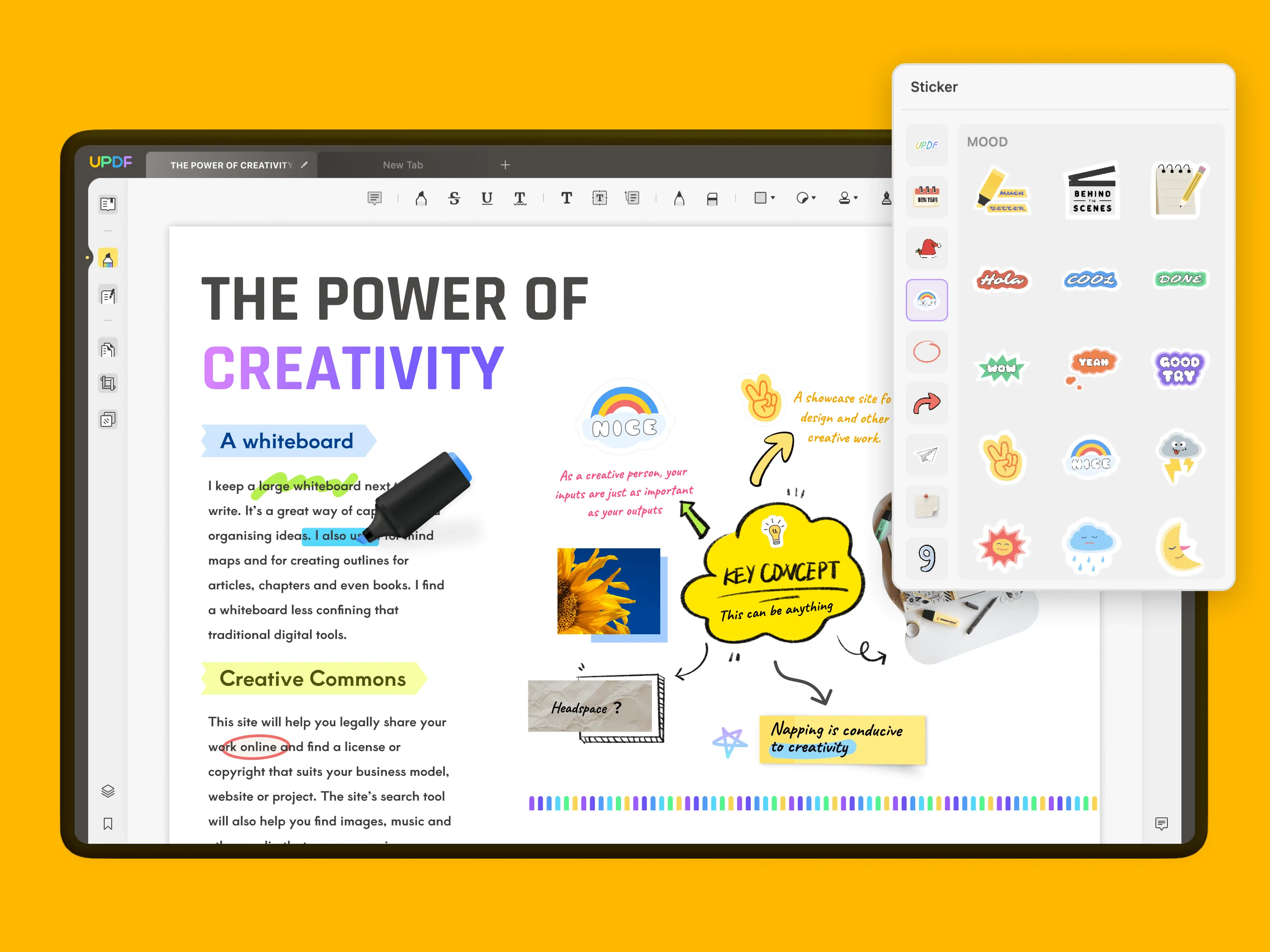
Here's how to use UPDF for note-taking:
1. Select the book you want to read and open it in the UPDF reader and editor.
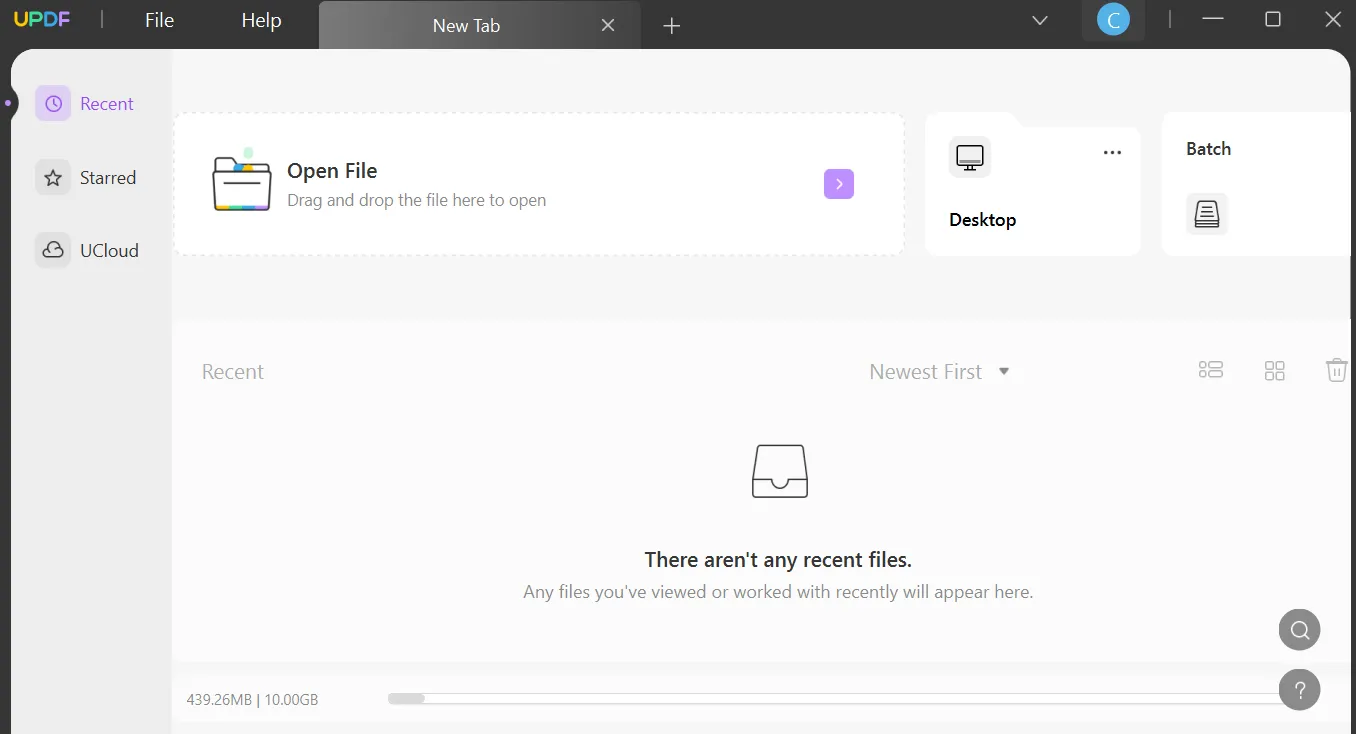
2. Head to the left toolbar and click on the comment or pencil icon.
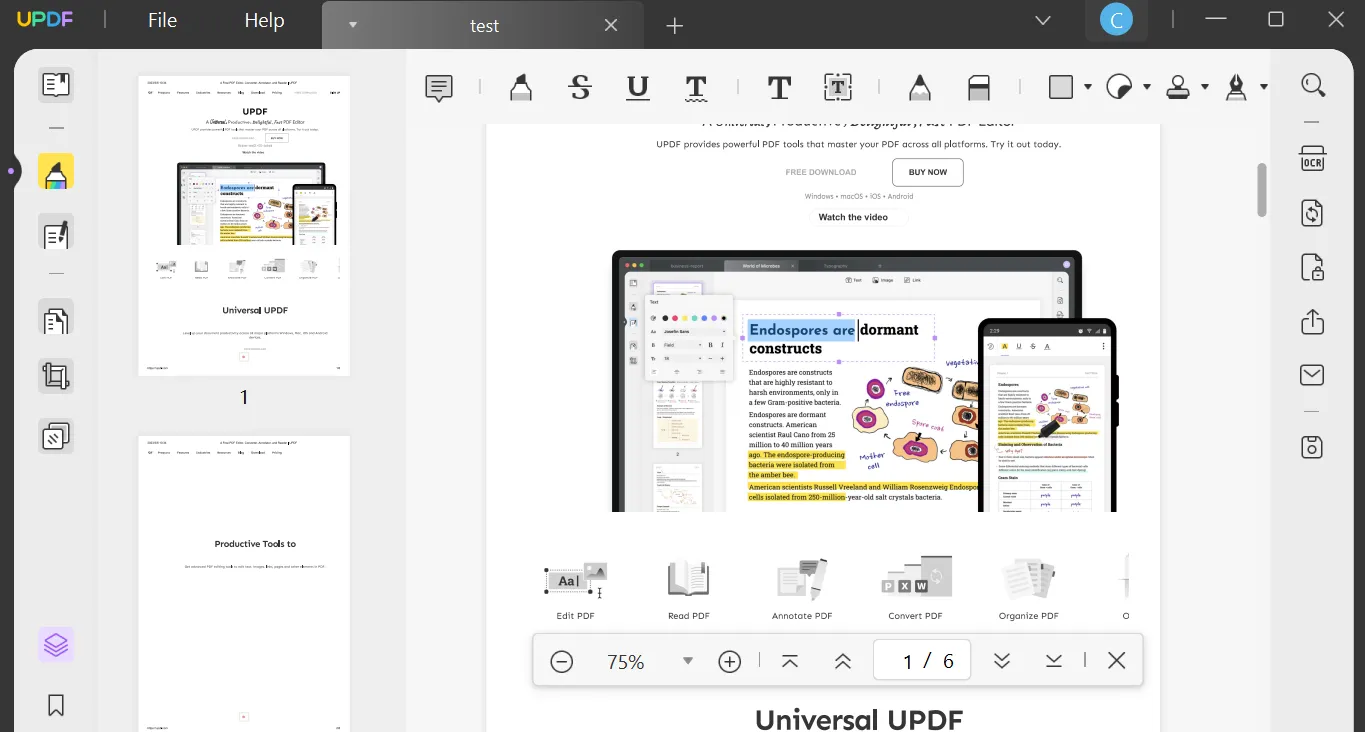
3. Now you can add comments in three ways:
- Text Comment (Typewriter) – add comments in the form of text.
- Text Box – insert a box to write down your thoughts.
- Sticky Note – add a sticky note to mark important points.
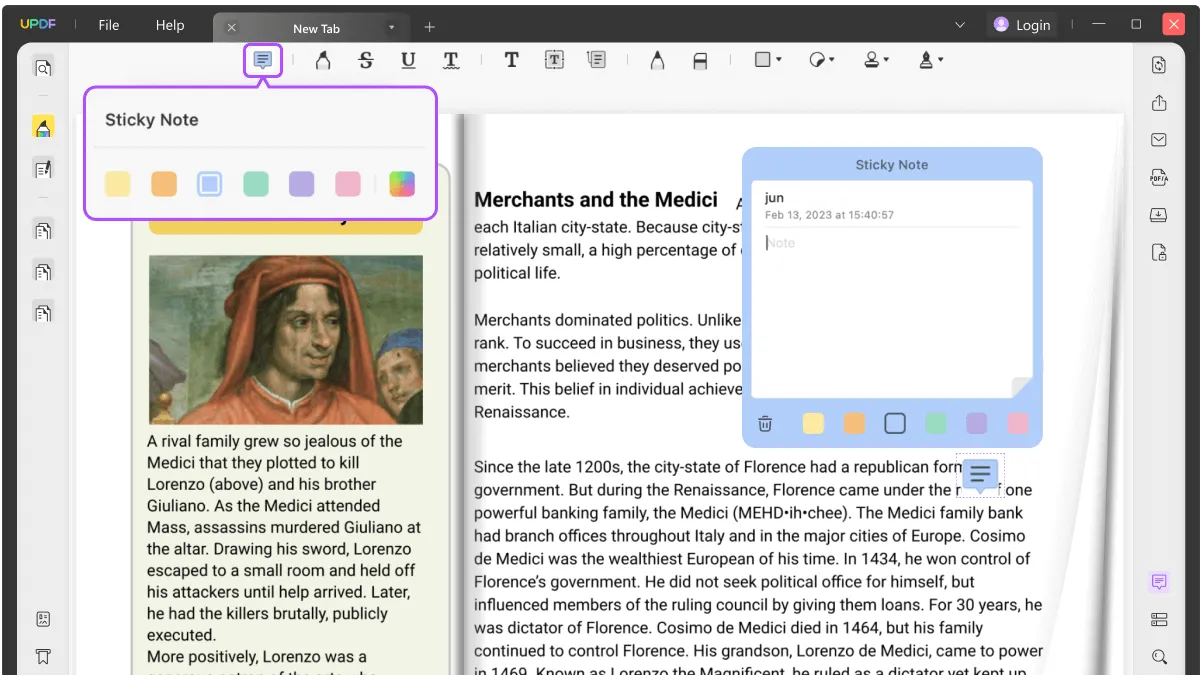
4. Once you have added your comments, click save and you’re done!
By taking notes with UPDF, you can easily refer back to your notes when it's time to write your review. Moreover, you can explore the comments directly.
What I like most about UPDF is that it has AI features that can help me summarize the whole book in seconds, explain the difficult terms for me, and translate the language into the one you can understand.

Why not download UPDF via the below button to make your book review writing much easier?
And UPDF does not only have the features mentioned above. You can know all its features by reading this UPDF review article from Techadvisor or watching the below video tutorial.
Also Read: 5 Best Note-taking Apps for Students
Step 2. Outline the Book Review
Before you start writing your review, it is important to create an outline. This will help you organize your thoughts and identify the main points of your review.
A general outline for a book review should include:
Introduction: Provide an overview of the book and explain its main takeaways.
Summary: Summarize the plot, characters, and themes of the book.
Analysis: Analyze the author's writing style and technique, as well as the book's overall message.
Opinion: Share your personal opinion on the book and any ideas or insights you've gained by reading it.
Final Thoughts: Wrap up your review with a conclusion.
Step 3. Checking Book Reviews Examples
Before writing your own review, it can be helpful to check examples of book reviews. A good example of a book review provides an insightful analysis of what makes the book worth reading, highlighting both its strengths and weaknesses.
As you go through examples, take note of the structure and tone used in each review. You can also take note of any key points in the book that may have been overlooked or not covered.
Reading reviews can help you get a better understanding of the book and gain valuable insights into its content, in preparation for exams or other assignments.
Step 4. Writing the First Draft
Now that you have taken notes and created an outline, it is time to start writing your first draft. As you write, remember to keep the tone of your review professional and unbiased.
Make sure to include in-text citations and a list of any sources you use when relevant, as this will add credibility to your review. Additionally, use language that is easy to understand, and don’t be afraid to inject some of your own thoughts and opinions.
Once you have written the first draft, take a break and come back to it with fresh eyes before revising and editing.
Step 5. Reread The Book Review and Update
Once you have written the first draft of your book review, it is important to reread it and make any necessary updates. Pay close attention to any grammar, spelling, and punctuation mistakes. Additionally, ensure that all the points you mentioned in your review are accurate and true to the book's content.
Finally, make sure you have written in an organized and coherent manner that is easy for the reader to follow.
Writing a book review for college students can seem challenging but with the right preparation and some helpful tips, anyone can craft a great book review. By taking notes when reading, creating an outline before you start writing, checking book review examples, and revising your work after writing the first draft - you can create a thoughtful and insightful review. And we are sure these 10 book review examples for college students will be very helpful to you.
So, the next time you are assigned to write a book review, keep these tips in mind and you will be sure to impress your teacher or professor.
If you're up for a challenge, try using UPDF to take notes and track your progress as you read – it might just give you the extra edge in writing a great book review. Download UPDF via the below button and make your book review easier with it.

Staff Editor
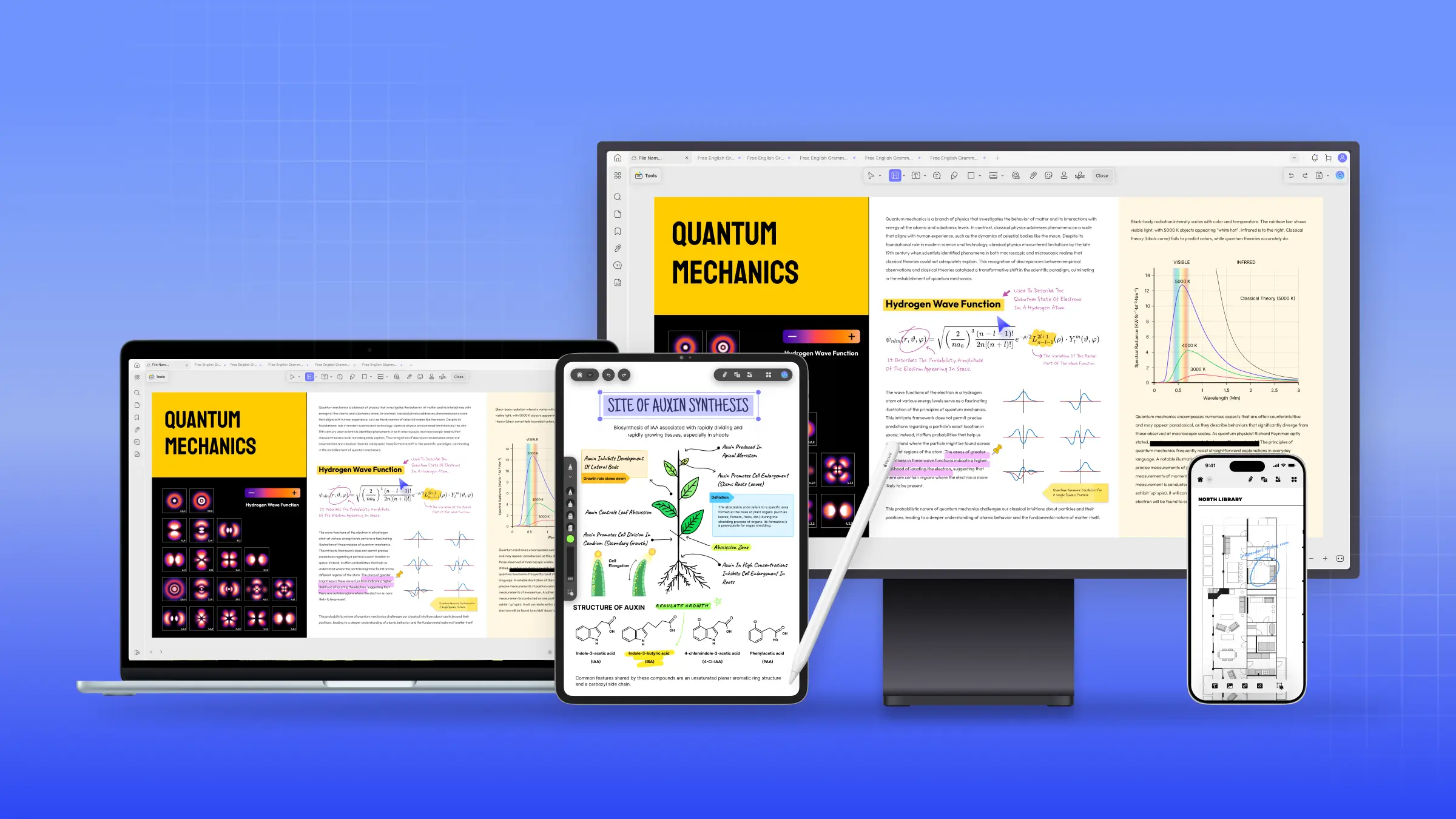
- Liberal Arts College vs. University: Decide What's Better [A Comparision]
- Simple Methods to Write a Good College Application Essay
- Learn The Best Ways How to Read a Graphic Novel
- Learn The Top 4 Free Study Plan Templates for Students
15 Habits of Successful Students: A Useful Guide for Students
- 5 Best Apps for NEET Preparation in 2024
- 13 Best Apps for College Students (Study, Plan, Make Money…)

- Top 5 Exam Preparation Apps to Make Your Study Easier
- How to Survive Finals Week? (The Complete Guide with Tips)
- 16 Funny Finals Memes to Share Your Current Feeling on Social Media
7 Best Apps for Medical Students for Study Assistance and Time Management
- The Best AI App for Students to Boost Their Productivity
- Top 10 Recommended College Essay Books in 2024

Edit, Convert, OCR, Annotate, AI Chat with PDF in One App

- 10 Benefits of College Education That You Need to Know
- How to Improve Your Reading Skills - Useful Tips for Students
- How to Write a Research Paper with These Efficient Techniques
- The Top 14 Must-Learn Profitable Skills for Students
- How to Improve Handwriting as a Student in 8 Steps
Top 15 Recommended Books for College Students

- 5 Best Grad School Essay Examples (With Guide to Write Essay)
- Key to Success in College: 20 Important Tips To Remember
- How to Write a Dissertation? (The Ultimate Guide)
- Discovering The 9 Best Academic Writing Software to Improve Your Writing
- 20 Books to Read Before College [The Ultimate Guide]

- How to Improve Writing Skills for Students? (6 Proven Ways)
- Get Help From ChatGPT to Write College Essays: Know How
- A Guide That Answers How to Write a Body Paragraph in an Essay
- 6 Effective and Best Essay Writing Apps for Students
- Effective Ways on How to Read a Textbook
- How to Become an Online Tutor: A Must Read For Students
- How to Write a Letter of Recommendation for a Student: Learn With Samples

Top 7 Apps for Law Students: A Must Read

11 Popular Productivity Apps for Students in 2024

Join the Partner Program
* Company Name
How can we help?
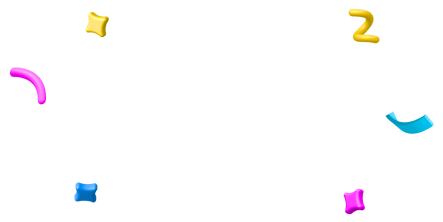
Get limited time coupons !
We use cookies to ensure you get the best experience on our website. Continued use of this website indicates your acceptance of our privacy policy .

How to Write a Book Report
Use the links below to jump directly to any section of this guide:
Book Report Fundamentals
Preparing to write, an overview of the book report format, how to write the main body of a book report, how to write a conclusion to a book report, reading comprehension and book reports, book report resources for teachers .
Book reports remain a key educational assessment tool from elementary school through college. Sitting down to close read and critique texts for their content and form is a lifelong skill, one that benefits all of us well beyond our school years. With the help of this guide, you’ll develop your reading comprehension and note-taking skills. You’ll also find resources to guide you through the process of writing a book report, step-by-step, from choosing a book and reading actively to revising your work. Resources for teachers are also included, from creative assignment ideas to sample rubrics.
Book reports follow general rules for composition, yet are distinct from other types of writing assignments. Central to book reports are plot summaries, analyses of characters and themes, and concluding opinions. This format differs from an argumentative essay or critical research paper, in which impartiality and objectivity is encouraged. Differences also exist between book reports and book reviews, who do not share the same intent and audience. Here, you’ll learn the basics of what a book report is and is not.
What Is a Book Report?
"Book Report" ( ThoughtCo )
This article, written by a professor emeritus of rhetoric and English, describes the defining characteristics of book reports and offers observations on how they are composed.
"Writing a Book Report" (Purdue OWL)
Purdue’s Online Writing Lab outlines the steps in writing a book report, from keeping track of major characters as you read to providing adequate summary material.
"How to Write a Book Report" ( Your Dictionary )
This article provides another helpful guide to writing a book report, offering suggestions on taking notes and writing an outline before drafting.
"How to Write a Successful Book Report" ( ThoughtCo )
Another post from ThoughtCo., this article highlights the ten steps for book report success. It was written by an academic advisor and college enrollment counselor.
What’s the Difference Between a Book Report and an Essay?
"Differences Between a Book Report & Essay Writing" ( Classroom)
In this article from the education resource Classroom, you'll learn the differences and similarities between book reports and essay writing.
"Differences Between a Book Report and Essay Writing" (SeattlePi.com)
In this post from a Seattle newspaper's website, memoirist Christopher Cascio highlights how book report and essay writing differ.
"The Difference Between Essays and Reports" (Solent Online Learning)
This PDF from Southampton Solent University includes a chart demonstrating the differences between essays and reports. Though it is geared toward university students, it will help students of all levels understand the differing purposes of reports and analytical essays.
What’s the Difference Between a Book Report and a Book Review?
"How to Write a Book Review and a Book Report" (Concordia Univ.)
The library at Concordia University offers this helpful guide to writing book report and book reviews. It defines differences between the two, then presents components that both forms share.
"Book Reviews" (Univ. of North Carolina)
The University of North Carolina at Chapel Hill’s writing guide shows the step-by-step process of writing book reviews, offering a contrast to the composition of book reports.
Active reading and thoughtful preparation before you begin your book report are necessary components of crafting a successful piece of writing. Here, you’ll find tips and resources to help you learn how to select the right book, decide which format is best for your report, and outline your main points.
Selecting and Finding a Book
"30 Best Books for Elementary Readers" (Education.com)
This article from Education.com lists 30 engaging books for students from kindergarten through fifth grade. It was written by Esme Raji Codell, a teacher, author, and children's literature specialist.
"How to Choose a Good Book for a Report (Middle School)" (WikiHow)
This WikiHow article offers suggestions for middle schoolers on how to choose the right book for a report, from getting started early on the search process to making sure you understand the assignment's requirements.
"Best Book-Report Books for Middle Schoolers" (Common Sense Media)
Common Sense Media has compiled this list of 25 of the best books for middle school book reports. For younger students, the article suggests you check out the site's "50 Books All Kids Should Read Before They're 12."
"50 Books to Read in High School" (Lexington Public Library)
The Lexington, Kentucky Public Library has prepared this list to inspire high school students to choose the right book. It includes both classics and more modern favorites.
The Online Computer Library Center's catalogue helps you locate books in libraries near you, having itemized the collections of 72,000 libraries in 170 countries.
Formats of Book Reports
"Format for Writing a Book Report" ( Your Dictionary )
Here, Your Dictionary supplies guidelines for the basic book report format. It describes what you'll want to include in the heading, and what information to include in the introductory paragraph. Be sure to check these guidelines against your teacher's requirements.
"The Good Old Book Report" (Scholastic)
Nancy Barile’s blog post for Scholastic lists the questions students from middle through high school should address in their book reports.
How to Write an Outline
"Writer’s Web: Creating Outlines" (Univ. of Richmond)
The University of Richmond’s Writing Center shows how you can make use of micro and macro outlines to organize your argument.
"Why and How to Create a Useful Outline" (Purdue OWL)
Purdue’s Online Writing Lab demonstrates how outlines can help you organize your report, then teaches you how to create outlines.
"Creating an Outline" (EasyBib)
EasyBib, a website that generates bibliographies, offers sample outlines and tips for creating your own. The article encourages you to think about transitions and grouping your notes.
"How to Write an Outline: 4 Ways to Organize Your Thoughts" (Grammarly)
This blog post from a professional writer explains the advantages of using an outline, and presents different ways to gather your thoughts before writing.
In this section, you’ll find resources that offer an overview of how to write a book report, including first steps in preparing the introduction. A good book report's introduction hooks the reader with strong opening sentences and provides a preview of where the report is going.
"Step-by-Step Outline for a Book Report" ( Classroom )
This article from Classroom furnishes students with a guide to the stages of writing a book report, from writing the rough draft to revising.
"Your Roadmap to a Better Book Report" ( Time4Writing )
Time4Writing offers tips for outlining your book report, and describes all of the information that the introduction, body, and conclusion should include.
"How to Start a Book Report" ( ThoughtCo)
This ThoughtCo. post, another by academic advisor and college enrollment counselor Grace Fleming, demonstrates how to write a pithy introduction to your book report.
"How to Write an Introduction for a Book Report" ( Classroom )
This brief but helpful post from Classroom details what makes a good book report introduction, down to the level of individual sentences.
The body paragraphs of your book report accomplish several goals: they describe the plot, delve more deeply into the characters and themes that make the book unique, and include quotations and examples from the book. Below are some resources to help you succeed in summarizing and analyzing your chosen text.
Plot Summary and Description
"How Do You Write a Plot Summary?" ( Reference )
This short article presents the goals of writing a plot summary, and suggests a word limit. It emphasizes that you should stick to the main points and avoid including too many specific details, such as what a particular character wears.
"How to Write a Plot for a Book Report" ( The Pen & The Pad )
In this article from a resource website for writers, Patricia Harrelson outlines what information to include in a plot summary for a book report.
"How to Write a Book Summary" (WikiHow)
Using Harry Potter and the Sorcerer’s Stone as an example, this WikiHow article demonstrates how to write a plot summary one step at a time.
Analyzing Characters and Themes
"How to Write a Character Analysis Book Report" ( The Pen & The Pad )
Kristine Tucker shows how to write a book report focusing on character. You can take her suggestions as they are, or consider incorporating them into the more traditional book report format.
"How to Write a Character Analysis" (YouTube)
The SixMinuteScholar Channel utilizes analysis of the film Finding Nemo to show you how to delve deeply into character, prioritizing inference over judgment.
"How to Define Theme" ( The Editor's Blog )
Fiction editor Beth Hill contributes an extended definition of theme. She also provides examples of common themes, such as "life is fragile."
"How to Find the Theme of a Book or Short Story" ( ThoughtCo )
This blog post from ThoughtCo. clarifies the definition of theme in relation to symbolism, plot, and moral. It also offers examples of themes in literature, such as love, death, and good vs. evil.
Selecting and Integrating Quotations
"How to Choose and Use Quotations" (Santa Barbara City College)
This guide from a college writing center will help you choose which quotations to use in your book report, and how to blend quotations with your own words.
"Guidelines for Incorporating Quotes" (Ashford Univ.)
This PDF from Ashford University's Writing Center introduces the ICE method for incorporating quotations: introduce, cite, explain.
"Quote Integration" (YouTube)
This video from The Write Way YouTube channel illustrates how to integrate quotations into writing, and also explains how to cite those quotations.
"Using Literary Quotations" (Univ. of Wisconsin-Madison)
This guide from the University of Wisconsin-Madison’s Writing Center helps you emphasize your analysis of a quotation, and explains how to incorporate quotations into your text.
Conclusions to any type of paper are notoriously tricky to write. Here, you’ll learn some creative ways to tie up loose ends in your report and express your own opinion of the book you read. This open space for sharing opinions that are not grounded in critical research is an element that often distinguishes book reports from other types of writing.
"How to Write a Conclusion for a Book Report" ( Classroom )
This brief article from the education resource Classroom illustrates the essential points you should make in a book report conclusion.
"Conclusions" (Univ. of North Carolina)
The University of North Carolina at Chapel Hill’s Writing Center lays out strategies for writing effective conclusions. Though the article is geared toward analytical essay conclusions, the tips offered here will also help you write a strong book report.
"Ending the Essay: Conclusions" (Harvard College Writing Center)
Pat Bellanca’s article for Harvard University’s Writing Center presents ways to conclude essays, along with tips. Again, these are suggestions for concluding analytical essays that can also be used to tie up a book report's loose ends.
Reading closely and in an engaged manner is the strong foundation upon which all good book reports are built. The resources below will give you a picture of what active reading looks like, and offer strategies to assess and improve your reading comprehension. Further, you’ll learn how to take notes—or “annotate” your text—making it easier to find important information as you write.
How to Be an Active Reader
"Active Reading Strategies: Remember and Analyze What You Read" (Princeton Univ.)
Princeton University’s McGraw Center for Teaching and Learning recommends ten strategies for active reading, and includes sample diagrams.
"Active Reading" (Open Univ.)
The Open University offers these techniques for reading actively alongside video examples. The author emphasizes that you should read for comprehension—not simply to finish the book as quickly as possible.
"7 Active Reading Strategies for Students" ( ThoughtCo )
In this post, Grace Fleming outlines seven methods for active reading. Her suggestions include identifying unfamiliar words and finding the main idea.
"5 Active Reading Strategies for Textbook Assignments" (YouTube)
Thomas Frank’s seven-minute video demonstrates how you can retain the most important information from long and dense reading material.

Assessing Your Reading Comprehension
"Macmillan Readers Level Test" (MacMillan)
Take this online, interactive test from a publishing company to find out your reading level. You'll be asked a number of questions related to grammar and vocabulary.
"Reading Comprehension Practice Test" (ACCUPLACER)
ACCUPLACER is a placement test from The College Board. This 20-question practice test will help you see what information you retain after reading short passages.
"Reading Comprehension" ( English Maven )
The English Maven site has aggregated exercises and tests at various reading levels so you can quiz your reading comprehension skills.
How to Improve Your Reading Comprehension
"5 Tips for Improving Reading Comprehension" ( ThoughtCo )
ThoughtCo. recommends five tips to increase your reading comprehension ability, including reading with tools such as highlighters, and developing new vocabulary.
"How to Improve Reading Comprehension: 8 Expert Tips" (PrepScholar)
This blog post from PrepScholar provides ideas for improving your reading comprehension, from expanding your vocabulary to discussing texts with friends.
CrashCourse video: "Reading Assignments" (YouTube)
This CrashCourse video equips you with tools to read more effectively. It will help you determine how much material you need to read, and what strategies you can use to absorb what you read.
"Improving Reading Comprehension" ( Education Corner )
From a pre-reading survey through post-reading review, Education Corner walks you through steps to improve reading comprehension.
Methods of In-text Annotation
"The Writing Process: Annotating a Text" (Hunter College)
This article from Hunter College’s Rockowitz Writing Center outlines how to take notes on a text and provides samples of annotation.
"How To Annotate Text While Reading" (YouTube)
This video from the SchoolHabits YouTube channel presents eleven annotation techniques you can use for better reading comprehension.
"5 Ways To Annotate Your Books" ( Book Riot )
This article from the Book Riot blog highlights five efficient annotation methods that will save you time and protect your books from becoming cluttered with unnecessary markings.
"How Do You Annotate Your Books?" ( Epic Reads )
This post from Epic Reads highlights how different annotation methods work for different people, and showcases classic methods from sticky notes to keeping a reading notebook.
Students at every grade level can benefit from writing book reports, which sharpen critical reading skills. Here, we've aggregated sources to help you plan book report assignments and develop rubrics for written and oral book reports. You’ll also find alternative book report assessment ideas that move beyond the traditional formats.
Teaching Elementary School Students How to Write Book Reports
"Book Reports" ( Unique Teaching Resources )
These reading templates courtesy of Unique Teaching Resources make great visual aids for elementary school students writing their first book reports.
"Elementary Level Book Report Template" ( Teach Beside Me )
This printable book report template from a teacher-turned-homeschooler is simple, classic, and effective. It asks basic questions, such as "who are the main characters?" and "how did you feel about the main characters?"
"Book Reports" ( ABC Teach )
ABC Teach ’s resource directory includes printables for book reports on various subjects at different grade levels, such as a middle school biography book report form and a "retelling a story" elementary book report template.
"Reading Worksheets" ( Busy Teacher's Cafe )
This page from Busy Teachers’ Cafe contains book report templates alongside reading comprehension and other language arts worksheets.
Teaching Middle School and High School Students How to Write Book Reports
"How to Write a Book Report: Middle and High School Level" ( Fact Monster)
Fact Monster ’s Homework Center discusses each section of a book report, and explains how to evaluate and analyze books based on genre for students in middle and high school.
"Middle School Outline Template for Book Report" (Trinity Catholic School)
This PDF outline template breaks the book report down into manageable sections for seventh and eighth graders by asking for specific information in each paragraph.
"Forms for Writing a Book Report for High School" ( Classroom )
In this article for Classroom, Elizabeth Thomas describes what content high schoolers should focus on when writing their book reports.
"Forms for Writing a Book Report for High School" ( The Pen & The Pad )
Kori Morgan outlines techniques for adapting the book report assignment to the high school level in this post for The Pen & The Pad .
"High School Book Lists and Report Guidelines" (Highland Hall Waldorf School)
These sample report formats, grading paradigms, and tips are collected by Highland Hall Waldorf School. Attached are book lists by high school grade level.
Sample Rubrics
"Book Review Rubric Editable" (Teachers Pay Teachers)
This free resource from Teachers Pay Teachers allows you to edit your book report rubric to the specifications of your assignment and the grade level you teach.
"Book Review Rubric" (Winton Woods)
This PDF rubric from a city school district includes directions to take the assignment long-term, with follow-up exercises through school quarters.
"Multimedia Book Report Rubric" ( Midlink Magazine )
Perfect for oral book reports, this PDF rubric from North Carolina State University's Midlink Magazine will help you evaluate your students’ spoken presentations.
Creative Book Report Assignments
"25 Book Report Alternatives" (Scholastic)
This article from the Scholastic website lists creative alternatives to the standard book report for pre-kindergarteners through high schoolers.
"Fresh Ideas for Creative Book Reports" ( Education World )
Education World offers nearly 50 alternative book report ideas in this article, from a book report sandwich to a character trait diagram.
"A Dozen Ways to Make Amazingly Creative Book Reports" ( We Are Teachers )
This post from We Are Teachers puts the spotlight on integrating visual arts into literary study through multimedia book report ideas.
"More Ideas Than You’ll Ever Use for Book Reports" (Teachnet.com)
This list from Teachnet.com includes over 300 ideas for book report assignments, from "interviewing" a character to preparing a travel brochure to the location in which the book is set.
"Fifty Alternatives to the Book Report" (National Council of Teachers of English)
In this PDF resource from the NCTE's English Journal, Diana Mitchell offers assignment ideas ranging from character astrology signs to a character alphabet.
- PDFs for all 136 Lit Terms we cover
- Downloads of 1937 LitCharts Lit Guides
- Teacher Editions for every Lit Guide
- Explanations and citation info for 40,835 quotes across 1937 books
- Downloadable (PDF) line-by-line translations of every Shakespeare play
Need something? Request a new guide .
How can we improve? Share feedback .
LitCharts is hiring!

.
, .
, , .
Five-Star Book Reviews
Students create a book review on a card or 3d cube to help others choose books they will enjoy.
Apps: Wixie ® or Pixie ®
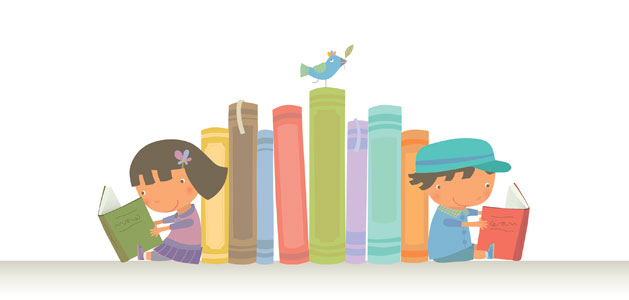
While some emerging readers love any book, others struggle to find books they enjoy reading. In this project, students think about books they have enjoyed reading and why they liked them. They then create a review of one of the books on a card or 3D cube to help others better select a book they will enjoy reading.
Common Core State Standards for primary grades use book reviews as a performance task for primary grade opinion writing. In Kindergarten, emerging writers simply write a sentence to name a favorite book, but first- and second-grade students also supply reasons to support their opinion.
Many emerging readers struggle to find books they like when faced with a library filled with options. Book reviews are a product you can ask young learners to create that not only meets academic goals but has value to their peers as well.
Begin this project by asking your students to name their favorite book that you have read to them this year. As they share their favorites, ask each student to try to articulate specific reasons that made the story great. You can also open this question up to other students who agree that a particular book was enjoyable.
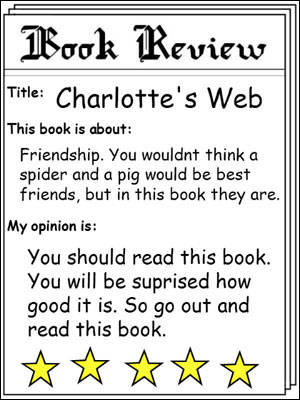
Now, ask students if they have ever had trouble finding a book they like. Then, ask students if they have ever had a friend tell them “You are going to love this book!” but when they read it themselves, they didn’t really enjoy it.
Be sure to acknowledge that not every student likes the same book. Reading is personal and will depend on your interests more than your reading ability. You will also want to try to help students understand that sharing an opinion that is not supported with specific reasons does not provide a reader with a lot of information to make their own decision.
Make your students aware that even adults have problems finding books they enjoy reading. This is why many of them use book reviews as a tool to help them better choose the next book they will read.
Show students an example of a book review, such as ones you find online or print examples from your local paper. These reviews are written for adults, so share an example or two of book reviews written by students as well.
Let students know that they will be writing a review of a book they have enjoyed to help other students learn more about the story and decide if it is a book that they might enjoy reading too.
Have students think of a book they enjoyed reading on their own this year. After students have chosen a title, the next step is to help them move beyond a simple identification of a favorite book, to supplying an opinion about it backed up by reasons and examples in the book.
Provide students with an OREO opinion organizer to help students develop their ideas before they start writing. In this graphic organizer, students state their opinion, such as Mercy Watson to the Rescue is my favorite book. The next part of the organizer asks them to supply a reason for their opinion, followed by an example or two from the book.
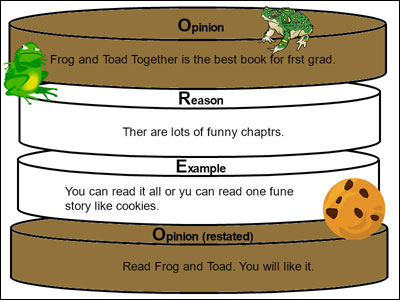
Decide as a class if you want to create reviews you share as posters you will hang on the wall, postcards you will print and share or even 3D cubes students can print on card stock, cut, fold, glue and display.
Provide your students with a book review template they can use to share the ideas they have developed in their OREO organizer.
A digital creativity tool, like Wixie , includes several templates for book reviews, including several that work to print as postcards and trading cards, as well as several 3D cube templates specifically designed for book reviews.

To get your students thinking, you may want to work together to create a list of common elements found in all of the reviews, such as the title of the book, the author’s name, a summary, and an opinion. Then, work with students to decide what should be in their review and design your own Wixie template together for students to use.
Celebrating the work of your emerging writers encourages them to continue their efforts. While displaying their writing is great, show students their writing has value by sharing it with other young learners who will use it to choose their next book to read.
Print two copies of each student’s card or 3D Cube. Share one copy in the reading area or book nook in your classroom and the other in the library media center at your school.
Give student work an even larger audience by reaching out to your local library or independent bookstore to see if they would be willing to share them with their visitors to help them find that just right book.
If your learners are up for more involvement and thinking, ask them to help determine the size and shape their reviews should be shared. While there aren’t a lot of options for a 3D cube, if students wrote single-page reviews, they can print at full-page size and display around school. They can also print multiple copies on a single page at postcard, or even trading card, size.
No matter what format they choose for publishing, ask students to also consider how they will organize the reviews for students to use most effectively. In other words, would sorting the reviews by genre, rating, or theme make the right title even easier for students to find? Instead of giving options for sorting, see if students can come up with these on their own.
You can assess student’s prior experience with opinion writing as you work together to evaluate what makes a good book review.
You may want to create a checklist for the things students need to include in their review, to clearly define the content their review should include.

The OREO opinion organizer provides a great formative assessment opportunity you can use before they begin writing to ensure they understand how to support an opinion with reasons and examples, not simply restate it. Their final book review serves as a summative assessment of their opinion writing progress.
If you involved students in thinking about the product format they should use as well as how they should sort, display, and share their work, be sure to record your conversations and observations to make it easier to describe their thinking in your evaluation.
The Horn Book: Reviews of 2017 Caldecott Award Winners
Spaghetti Book Club: Book Reviews Written by Students
Read Brightly: 30 Books for Early Readers
Common Core State Standards for English Language Arts:
CCSS.ELA-LITERACY.W.1.1 Write opinion pieces in which they introduce the topic or name the book they are writing about, state an opinion, supply a reason for the opinion, and provide some sense of closure.
CCSS.ELA-LITERACY.W.2.1 Write opinion pieces in which they introduce the topic or book they are writing about, state an opinion, supply reasons that support the opinion, use linking words (e.g., because, and, also) to connect opinion and reasons, and provide a concluding statement or section.
ISTE Standards for Students:
6. Creative Communicator Students communicate clearly and express themselves creatively for a variety of purposes using the platforms, tools, styles, formats and digital media appropriate to their goals. Students:
a. choose the appropriate platforms and tools for meeting the desired objectives of their creation or communication.
b. create original works or responsibly repurpose or remix digital resources into new creations.
c. communicate complex ideas clearly and effectively by creating or using a variety of digital objects such as visualizations, models or simulations.
d. publish or present content that customizes the message and medium for their intended audiences.
Lessons by Subject
Language Arts
Social Studies
Lessons by Grade
Get the latest from creative educator.
Creative classroom ideas delivered straight to your in box once a month.
Add me to the Creative Educator email list!
- Hero's Journey Lesson Plan
- Infographics Lesson Plan
- Design a Book Cover Lesson Plan
- Informational text projects that build thinking and creativity
- Classroom constitution Lesson Plan
- Set SMART Goals Lesson Plan
- Create a visual poem Lesson Plan
- Simple surveys and great graphs Lesson Plan
- Embrace action research

Lesson: Animal Riddles
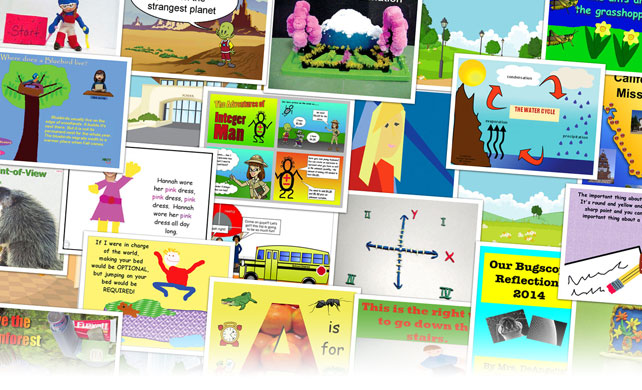
What can your students create?
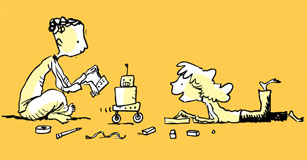
Eight elements of great project design
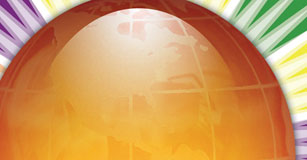
How to write a great authentic task

Lesson: Personification Stories
More sites to help you find success in your classroom

Share your ideas, imagination, and understanding through writing, art, voice, and video.

Rubric Maker
Create custom rubrics for your classroom.

Pics4Learning
A curated, copyright-friendly image library that is safe and free for education.

Write, record, and illustrate a sentence.

Interactive digital worksheets for grades K-8 to use in Brightspace or Canvas.
Professional Learning

Digital Storytelling
21st Century Classrooms
Project-based Learning
Teaching and Learning
Informational Text
English Language Aquisition
Visual Arts
© 2024 Tech4Learning, Inc | All Rights Reserved | Privacy Policy
© 2024 Tech4Learning, Inc | All Rights Reserved | https://www.thecreativeeducator.com
Book Review
Book Review Examples

Book Review Examples: Get Inspiration With 10+ Examples!
Published on: Jun 19, 2023
Last updated on: Jan 31, 2024

People also read
Quick and Easy Guide to Learn How to Write a Book Review
Share this article
Are you eager to enhance your book-reviewing skills?
Writing reviews can be frustrating. You put the effort in, yet feel like you have failed to capture the essence of the book.
But worry no more! To inspire and guide you, we've collected a variety of book review examples from different genres. These examples will show you different writing styles and approaches, giving you plenty of ideas for your own reviews.
So, keep on reading to learn more!
On This Page On This Page -->
Understanding Book Review
A book review is like a detailed analysis and opinion about a book. It's not just a summary; the review talks about the book's strengths, weaknesses, and overall quality .
When you write a review, you'll give an in-depth evaluation of the bookâs writing style. Moreover, youâd be exploring its plot and the characters, the themes, and what impact the book has.
The goal of a book review is to help you decide if a book is worth reading or not. It also encourages discussions and lets people share their thoughts and perspectives.
Book reviews are helpful because they guide readers in choosing books, provide feedback to authors, and inspire a love for reading.

Paper Due? Why Suffer? That's our Job!
A book review for fictional books typically includes an introduction where the book and author are introduced. Mainly for fiction, the plot summary is discussed, without giving away major spoilers.
The reviewer shares their personal opinion and evaluation, expressing what they liked or disliked about the book. It concludes with a recommendation, indicating whether they would suggest it to others.
Here is a review by The New York Times on The Hazel Woods by Melissa Albert:
Here are some more good book review examples on literary and fictional works:
Book Review Examples for High School
Book Review Examples for Grade 6
Book Review Examples for Class 9
Book Review Examples for Class 11
4th Grade Book Review Examples
Book Review Examples for Students
Book Reviews On Non-Fictional Books
To write a book review on nonfiction books, you have to take a different approach compared to reviews of fiction.
It typically begins with an introduction, providing background information about the book and author. The review then includes a concise summary of the content, highlighting the main ideas and arguments.
Non-fiction book reviews aim to inform readers about the content, quality, and significance of the book, helping them make informed decisions and engage in meaningful discussions.
Here are some non-fiction book review examples:
Science Book Review Examples
Academic Book Review Examples
Conclusion of Book Review Examples
How To Write A Good Book Review
Writing a good book review is easier than you might think! Here are some simple tips to help you:
- Read the book carefully: Take your time to read the book thoroughly, paying attention to the book title, the story, the characters, and the writing style.
- Start with a brief summary: Begin your review by giving a short overview of the book, including the main plot points and what it's about.
- Share your thoughts: Feel free to express your opinions and feelings about the book. Did you enjoy it? Was it a powerful story? Be honest in your assessment.
- Discuss the characters: Explore the real-world aspects of the characters and their development. Were they relatable and intriguing to you?
- Highlight the strengths: Identify the book's strong points, such as an exciting plot, beautiful descriptions, or thought-provoking themes.
- Mention any weaknesses: It's okay to point out areas where the book fell short. Maybe the pacing was slow or the ending was unsatisfying. Be respectful but honest.
- Use examples: Support your opinions with specific examples from the book. Quote a favorite passage or describe a scene that impacted you. You can refer to book review templates as well!
- Consider the target audience: Think about who would enjoy this book. Is it suitable for a certain age group or specific interests?
- Wrap up with a recommendation: Based on your review, would you recommend this book to others? Let readers know who might enjoy it.
- Proofread and edit: Before publishing or sharing your review, proofread it for any spelling or grammar mistakes. Make sure your thoughts are clear and well-organized.
Remember, a good book review reflects your honest opinion and helps others decide whether to read the book.
Need to know more about writing a book review? Check out our comprehensive guide on book reviews to learn all about it!
To wrap it up, writing a book review can be a fun and rewarding activity. By following the examples and tips shared in this blog, you can create amazing reviews!
However, if you're still not sure where to start, then we provide essay help for students ! Our review essay writing service can provide original book reviews crafted by experienced professionals.
So hire our essay writing service and let our professionals write excellent book reviews for you! Place your order now!
Caleb S. (Education, Literature)
Caleb S. has extensive experience in writing and holds a Masters from Oxford University. He takes great satisfaction in helping students exceed their academic goals. Caleb always puts the needs of his clients first and is dedicated to providing quality service.
Paper Due? Why Suffer? That’s our Job!

Keep reading

Legal & Policies
- Privacy Policy
- Cookies Policy
- Terms of Use
- Refunds & Cancellations
- Our Writers
- Success Stories
- Our Guarantees
- Affiliate Program
- Referral Program
- AI Essay Writer
Disclaimer: All client orders are completed by our team of highly qualified human writers. The essays and papers provided by us are not to be used for submission but rather as learning models only.
Browse reviews by:
- School/Group
Spaghetti Book Club - Book Reviews by Kids for Kids

A fun & engaging literacy program, committed to
Developing confident readers and writers, learning reading and writing skills through, writing and publishing book reviews, giving kids a place for, sharing insights and opinions with readers around the world, the spaghetti book club is, the largest site of book reviews written and illustrated by kids for kids.

Review of the week
How to help the earth, written by tish rabe.
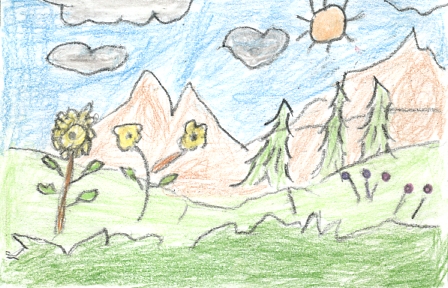
Reviewed by Dev P. (age 6)
The Lorax is sending messages to the children about keeping the Earth clean. He shows them ways to dispose of the trash and how to recycle things. The Lorax tells the children to reuse plastic bags, use both sides of paper, and donate old clothes, toys, ... more
Featured Reviews
After the fall - how humpty dumpty got back up again, written by dan santat.
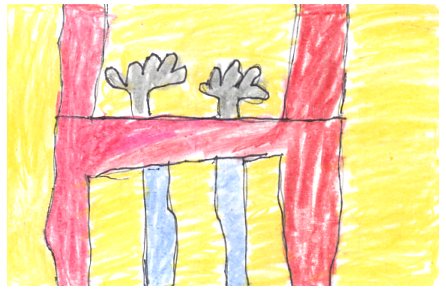
Reviewed by Sebastian E. (age 8), Jack P. (age 7) & Luke P. (age 7)
This book is about Humpty Dumpty who is afraid of heights because he fell off from a big, gigantic wall. We’re sure you’ve heard about it. Humpty Dumpty loved watching birds but because he was afraid of heights he could not go up on the wall and watch ... more
Avocado Baby
Written by john burningham, reviewed by aaron s. (age 6) & william l. (age 7).
There was a family that wasn't very strong and the mom was having a baby. They were expecting it to be stronger, but the baby wasn't very strong. The children decided to give him avocado pear. Every day the baby would eat avocado pear. He got stronger ... more
A Picture Book of Martin Luther King, Jr.
Written by david a. adler, reviewed by logan w. (age 9).
Do you want to learn about Martin Luther King Jr.? If you do, then look for A Picture Book of Martin Luther King, Jr. You will also learn a lot of history from this book. My favorite part in the book is the March on Washington when Martin said these ... more
Abel's Island
Written by william steig.
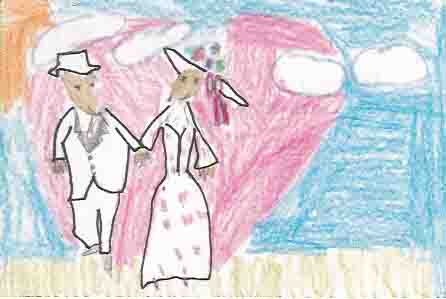
Reviewed by Michelle P. (age 10)
Abel is a mouse who has a wife named Amanda. She is a mouse, too. Abel and Amanda went on a picnic. Abel went to play a joke on Amanda when a hurricane started to form. They left their picnic where it was and started to walk home. Abel and Amanda didn?t have ... more
Esperanza Rising
Written by pam ryan, reviewed by breanna d. (age 10).
From rags to riches! Esperanza is a loving and rich 13-year-old girl. She lives with her Mama, Papa, Abuelita and many servants on a ranch in Mexico. Esperanza's life seems to be perfect. However an unbelievable event tears her family apart. In the beginning ... more
We're Going on a Bear Hunt
Written by michael rosen, reviewed by rachel 1 (e. k.) (age 6) & ray a. (age 7).
Four kids went on a bear hunt with a man. They said they're not scared. We think it is funny because they go through all sorts of things. They fall in all kinds of things like a river and a mud puddle and a forest and other things. Every time the four kids ... more
The Black Pearl
Written by scott o'dell.

Reviewed by Marissa B. (age 10)
The book, The Black Pearl, is about a man named Senor Salazar and his son Ramon Salazar. Senor Salazar owns a pearling business where they go scuba diving for pearls. When Ramon goes to the lagoon on business, he ends up going after the pearls--against ... more
Hiccups for Elephant
Written by james preller.
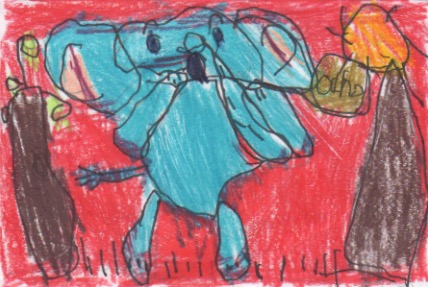
Reviewed by Justin T. (age 7)
“Hiccup!” “Hiccup!” This book is about an elephant that gets the hiccups and wakes up the other animals that are his friends and they try to cure the hiccups, but it doesn’t do it. They tell him to drink a lot of water really fast. They tell ... more
Staying Nine
Written by pam conrad.
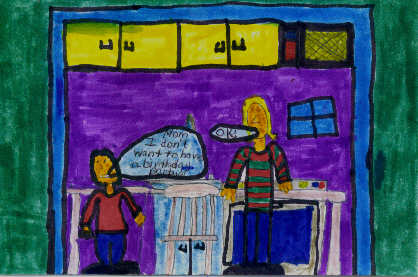
Reviewed by Zishan Q. (age 11)
Staying Nine is about a girl named Heather. She wants to be nine years old forever and doesn't want to change. She didn't want to have a birthday party because she thought she could stay nine if she didn't have a party. One day Heather looked at ... more
Valentine's Day Disaster
Written by geronino stilton.
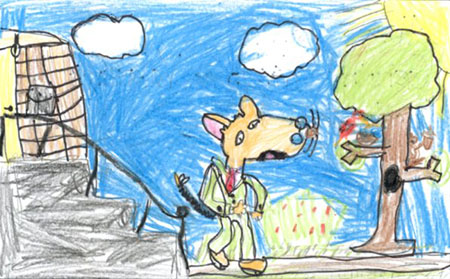
Reviewed by Abby H. (age 7)
Geronimo Stilton is the main character in the story. One day Geronimo wakes up. He was so busy the night before setting up decorations that he forgot to set his alarm. So, on Valentine’s Day he he sleeps in and he’s late for work. That might not seem so ... more
Risky Friends
Written by julie anne peters, reviewed by haley c. (age 10).
Kacie Shannon thinks she's going to have a bad day and wonders if things could get any worse. Just then she spills grape juice on her new white silk blouse. Now she's sure it's going to be a horrible day! Problems start when Skye Collinsworth, her least ... more
So You Want to Be President?
Written by judith s. george, reviewed by brandon a. (age 8) & steven h. (age 9).
Being President is hard, but picture yourself as president and having your own swimming pool, movie theater, and bowling alley in your home! This is a book about past presidents and what their life was like while living in the White House. The book is hilarious ... more
George Washington's Mother
Written by jean fritz, reviewed by lindsey e. (age 8).
Hey! This book is awesome. It is about George Washington's mom, and a little bit about George. Mary had to raise five kids on her own after her husband died. Mary doesn't want George to get hurt in the war. She begs him not to go, but he's twenty-one ... more
Amelia's Notebook
Written by marissa moss, reviewed by stacey f (age 10).
This book is about a girl named Amelia. Her mom brought her a notebook. They were going to a new house to move but Amelia did not think it was a good idea because she liked her old house. When they go to the new house they stop in all kinds of restaurants ... more
The Snowy Day
Written by ezra jack keats.
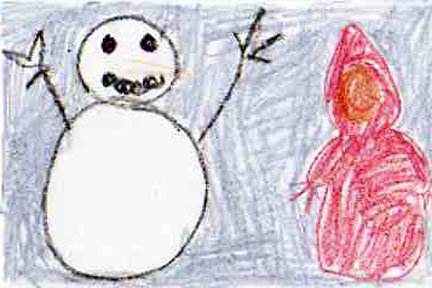
Reviewed by Kaytlin M. (age 6)
The Snowy Day is a picture book about a little boy who wakes up one day and looks out his window and sees lots and lots of snow. He is so excited and after he eats his breakfast, he gets into his snowsuit and goes outside to play in the snow. He doesn't have ... more
The Big Pets
Written by lane smith, reviewed by marley s. (age 8), samantha b. (age 7) & evan d. (age 8).
The Big Pets is about a girl and her humongous cat. Together they went to the milky pools and after when the girl comes out, the cat would lick her feet. They joined other kids and go to other places like Scratching Post Forest and String Vine city and a milky ... more
The Catcher in the Rye
Written by j.d. salinger.

Reviewed by Sam L. (age 14)
A young Holden Caulfield, fresh from being kicked out of prep school, thinks that he is an adult. After wondering around New York City for days, however, he begins to think otherwise. He feel lonely without his friends from school. When he sneaks into his ... more
Written by Hans Wilhelm
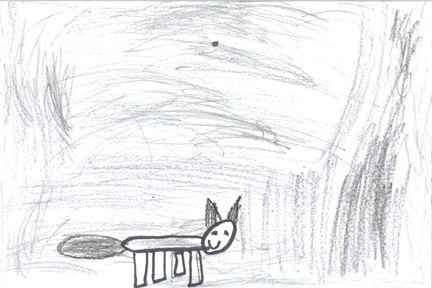
Reviewed by Donovan J. (age 6)
If you wander off from your parent or if you go somewhere that you have not told your parents about, you might get lost. This book helps you with a way to find your way back home. I think the author was trying to help us with being lost. I liked this ... more
All About Sam
Written by lois lowry.
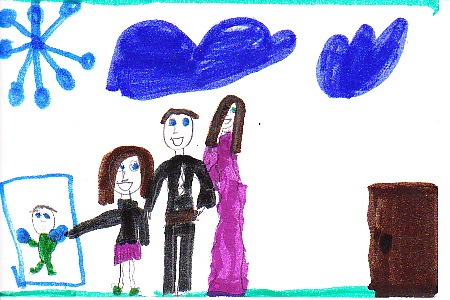
Reviewed by Amelia G. (age 9)
Do you have a younger brother or sister? If you do, you should consider reading this book. In this book there is a silly little boy named Sam that really doesn’t get the world and does silly things. Sam’s sister, mom and dad don’t really get him either. ... more
Carl and the Meaning of Life
Written by deborah freedman.
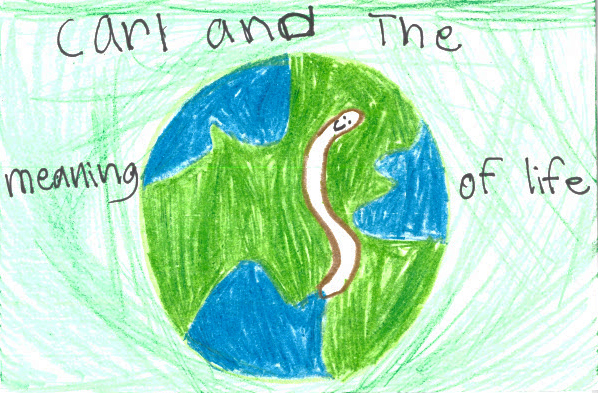
Reviewed by Ryan A. (age 9), Jack P. (age 8), Sebastian E. (age 9) & Hudson B. (age 9)
Have you ever wondered why you are here? We all have meaning in our life. This book is about an earthworm named Carl that wants to know the meaning of his life. He wants to know why he does what he does and why he’s here. He goes and asks all the animals ... more
Wilma Unlimited
Written by kathleen krull.
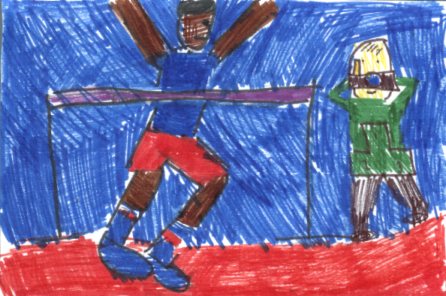
Reviewed by Brewer A. (age 9)
Have you ever given up on yourself? If you have then Wilma Rudolph is not like you. Wilma was a small young girl when at the age of 4 she was diagnosed with polio and scarlet fever. Her leg was paralyzed. That did not stop Wilma. One Sunday, the Rudolphs were ... more
Thanksgiving Cats
Written by jean marzollo.
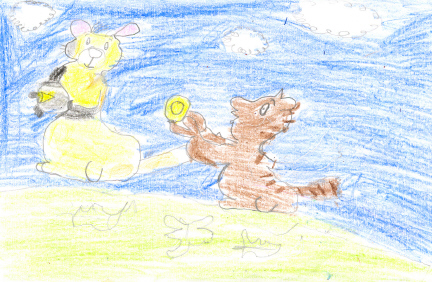
Reviewed by MB5 (age 11)
In this story, cats grew corn, potatoes, peas, pumpkins and apples. They got milk from cows to make cheese and butter. They also made bread. The cats cooked some food and ate it. Then they took a nap and rested because they were so full and tired. When ... more
Written by Kathryn Stockett
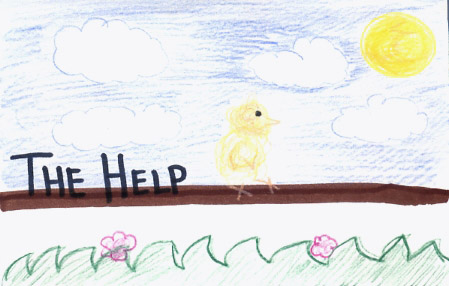
Reviewed by Lauren P. (age 14)
The Help by Kathryn Stockett is about the black maids and white employers in Jackson Mississippi. This novel covers the racist and segregated ways of Jackson during the 1960’s . Ms Skeeter Phelan (a 23 year old white female) decides, in order to pursue her ... more
Don't Let the Pigeon Drive the Bus!
Written by mo willems, reviewed by zachary p. (age 5).
This is a very funny story about a pigeon who really wants to drive the bus. All he could think about was driving the bus. He says "please" and cannot stop thinking about getting to drive the bus. He keeps making funny faces as he tries to get ... more
Abuela's Weave
Written by omar s. castaneda.

Reviewed by Ivan A. (age 10)
Once upon a time a girl named Esperansa was helping her grandma make clothes for la fiesta del pueblo (the town's party). Esperansa and her grandma worked day and night. The day came and Esperansa had to go to the town. She got on the bus, but when she ... more
Tending To Grace
Written by kimberly fusco.
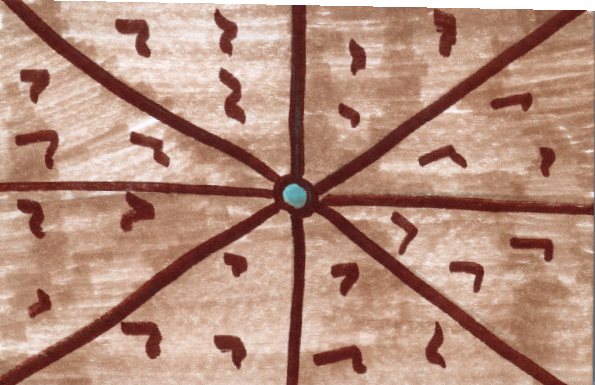
Reviewed by Mecca J. (age 14)
Cornelia Thornhill's world seems to be slowly closing in on her. Problems from her past permanently damage her ability to show her inner-self and to express any feelings toward the world. In her mind she's a "bird tethered to the ground." With her ... more
"Here I Am!" said Smedley
Written by simon puttock, reviewed by jackson g. (age 8).
Smedley is a chameleon who is very shy and is almost always blending in. Then there is a new girl in class named Sally Skinky. She tells Smedley that he could enter the Big City Art Exhibition and win the big prize! You'll have to read the book to see what ... more
The Littles Get Trapped
Written by john peterson.
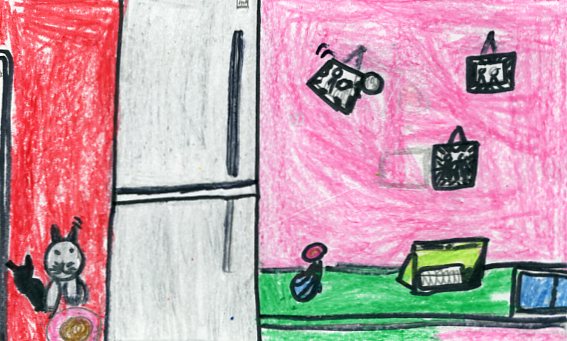
Reviewed by Yandeiris D. (age 9)
Imagine being only six inches tall! In this book The Littles are a family that is very small and they live in a house with humans called the Biggs. The Biggs don't know that the Littles live in the house. Tom and Lucy feel sorry for the Biggs cat because ... more
Smoke Screen
Written by amy goldman koss.
Reviewed by Lyndsay L. (age 11)
Have you ever told a big lie that keeps getting bigger and bigger? The girl in Smoke Screen did. It all started with a piece of cotton. Instead of telling the truth about her watery eye to the boy she has a crush on, Mitzi tells a lie about her mom that grows ... more
Here Comes the Strikeout
Written by leonard kessler.
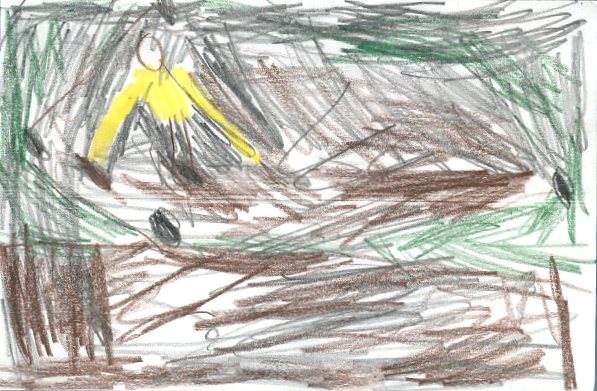
Reviewed by Casey B. (age 7)
This story is about working hard every day. Bobby is a baseball player. He strikes out 21 times. Willy gives Bobby a bat to help him. Bobby begins to cry at home, so Willy helps him with his hitting. Bobby works hard and gets the game winning hit. My ... more
Written by David Green Burg
Reviewed by Armani B. (age 9)
Bugs is a funny book by David Greenburg. It is funny because it has people riding on spiders and jumping on spider webs as a jump house. The book Bugs shows things that you will never see a bug do in the real world. This book includes different types of bug. ... more
Military Planes: Flying Machines
Written by kelly baysura, reviewed by eiji r. (age 8).
The book Military Planes is about when the first war planes were made. In World War 1, the observer who sat in the back of the plane had to watch for enemy planes. Some planes had only one seat and others had two. There were many different kinds of war ... more
Angel in Charge
Written by julie delton, reviewed by gigi y. (age 10).
Do you believe a ten year old girl can be in charge of her brother and the house independently while her mother is away? An interesting fiction book Angel in Charge will tell you more about lovable siblings. Angel, a ten-year old girl, lived with her ... more
Anastasia at Your Service
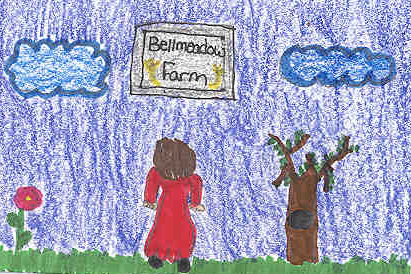
Reviewed by Shae D. (age 10)
Anastasia at Your Service! The book that I read was Anastasia at Your Service. It was about a girl named Anastasia, of course. Anastasia wanted something very badly, but her parents said that from now on when she wanted something, she had to earn it. Anastasia ... more
The Girl Who Hated Books
Written by manjusha pawagi, reviewed by jamie l. (age 8) & duval m. (age 8).
This book is about a girl who hated books. Her name is Meena. There are books all over her house! Her parents read and read and READ! But Meena always said, "...I HATE BOOKS!" One day Meena called for her cat, Max. He didn't come, so she went ... more
Down On The Funny Farm
Written by p.e. king.
Reviewed by Matthew T. (age 6) & Courtney L. (age 7)
We picked this book because it looked funny. The story is about a farmer. The farmer said hello to the old man and then the old man sold a farm to him. The farmer went to the farm. The animals on the farm are acting like other animals. The chicken acts ... more
Henry and Mudge Take the Big Test
Written by cynthia rylant.
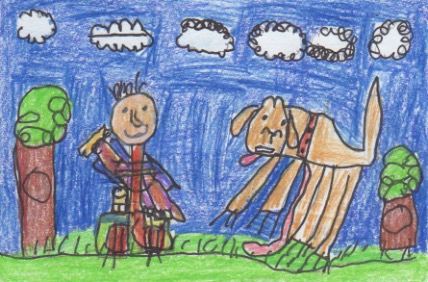
Reviewed by Raphael D. (age 6)
This book is about Henry and Mudge. Mudge is Henry’s 180-pound dog. Mudge wasn’t such a good listener, so Henry decided to send Mudge to day school. Henry got the idea from another man walking down the street with his dog. Henry tried to train Mudge, but ... more
Little Bulldozer
Written by beverly randell, reviewed by v.s. (age 7).
The Little Bulldozer went to look at the fire engine. The fire engine told him to go away. Little Bulldozer went away. He went to look at a big truck. He told the big truck that he likes helping. The big truck told him to go away. Everyone thought he was too ... more
My Louisiana Sky
Written by kimberly holt.
Reviewed by Emma G. (age 10)
"My Louisiana Sky" is about a girl named Tiger. But before I say anything you must know that Tiger's parents are mentally challenged and they are always embarrassing her. She is named Tiger because when her mom was little she had a cat named Tiger. ... more
Bat in the Waiting Room
Written by elana arnold.
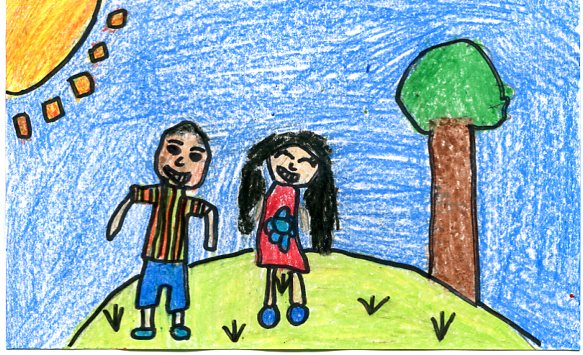
Reviewed by Gabrielle L. (age 10)
Do you like fiction books? Then you would like a wonderful book called Bat and the Waiting Game it is about an autistic kid named Bixby Alexander Tam, also known as "Bat". He has a baby skunk has a pet named Thor. Bat has an older sister "Janie" but when ... more
Chasing Redbird
Written by sharon creech, reviewed by miranda p. (age 10).
Zinnia (Zinny) Taylor is an ordinary 13 year old girl who is just getting over her Aunt Jessie's death. When she uncovers an old and lost trail, she knows that looking for this trail is her new summer project. Working on the lost trail gave Zinny a place all ... more
How to Make Four Million Dollars by Next Thursday
Written by stephen manes.

Reviewed by Emily M. (age 9)
"Can a book really teach you how to make four million dollars by next Thursday?" Jason Nozzle thought so one day when he was walking home from school. He reached into his pocket and found that he had lost his allowance money! He searched EVERYWHERE ... more
Beezus and Ramona
Written by beverly cleary.
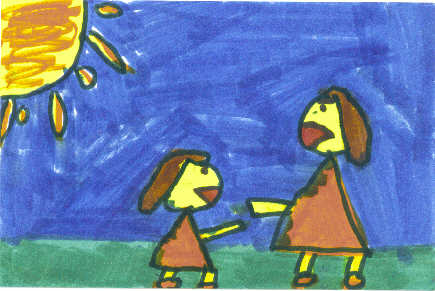
Reviewed by Olivia N. (age 9)
This book is so good I would give it four thumbs up! It is a funny book because Ramona is an impossible little sister and she ruins everything. The story is about two sisters fighting all through the book. Ramona is always getting on Beezus's nerves. ... more
Reviews by Grade
K-1 (ages 5-7).
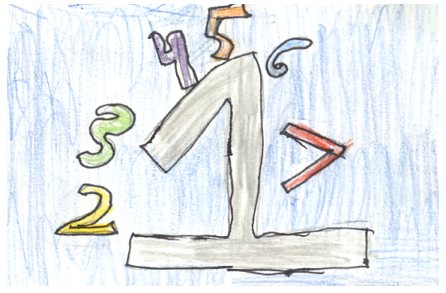
2-3 (ages 7-9)

4-5 (ages 9-11)
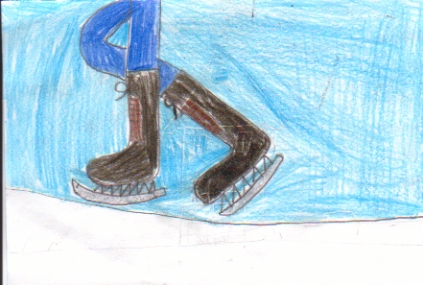
6-9 (ages 11-14)
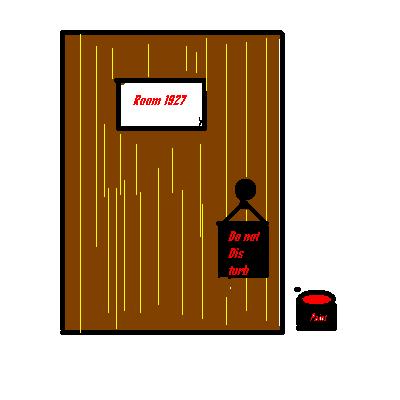
Featured Members
Ms. ragosta's 3rd grade class, pelham, ny, us.
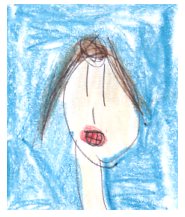
Testimonials
“I used this program with some of my students who are struggling readers. They were thrilled to see their review and felt ...” more
“I get the feeling that Spaghetti Book Club is run by caring people who love reading, and who want children to love reading too!” more
“My first graders became enthusiastic writers and artists once they saw reviews online...” more
Elementary Student Book Reviews - Reviews Written By Students
- Categories : Fun activities & crafts for grade school
- Tags : Teaching grades pre k to 5
Book Review Purpose
There are many purposes for writing elementary student book reviews. One purpose would be for a librarian or teacher to discreetly gather information on student likes and dislikes in reading materials so that they may increase these items in the library and classroom library.
Another would be to facilitate student self-expression and evaluation and critiquing skills.
Having to think about what they have read enough to describe it, summarize it and then determine its value will also help foster comprehension and retention skills. Reading books they like will encourage them to read more, and telling their friends about the books they like will encourage their friends to read more which ultimately leads to an increase in vocabulary and other valuable tools.
Before the Review
Before writing, the children must be exposed to different literary genres so that they know what they are looking for when reading. If the book is non-fiction, for example, the student would need to look for evidence of citations and sources for factual information. A book that doesn’t have this, might not be a very reliable book for information, which would need to be noted in their review.
Fiction books on the other hand, would lead to more flexibility and creativity. Students would look for whether or not they could follow the plot and if it maintained their interest throughout. They would need to ask themselves whether they would read it again, if they would read the next book in the series or recommend it to a friend.
Student Expectations
Students should be able to briefly summarize the book in their review without revealing an ending that would spoil it for the next reader. The purpose of the review is not to give the ending away, but to encourage or discourage someone else to read it. They will need to know persuasive writing techniques and justify their opinions, possibly connecting the book to their own lives. They should also discuss the purposes the book might serve such as helping children understand how it feels to be different, or how to practice safety when having an adventure.
Teachers will need to set up the purpose of the student book reviews and help the students come up with a class rating system that they will all understand. They can use the four star technique or create their own, but their review must match their rating of the book. Most of all, they must be told that a book review is an expression of their opinion, not fact. Their opinion will only be valued if it can be justified, and can only be justified if they have given it real thought. They can only give it real thought if they have really read the book. Their opinions have power if they know how to use them.
Common Sense Media
Movie & TV reviews for parents
- For Parents
- For Educators
- Our Work and Impact
Or browse by category:
- Get the app
- Movie Reviews
- Best Movie Lists
- Best Movies on Netflix, Disney+, and More
Common Sense Selections for Movies

50 Modern Movies All Kids Should Watch Before They're 12

- Best TV Lists
- Best TV Shows on Netflix, Disney+, and More
- Common Sense Selections for TV
- Video Reviews of TV Shows

Best Kids' Shows on Disney+

Best Kids' TV Shows on Netflix
- Book Reviews
- Best Book Lists
- Common Sense Selections for Books

8 Tips for Getting Kids Hooked on Books

50 Books All Kids Should Read Before They're 12
- Game Reviews
- Best Game Lists
Common Sense Selections for Games
- Video Reviews of Games

Nintendo Switch Games for Family Fun

- Podcast Reviews
- Best Podcast Lists
Common Sense Selections for Podcasts

Parents' Guide to Podcasts

- App Reviews
- Best App Lists

Social Networking for Teens

Gun-Free Action Game Apps

Reviews for AI Apps and Tools
- YouTube Channel Reviews
- YouTube Kids Channels by Topic

Parents' Ultimate Guide to YouTube Kids

YouTube Kids Channels for Gamers
- Preschoolers (2-4)
- Little Kids (5-7)
- Big Kids (8-9)
- Pre-Teens (10-12)
- Teens (13+)
- Screen Time
- Social Media
- Online Safety
- Identity and Community

Real-Life Heroes on YouTube for Tweens and Teens
- Family Tech Planners
- Digital Skills
- All Articles
- Latino Culture
- Black Voices
- Asian Stories
- Native Narratives
- LGBTQ+ Pride
- Best of Diverse Representation List

Celebrating Black History Month

Movies and TV Shows with Arab Leads

Celebrate Hip-Hop's 50th Anniversary
Ratings and reviews parents trust.

The Garfield Movie
Legendary cat's animated adventure has peril, lots of ads.

Poignant fantasy about loss and the power of imagination.

Sex, nudity, smoking in sumptuous, diverse period drama.

Jurassic World: Chaos Theory
Tween adventure features fun, friendship, ferocious dinos.

Our Editors Recommend

TV Shows with LGBTQ+ Characters and Leads
Role models, inspirational stories, laughs, and more.

Movies with LGBTQ+ Characters
Movies with lesbian, gay, bisexual, transgender, or other queer-identifying characters.

Movies and TV Shows That Capture Latino LGBTQ+ Experiences
Explore the multifaceted experiences of LGBTQ+ Latinos.

Common Sense Selections

Robot Dreams

Young Woman and the Sea

HAIKYU!! The Dumpster Battle

Popular with Parents

52 parent reviews
"Best kids movie I’ve seen in years."

5 parent reviews

The Fall Guy
12 parent reviews
40 parent reviews

Ordinary Angels
6 parent reviews

Know you're making the best possible choices for your kids.
Since 2003, Common Sense has been the leading independent source for media recommendations and advice for families.
Wherever your family likes to stream or shop, we're here for you.
Look for us next time you're searching for something to watch, read, or play.

Not-for-profit partnerships, generous foundation support, and contributions from parents like you keep Common Sense free and available to families everywhere.
What is the 'best' children's book? Kids, parents and authors on why some rise to the top

What was your favorite book as a kid?
That question makes for a surprisingly effective icebreaker. You can tell a lot about someone from the books they read as a child. Case in point: I’m a journalist, a talker, a storyteller. Many of my childhood favorites had equally yappy and imaginative characters – “Junie B. Jones” by Barbara Park, “Olivia” by Ian Falconer, “Lilly’s Purple Plastic Purse” by Kevin Henkes.
The stories we read at bedtime seldom stay there . Here’s what parents, booksellers, authors and – most importantly – kids told me about what makes the best children’s book.
What makes the best children’s book?
Reading is subjective, of course. But in the quest for the “best” children’s books, parents should look out for a story that’s as entertaining to them as it is to their kids.
Check out: USA TODAY's weekly Best-selling Booklist
“The secret to a really successful picture book is a picture book that both the parent and child can each enjoy on their own level,” says Peter Glassman, the owner of children’s bookstore “Books of Wonder” in New York City.
At a minimum, you have to make sure it’s a book you’re willing to read over and over.
“Sometimes I view children’s book authors as parenting partners where they’re like ‘This book is for the kid, but I’m going to make sure there’s a joke in here for you,'" said Tocarra Mallard , a TV writer from New York and a mother of two who makes TikToks about children’s books.
A good children’s book may teach kids about colors or numbers, but the best children's books can give them a voice to process and experience emotions.
In “The Pout-Pout Fish” by Deborah Diesen, a favorite in Mallard’s house, an act of acceptance helps turn a frown upside down. It has a silly, catchy rhyme that makes her 2-year-old laugh , but also a lesson for her 5-year-old that it's OK to feel blue sometimes. Kids aren't just kids – they're small people who live in a world that can foster anxiety, depression and other complicated feelings," Mallard says.
“For us to pretend that children (exist in) light and love and goodness at all times is denying them their humanity,” she says.
In their words: Kids tell us what makes a good book
Sometimes, finding the “best” book for your kid is just about knowing your kid. Some children want a picture-heavy book while others, like Mallard's son, who is autistic and hyperlexic, need a strong story with lots of words.
I spent the day at “Books of Wonder” earlier this spring to ask kids what makes the best children’s book.
Iago and Nico Akerman, both 11, told me the books they liked reading in school were about human history, how money works and agriculture in Latin America. Reading is a tool for the brothers to help decode the world around them.
Valerie Song, 8, also loves to learn through reading. It “helps your brain grow,” she told me.
She’s drawn to series because she’s a speed reader – and they help her feel connected to characters. Valerie was reading the last "Harry Potter" book when we spoke. Fantasy books can help you “go anywhere you want,” she said. As for everyday adventures, “I get enough of that in real life,” she reported.
Frog and Toad are everywhere: How 50-year-old children's characters became Gen Z icons
What makes an award-winning children’s book?
A captivating story is the foundation for an award-winning book, says Shannon DeVito, the senior director of books at Barnes & Noble, which hosts an annual “Children’s and YA Book Awards.” Witty characters and dynamic illustrations aren’t powerful if there isn’t a story that inspires young readers to keep reading, she says.
But beyond that, a book should have characters or lessons that young readers can identify with. Last year’s overall winner was “ The Swifts: A Dictionary of Scoundrels ” by Beth Lincoln, a chapter book with a vibrant cast of characters. This year’s winner, “ A Royal Conundrum (The Misfits ) ” by Lisa Yee, is described by Barnes & Noble as a book for anyone who has ever felt like an outsider.
One pair of young sisters I spoke to at Books of Wonder, 3-year-old Azadeh and 5-year-old Arya Hashemi-Sohi, love “Saffron Ice Cream” by Rashin Kheiriyeh because one of the characters is named Azadeh. The sisters are half Persian, so their mom, Jeunelle Cunningham, told me they keep an eye out for books with Persian characters.
Glassman has been a bookseller for decades and says it excites him to see different childhood experiences represented in books.
“ Max and the House of Spies” by Adam Gidwitz , for example, is a story he wished he had growing up. It follows a Jewish boy living in London after leaving Germany during World War II. Max has red hair and freckles, just as Glassman did when he was growing up.
Children’s books have gotten more diverse, both in the authors and the characters they write. A 2022 breakdown from the Cooperative Children’s Book Center noted 40% of books published in 2022 and received by the CCBC were by authors of color. On the other hand, an analysis of award-winning children’s books showed white characters are overrepresented .
“A good book that talks about modern culture, (and has a) diverse cast of characters is better than something that doesn’t,” DeVito says.
How to write a children’s book
Author Dan Gutman knows a thing or two about writing successful children’s books. His “My Weird School” books have sold over 35 million copies and he published the series’ 100th book earlier this year.
His secret sauce? Target the kids who don’t like to read. He focuses on short chapters and paragraphs, a linear, easy-to-follow storyline and, his personal favorite, “grown-ups doing dumb things.”
“I wasn’t a big reader myself, I relate really well to kids, especially boys, who don’t like to read,” Gutman says. “My goal is that that kid will open up one of my books and an hour later look up and think ‘Wow, that didn’t even feel like I was reading. I felt like I was watching a movie in my head.’”
That feeling is what Glassman looks for in a book as well. “I go to a book not to be impressed with someone’s writing – which sometimes I am – but I go to a book for the story. I love story, that is my great love,” he says.
Advertisement
Supported by
editors’ choice
6 New Books We Recommend This Week
Suggested reading from critics and editors at The New York Times.
- Share full article
Monday is Memorial Day, when Americans pause to remember those who have lost their lives in the country’s wars, and if that somber occasion puts you in the mood to think about global politics and foreign policy, this would be a good weekend to settle in with “New Cold Wars,” in which my Times colleague David E. Sanger and his collaborator Mary K. Brooks evaluate the current state of tensions among China, Russia and America.
Elsewhere, we also recommend new fiction from Colm Tóibín, Juli Min and Monica Wood, along with a biography of the groundbreaking transgender actress Candy Darling and a book of photos by the incomparable Corky Lee, documenting moments in Asian American life. Happy reading. — Gregory Cowles
NEW COLD WARS: China’s Rise, Russia’s Invasion, and America’s Struggle to Defend the West David E. Sanger with Mary K. Brooks
In this compelling first draft of history, Sanger reveals how a generation of American officials have grappled with dangerous developments in great war competition, from the war in Ukraine to the technological arms race with China.

“Vividly captures the view from Washington. But, as Sanger makes clear, … the fate of the U.S.-led order rests more than ever on the ideas, beliefs and emotions of people far outside the Beltway.”
From Justin Vogt’s review
Crown | $33
LONG ISLAND Colm Tóibín
More than a decade after Tóibín introduced us to Eilis Lacey, the finely wrought Irish émigré heroine of his novel “Brooklyn,” he’s conjured her again, this time as a married mother whose suburban New York life is disrupted by a crisis that propels her back to Ireland once more.

“Eilis is hardly passive. She is an interesting and vivid character because she manages to make her destiny her choice. … In her own mind, and in the eyes of sympathetic readers, she is free.”
From A.O. Scott’s review
Scribner | $28
SHANGHAILANDERS Juli Min
Min’s debut is a sweeping story, told in reverse. The novel opens in 2040 with the Yangs, a wealthy family tense with frustrations and troubles. Then the novel gradually moves backward to 2014, revealing along the way the complex lives of each family member and how they got to their anguished present.

“Having knowledge of these characters’ futures before we know about their past makes stumbling on their bygone days all the more touching.”
From Jean Kwok’s review
Spiegel & Grau | $28
HOW TO READ A BOOK Monica Wood
The latest from Wood (“When We Were the Kennedys”) brings together three lonely people in and around Portland, Maine — a retired teacher, a widower and a young woman recently released from prison — for a dextrous and warmhearted tale of unlikely redemption and connection.

“A charming, openhearted novel, deceptively easy to read but layered with sharp observations, hard truths and rich ideas.”
From Helen Simonson’s review
Mariner | $28
CANDY DARLING: Dreamer, Icon, Superstar Cynthia Carr
Carr, an astute guide to the Manhattan demimonde, offers a compassionate and meticulous biography of the transgender actress, who flitted in and out of Andy Warhol’s orbit before dying of cancer at 29 in 1974, after being immortalized in a famous photograph by Peter Hujar and in the Lou Reed song “Walk on the Wild Side.”

“There wasn’t really vocabulary to describe the territory Darling was exploring back then … and her biographer extends a sure hand across the breach. To push her from the Warhol wings to center stage, at a moment when transgender rights are in roiling flux, just makes sense.”
From Alexandra Jacobs’s review
Farrar, Straus & Giroux | $30
CORKY LEE’S ASIAN AMERICA: Fifty Years of Photographic Justice Photographs Corky Lee; edited by Chee Wang Ng and Mae Ngai
Several years after his death from Covid at age 73, the famed photographer’s work remains enduringly relevant. This new book, a sort of survey course in Asian Americans’ decades-long fight for social and political equality, offers both intimate, atomized portraits of the everyday and galvanizing visions of a larger unified movement.

“A man with an intimate understanding of the invisible, turning his lens on behind-the-scenes fragments and people that the annals of history have largely ignored.”
From Wilson Wong’s review
Clarkson Potter | $50
Explore More in Books
Want to know about the best books to read and the latest news start here..
John S. Jacobs was a fugitive, an abolitionist — and the brother of the canonical author Harriet Jacobs. Now, his own fierce autobiography has re-emerged .
Don DeLillo’s fascination with terrorism, cults and mass culture’s weirder turns has given his work a prophetic air. Here are his essential books .
Jenny Erpenbeck’s “ Kairos ,” a novel about a torrid love affair in the final years of East Germany, won the International Booker Prize , the renowned award for fiction translated into English.
Kevin Kwan, the author of “Crazy Rich Asians,” left Singapore’s opulent, status-obsessed, upper crust when he was 11. He’s still writing about it .
Each week, top authors and critics join the Book Review’s podcast to talk about the latest news in the literary world. Listen here .
Elections Today
Recent projections, delegate tracker, latest election news, after publishing an article critical of israel, columbia law review's website is shut down by board.
A student-run legal journal has been taken offline by its board of directors after it objected to the publication of an article that accused Israel of genocide
NEW YORK -- Student editors at the Columbia Law Review say they were pressured by the journal’s board of directors to halt publication of an academic article written by a Palestinian human rights lawyer that accuses Israel of committing genocide in Gaza and upholding an apartheid regime.
When the editors refused the request and published the piece Monday morning, the board — made up of faculty and alumni from Columbia University's law school — shut down the law review’s website entirely. It remained offline Tuesday evening, a static homepage informing visitors the domain “is under maintenance.”
The episode at one of the country’s oldest and most prestigious legal journals marks the latest flashpoint in an ongoing debate about academic speech that has deeply divided students, staff and college administrators since the start of the Israel-Hamas war.
Several editors at the Columbia Law Review described the board’s intervention as an unprecedented breach of editorial independence at the periodical, which is run by students at Columbia Law School. The board of directors oversees the nonprofit's finances but has historically played no role in selecting pieces.
In a letter sent to student editors Tuesday and shared with The Associated Press, the board of directors said it was concerned that the article, titled “Nakba as a Legal Concept,” had not gone through the “usual processes of review or selection for articles at the Law Review, and in particular that a number of student editors had been unaware of its existence.”
“In order to preserve the status quo and provide student editors some window of opportunity to review the piece, as well as provide time for the Law Review to determine how to proceed, we temporarily suspended the website,” the letter continued.
Those involved in soliciting and editing the piece said they had followed a rigorous review process, even as they acknowledged taking steps to forestall expected blowback by limiting the number of students aware of the article.
In the piece, Rabea Eghbariah, a Harvard doctoral candidate, accuses Israel of a litany of “crimes against humanity,” arguing for a new legal framework to “encapsulate the ongoing structure of subjugation in Palestine and derive a legal formulation of the Palestinian condition.”
Eghbariah said in a text message that the suspension of the law journal's website should be seen as “a microcosm of a broader authoritarian repression taking place across U.S. campuses.”
Editors said they voted overwhelmingly in December to commission a piece on Palestinian legal issues, then formed a smaller committee — open to all of the publication’s editorial leadership — that ultimately accepted Eghbariah's article. He had submitted an earlier version of the article to the Harvard Law Review, which the publication later elected not to publish amid internal backlash, according to a report in The Intercept .
Anticipating similar controversy and worried about a leak of the draft, the committee of editors working on the article did not upload it to a server that is visible to the broader membership of the law journal and to some administrators. The piece was not shared until Sunday with the full staff of the Columbia Law Review — something that editorial staffers said was not uncommon.
“We’ve never circulated a particular article in advance,” said Sohum Pal, an articles editor at the publication. “So the idea that this is all over a process concern is a total lie. It’s very transparently content based.”
In their letter to students, the board of directors said student editors who didn’t work on the piece should have been given an opportunity to read it and raise concerns.
“Whatever your views of this piece, it will clearly be controversial and potentially have an impact on all associated with the Review,” they wrote.
Those involved in the publishing of the article said they heard from a small group of students over the weekend who expressed concerns about threats to their careers and safety if it were to be published.
Some alluded to trucks that circled Columbia and other campuses following Hamas’ Oct. 7 attack on Israel, labeling students as antisemites for their past or current affiliation with groups seen as hostile to Israel.
The letter from the board also suggested that a statement be appended to the piece stating the article had not been subject to a standard review process or made available for all student editors to read ahead of time.
Erika Lopez, an editor who worked on the piece, said many students were adamantly opposed to the idea, calling it “completely false to imply that we didn’t follow the standard process.”
She said student editors had spoken regularly since they began receiving pushback from the board on Sunday and remained firmly in support of the piece.
When they learned the website had been shuttered Monday morning, they quickly uploaded Eghbariah’s article to a publicly accessible website . It has since spread widely across social media.
“It’s really ironic that this piece probably got more attention than anything we normally published,” Lopez added, “even after they nuked the website.”
Trending Reader Picks

How Trump’s conviction will impact the election
- May 30, 5:23 PM

What Americans think of Trump's verdict: POLL
- Jun 2, 9:01 AM

Woman who started breathing at funeral home dies
- Jun 4, 12:35 PM

Key voting groups' thoughts on Trump conviction
- Jun 3, 5:06 PM

Ivanka Trump, family react to guilty verdict
- May 31, 8:33 AM
ABC News Live
24/7 coverage of breaking news and live events
Advertisement
More from the Review
Subscribe to our Newsletter
Best of The New York Review, plus books, events, and other items of interest
June 20, 2024
Current Issue
‘You’ve Got to Be Carefully Taught’
June 20, 2024 issue
CBS Photo Archive/Getty Images
Richard Rodgers, Julie Andrews, and Oscar Hammerstein II in rehearsals for the televised production of Cinderella , 1957
Submit a letter:
Email us [email protected]
Oscar Hammerstein II and the Invention of the Musical
Shy: The Alarmingly Outspoken Memoirs of Mary Rodgers
In the middle of the twentieth century Richard Rodgers and Oscar Hammerstein II were kings of American culture. Almost two thirds of the country tuned in on March 31, 1957, to watch the live broadcast of their made-for-television musical Cinderella —expanding the dominion they had established over the previous fourteen years on Broadway with Oklahoma! , Carousel , South Pacific , and The King and I . Critically acclaimed, popular, and obscenely lucrative, these shows effected a sea change in American musical theater from musical comedy (songs, jokes, and dance loosely collected around a plot) to the musical play (character-driven songs and sometimes dance integrated into a coherent story) that Rodgers and Hammerstein invented.
But by the time of their final work together— The Sound of Music , which debuted in 1959, the year before Hammerstein died of cancer—a critical backlash had begun. Hammerstein’s plainspoken lyrics, centered on love and optimism, full of raindrops on roses and sometimes as corny as Kansas in August, were derided as unsophisticated, sentimental, square. The Rodgers and Hammerstein model was soon usurped by new modes, especially those of the more jaded, ironic, and formally adventurous work of Hammerstein’s protégé, Stephen Sondheim. The American musical became less widely popular. More recently, the art and lives of Rodgers and Hammerstein have undergone the scrutiny applied to many other once-revered white men and their once-central work. Their musicals are still frequently performed, still seen and heard and loved, but in this censorious era their reputations have been unsettled.
This is why Laurie Winer’s recent biography, Oscar Hammerstein II and the Invention of the Musical , starts on the defensive. In an introduction titled “An Unfashionable Take on an Unfashionable Man,” Winer, a critic who calls theater her religion, swings somewhat wildly at various criticisms of her subject: that his lyrics are artless; that he was a naif, blind to dark truths; that he was villainously greedy; that he was dully inferior to Rodgers’s first lyricist partner, Lorenz Hart. These are mostly straw men, and as Winer gets needlessly entangled in the “great man” theory of history and the philosophical pragmatism of William James, the strain makes for an anxious and off-putting start to what turns out to be a smart and insightful book.
Clearly, Winer has read all the other books on the subject, studied all the shows, pored over the reams of letters Hammerstein left behind. 1 Compared with a more foursquare take like Todd Purdum’s well-researched, well-organized Something Wonderful: Rodgers and Hammerstein’s Broadway Revolution (2018), Winer’s is digressive and scattershot. But she has an intuitive grasp of Hammerstein’s aesthetic and character. She gets him. Looking back at his old-fashioned virtues and failings from a distance, like a wised-up but affectionate grandchild, she helps us see, as she puts it, “the mortal who made the immortal work” as “a man of his time, if not entirely for ours.”
Winer presents Hammerstein as “a classic fortunate son…petted and loved almost from the cradle to the grave.” His paternal grandfather and namesake, Oscar Hammerstein I, was a “flamboyant impresario,” a German immigrant to New York who made money in cigars and spent it all on opera and opera houses. His father managed a major vaudeville theater. Oscar II, born in 1895, was close to his mother, who died from an infection following a botched abortion when he was fifteen. “From then on Hammerstein opposed grief as a matter of principle,” Winer writes. His life and work were about looking past that kind of pain, walking through the storm with your head up high.
At Columbia University in the 1910s, Hammerstein was already writing for the Varsity Show, and soon he quit law school to join the family business as a playwright and librettist. The libretti, or books, of the musical comedies of the time were slapdash. “What counted was the music and the jokes and the talents of the cast,” Hammerstein explained in an interview. “We accepted the book as a device for leading into songs.”
Working with the more experienced librettist Otto Harbach, Hammerstein learned the conventions of the day, but Harbach also taught him to construct his stories with care. They worked mainly in operetta, then a popular mode, with plots and manners imported from Europe, and found much box office success. But Hammerstein longed for something else, more operatic than musical comedy but more believable than opera, and American in theme and style. That’s what he created in 1927 with the composer Jerome Kern: Show Boat .
Winer calls Show Boat “the most revolutionary show in the history of the genre,” which isn’t hyperbole but a standard judgment. In its epic scope, realist treatment of a weighty American subject (one of the weightiest, race), and sophisticated intertwining of music and story, Show Boat radically expanded the aesthetic possibilities of the American musical. Winer illuminates Hammerstein’s achievement by explaining how deftly he adapted Edna Ferber’s thick novel about the white and Black employees of a Mississippi River showboat, finding ways for the story to be coherent and songful, partly by choosing scenes in which the characters have reasons to sing. For the first hour, she writes, “a listener may be hardly aware of the difference between music, lyrics, and dialogue.” Hammerstein’s altered ending, “a deeply emotional masterpiece of theatricality,” tilts toward redemption by reuniting the estranged central couple and reprising the score’s deepest song, “Ol’ Man River.”
How to account for this leap in artistry? Winer, in the spirit of her subject, pegs it to falling in love. In March 1927, on the deck of a luxury liner bound for London, the thirty-one-year-old Hammerstein, traveling without his wife, Myra, met and felt an instant connection to the twenty-eight-year-old actress Dorothy Jacobson, already on her second marriage. It was some enchanted morning. During the two years it took for them to detach from their spouses, Hammerstein learned that Myra had been unfaithful, news that sent him into a sanatorium for a few weeks. But by 1929 he and Dorothy were wed, and he had found a version of matrimonial contentment a little more complicated than what he would depict in his shows but nevertheless true and lasting.
The achievement of Show Boat , however, did not immediately lead to professional satisfaction. He spent much of the 1930s in Hollywood, subject to the whims of studio producers, cycling through ambitious hope and disillusionment. “Because his gift was for narrative integrity, Hammerstein was destined to be ground up by the filmmaking process,” Winer writes astutely. He returned to Broadway, but with a flop. Quoting Hammerstein’s advice-filled letters to colleagues and family members, Winer shows him staying determinedly buoyant. That whistle-a-happy-tune buoyancy, Winer writes, would “become the standard engine of the musical play.”
Richard Rodgers didn’t have to learn the same lessons. A few years younger than Hammerstein, he teamed up with Lorenz Hart while an undergrad at Columbia in 1920. Almost immediately they started creating a large portion of what became the American Songbook, Rodgers’s fecund musical gifts (“He pees melody,” quipped Noël Coward) married to Hart’s rueful wit. Though in 1930s Hollywood they faced frustrations similar to Hammerstein’s, their return to Broadway produced hit show after hit show— Babes in Arms , Pal Joey —packed with hit songs like “My Funny Valentine.” The trouble was Hart, a closeted gay man who drowned his self-loathing in booze. Rodgers wanted a more stable partner and a librettist-lyricist of greater substance. Hammerstein, despite his recent failures, fit the description.
With Oklahoma! , they picked up on the precedent of Show Boat and popularized the kind of musical that followed Hammerstein’s maxim: “The song is the servant of the play.” Where most musicals had opened with pretty chorus girls, this one started with a lone cowboy singing about a bright golden haze on the meadow. Hammerstein’s simple lyrics, much less sparkling when read than Hart’s or Cole Porter’s, took flight on Rodgers’s lilting, instantly memorable melodies. Integrating words and music into a dramatic form more like a play, the team produced a show that would prove much more durable than most of the flimsy musicals that preceded it.
Winer retells the usual story of this period, during which the team pushed their style further in the unlikely Carousel , with its unpromising subject matter (theft, spousal abuse, parental neglect) and sustained musical scenes. She registers their aesthetic retreat after the unpopular experiment Allegro— which follows a doctor from birth and childhood through marriage, medical school, and middle age, using abstract sets and a Greek chorus — and notes the way their partnership came to resemble a corporation. More originally, she addresses now troubling aspects of each major Hammerstein work by describing and discussing recent productions, like Nicholas Hytner’s 1992 Carousel , which helped revive the team’s reputation, and the darkly revisionist Oklahoma! that Daniel Fish directed on Broadway in 2019, demonstrating that the shows still find audiences while examining how directors adjust to contemporary mores.
Winer doesn’t go easy on Hammerstein. She recognizes the pervasive orientalism in his stories and songs. She’s forthright about Carmen Jones , the all-Black adaptation of the Bizet opera Carmen that he made without Rodgers, flagging “racism of which he is entirely unaware,” a condescension that “bleeds into the show in all kinds of ways.” She calls out the absurdity in Allegro —“so blithe in its assumptions about gender roles that it could have been written before the author was born”—quoting the lyrics that suggest a fellow needs a girl “To sit by his side/And listen to him talk/And agree with the things he’ll say.” Winer sees her subject as a man who “never conceived of or condoned a life lived outside the system, for he was too much a beneficiary of it.”
Recognizing Hammerstein’s limitations, Winer is better able to help us appreciate his gifts. She accurately identifies him as “a poet of the anticipation of joy.” This is the special meaning of one of the most common words in his lexicon: dream . In “A Kiss to Build a Dream On,” “When I Grow Too Old to Dream,” “I Have Dreamed,” and many more songs, the important pleasure is proleptic, imagined in advance. If you don’t have a dream, how you gonna have a dream come true?
Despite the gender assumptions in Allegro , Winer sees the other social commentary in the show, poking fun at the sped-up shallowness of modern life, as the kind “at which Hammerstein excelled: recognizably true and spooned out softly enough so that each member of the audience can be sure it’s about someone else.” She similarly appreciates the calibration of criticism and comfort in South Pacific , whose white American characters have to confront their own racism, as in the then-controversial song “You’ve Got to Be Carefully Taught,” which locates the origin of racial hatred in the indoctrination of children. The show, she writes, “brilliantly reassures us of our essential decency, and only then does it make its statement—that, unless we are vigilant about the enemy within, our decency as well as our democracy can be lost.” Hammerstein, she says, “knew how to challenge with one hand and give tribute with the other.”
While Winer’s book isn’t hagiography, it is, like its subject, in favor of redemption. About Carousel , which Winer calls “a treatise on the messiness of forgiveness,” she writes that “our tears fall as an answer to the ever-evolving question: Can we forgive ourselves, each other, and the artists who still have something to say, no matter how imperfect we all might be?” She’s careful to emphasize Hammerstein’s late-life advocacy against housing discrimination and she stresses, over and over, that his work “appeals to the best in human nature.”
Throughout, Winer keeps Hammerstein in a more flattering light by contrasting him with Rodgers. Yes, both were complicit in cheating the director Joshua Logan out of author royalties for South Pacific , which they wrote together, but Winer spends pages detailing Rodgers’s cruelty to Logan, who worshiped him, and his minimization of Logan’s contributions even decades later. Yes, Hammerstein seems to have had a late-career dalliance with Temple Texas, a chorus girl half his age, but what’s that in comparison to the ever-randy Rodgers, who, as the choreographer Agnes de Mille memorably phrased it, used women “like a piece of toilet paper”?
Winer gives attention to the men’s wives, both interior designers named Dorothy, and to their parenting. Yes, Hammerstein “practiced the noblesse oblige style of 1940s upper-class fathering,” and according to his son Billy could express love only in his work. But such fault-finding pales next to that of Rodgers’s daughter Mary. Here she is on the time her father was having an affair with an actress in The King and I , in a room at the theater he always had reserved for such purposes, when he made that actress late for rehearsal: “He promised to cover for her but didn’t and she was fired. Shitty way to treat someone you supposedly cared about. To say nothing of your wife.”
There’s a lot more where that comes from in Shy: The Alarmingly Outspoken Memoirs of Mary Rodgers . Where Winer’s book starts on defense, Rodgers’s kicks off on the attack, scoring points while describing an ear-training game that her father played with her and her sister, Linda:
I later learned that this was a routine exercise in elementary music theory classes, universally considered boring. But Linda and I liked it because Daddy seemed to like us when we answered correctly. And to like himself for having taught us so well. Neither of which likings we saw much evidence of otherwise.
“What I wanted, desperately, was my parents’ affection, but it wasn’t there to be gotten,” she says. Her father “hated having his time wasted with intangible things like emotions.” Her mother, “even more fanatical about appearances than he,” was “frozen,” a pampered and antisemitic Jew, a controlling hypocrite who hid secrets like her husband’s infidelity and alcoholism behind an elegant façade. “Pretense, lies, hypocrisy,” Rodgers writes. “Put it in Latin and you’ve got a family crest.”
This is the sound of Shy : pull-no-punches, punch line after punch line. It is essentially an edited transcript of Rodgers, who died in 2014, recounting her life to Jesse Green, the chief theater critic for The New York Times . Green arranged the results and added footnotes that identify people and keep a parallel stream of jokes flowing along the bottom of the pages. One self-aware bit down there proposes alternative titles for the book. “Where Was I?” mocks the conversational rambling that is part of the book’s charm. “What Do You Really Think?” is a deadpan comment on what Green calls Rodgers’s “knee-jerk transparency.”
Shy is much more than a daughter’s memoir. Mary Rodgers was herself an accomplished musical theater composer. The ironic title comes from an ironic song in Once Upon a Mattress , her popular 1958 musical adaptation of The Princess and the Pea . (The recent City Center Encores! revival of this terrific show, headed to Broadway this summer, is a reminder of her abundant talent.) Rodgers describes the show’s heroine, a breakout role for Carol Burnett, as
a big, awkward, loudmouth princess, born to royalty but nevertheless a misfit, likable but unsure of herself. Despite her exalted provenance, she has to outwit a vain and icy queen to get what she wants and live happily ever after.
The kicker: “Story of my life.”
The sections about the creation of that show have all the excitement, all the love of theater and theater people, that you find in classic showbiz memoirs, except that the frazzled artist finding her voice and struggling to get her songs heard is a divorced mother of three who needs a babysitter. Along with the dryly delivered insider dish on the sex, drugs, and secrets of her milieu, much of the fascination and import of Shy lies in the exceedingly rare perspective of a woman in an industry dominated by men like her father (who always encouraged her composing).
Compared with the story of her father’s career, hers is a struggle all the way through, with more bombs and never-produced projects than successes. Her version of Hammerstein’s fortunate-son buoyancy is “learning to swerve.” That’s how she found a second career as a writer of children’s books, including Freaky Friday , a swerve that led to another—writing screenplays in Hollywood, an episode she calls the “most mortifying” part of her tale. At least that she had in common with Hammerstein (whom she calls kind, generous, principled, but “no saint”).
Hers is the messy, affecting story of a woman in the postwar period, “a woman who tried everything,” stumbling to find “more honest ways to live.” She married a closeted gay man (“everyone should marry a gay man at least once”) and divorced him after he started hitting her. She slept around (her phrase) and almost married some other gay men. She, who considered childhood “the most miserable punishment exacted upon anybody,” had a total of six children. 2 When, more than halfway through the book, she settles into a lasting second marriage, to the film executive and theater producer Henry Guettel, she aptly describes it as “like finding your way home in a song, after the bridge.”
In her eighties, armed with hindsight and wisdom, she’s as tough on herself as she is on everyone else, calling out her own bad behavior, delusions, and complicity. But she’s also forgiving, or at least understanding. She acknowledges that her parents generally did the right thing during the big crises in her life, even if “it doesn’t even out” because “there weren’t as many big things as little.”
Shy puts on the page a person in full, and its cumulative message is what Green says Rodgers wanted it to be: “You could have a good life without being dull and without being perfect or great.” Still, the book has a special spark whenever it touches on a certain male genius of musical theater. Not Richard Rogers. Stephen Sondheim.
“The love of my life” is what she calls Sondheim. They met in 1944 at the Hammersteins’ farm in Pennsylvania, where Sondheim, who lived nearby and was friends with one of the Hammerstein boys, spent so much time that he was practically adopted. 3 He was fourteen, Mary thirteen. Watching the brilliant boy beat her at chess and show off on the piano, Mary was enchanted. “I thought I would never be as infatuated with anyone again. Which turned out to be true.”
As young adults, they became friends and wrote music together. They were gossiping under her father’s piano when Sondheim told her he was probably gay. As she married and divorced and played the field, she found other men wanting because they weren’t him. Eventually, when they both were around thirty, she wrote him a “shit-or-get-off-the-pot letter,” and they entered what she calls a trial marriage.
This is no doubt the juiciest revelation in the book, and it is a sad, painful episode: the two of them, side by side in bed, doing nothing; Mary sneaking home in the morning before her kids woke up. He wasn’t in love with her, she says. She wasn’t physically attracted to him. “I just loved him, thoroughly enough for nothing else to matter. Do you not believe in that? Have you never seen Carousel ?” It couldn’t work. She swerved on with her life.
But they stayed friends. It was she who pushed Sondheim together with her father after the death of Hammerstein, who had been Sondheim’s surrogate father and most important mentor. A Rodgers–Sondheim collaboration was also Hammerstein’s expressed wish. It turned out to be acrimonious, and the resulting show, Do I Hear a Waltz? , was middling, but it did occasion from Sondheim some wickedly cynical, Hart-like lyrics about falsity in marriages like that of the Rodgerses. 4
Soon after, when Sondheim was writing a show about marriage and commitment, he needed to learn from someone with experience, so he talked with Mary and took notes. Her attitudes toward marriage—hers, her parents’, and maybe whatever she and Sondheim had, the attitudes we hear in Shy —are all over his acerbic lyrics for Company , which was to the 1970s concept musical what Oklahoma! was to the musical play. 5
Which is to say that all this gossip about marriages, including the metaphorical marriages of lyricists and composers, and all this griping about parents—all this illuminates the development of the American musical. One of the best chapters in Winer’s book about Hammerstein is mainly about Sondheim, whose “responses to Hammerstein’s work,” she writes, “constitute the most productive Oedipal impulse in the history of musical theater.” As she notes, there are many echoes of the poet of anticipation and community in the poet of ambivalence and alienation: Sondheim’s “No One Is Alone” speaks to Hammerstein’s “You’ll Never Walk Alone”; “You’ve Got to Be Carefully Taught” is a father of Sondheim’s “Children Will Listen.”
Sondheim famously called Hammerstein a man of limited talent and unlimited soul, and Rodgers the reverse. But Sondheim was also, in later years, the chief advocate for Hammerstein’s artistry—arguing that he should be seen as an experimental playwright; that his painstaking lyrics, despite diction and sentimentality left over from operetta, have weight.
“The most important ingredient of a good song is sincerity,” Hammerstein advised in his “Notes on Lyrics.” For him, sophistication was a false pose. “If you do find something exciting,” he advised his daughter in a letter, “it is silly to make believe you don’t .” He preferred characters that he considered “primitive”—cowboys, carnival barkers, Black and Asian people—because he thought that they say what they mean. “There’s nothing wrong with sentiment,” he said, “because the things we’re sentimental about are the fundamental things in life.” That earnestness is easy to mock.
Or to distrust. For Mary Rodgers and Sondheim and many of their generation, afraid of sentimentality, the happy talk that Hammerstein considered sincere could sound like pretense, lies, hypocrisy. But her knee-jerk transparency—“Make it funnier,” she told Green, and “make it meaner”—is equally a kind of sincerity. “The real reason to tell the truth, or truth within reason, is that it’s healthier for everyone,” she says.
There’s something here at the heart of many debates about musical theater, whether Hart versus Hammerstein or Hammerstein versus Sondheim, debates about what to believe and what to make believe. As Winer puts it, defending her love of Hammerstein, “One woman’s profundity is another’s useless sentimentality.” One generation’s sincerity is another’s artifice. Sophistication isn’t always a pose. It can be a condition: the old pathways to the heart are closed and new ones must be found. Each generation, searching for more honest ways to live and make art, mocks its biological and artistic parents, resolving to be their opposite and failing.
Then again, to dwell on these debates about language might be to miss the point, like reading “Oh, What a Beautiful Mornin’” without the transfiguring tune. Speaking for herself—but not only for herself—Mary Rodgers explains why she always forgave her father: “It was all about his music; everything loving about him came out in it, and there was no point looking anywhere else. It’s also true I didn’t have any choice—but it was enough.”
Grand Poobah of the Antigrandiose
‘I Still Would Have Had That Abortion’
Livelier Than the Living
Subscribe to our Newsletters
More by Brian Seibert
Where the previous generation of dancers arranged their steps into tidy, regular phrases, John Bubbles enjambed over the bar lines, multiplying, twisting, tilting, turning.
May 12, 2022 issue
Brian Seibert is the author of What the Eye Hears: A History of Tap Dancing . He teaches at Yale. (June 2024)
See The Letters of Oscar Hammerstein II , compiled and edited by Mark Eden Horowitz (Oxford University Press, 2022). ↩
One died at three. Another, Adam Guettel, took up the family business as composer-lyricist. His music for The Light in the Piazza won the 2005 Tony Award for Best Original Score. His Days of Wine and Roses was on Broadway earlier this year. ↩
Sondheim also had a narcissistic mother to flee, one who later wrote him that her only regret was giving birth to him. ↩
Dorothy Rodgers, in her daughter’s words, “sniffed a satire too close to home” and turned her husband against the song, which Sondheim then self-bowdlerized. Sondheim includes both versions in the first of his two invaluable books about his lyrics, Finishing the Hat (Knopf, 2010). ↩
It’s also surely not a coincidence that the lovelorn “best pal” character in Sondheim’s growing-up-in-showbiz musical Merrily We Roll Along (now on Broadway) is named Mary. ↩
From ‘The Lady Eve’
December 20, 1990 issue
The Current Cinema
December 11, 1975 issue
The Young Pretender
October 22, 1981 issue
Working Girl
June 8, 1995 issue
Brother, Can You Spare a Dime?
April 23, 1992 issue
Dancing in the Dark
January 14, 2016 issue
Macbeth Without Evil
December 17, 2015 issue
Stanley Kubrick (1928–1999)
April 22, 1999 issue

Subscribe and save 50%!
Get immediate access to the current issue and over 25,000 articles from the archives, plus the NYR App.
Already a subscriber? Sign in

IMAGES
VIDEO
COMMENTS
The real value of crafting a well-written book review for a student does not lie in their ability to impact book sales. Understanding how to produce a well-written book review helps students to: Engage critically with a text. Critically evaluate a text. Respond personally to a range of different writing genres.
For a great book review, here are the things you need to focus on during the writing process. The main argument presented by the author. Author's methodologyAppropriateness for the audience. Relationship to the real world. Have a look at the following book review examples for kids before beginning the writing process.
Book Review Template. Here is a good book review example for 4th-grade students: "Charlotte's Web" by E.B. White — A Heartwarming Tale of Friendship. "Charlotte's Web" by E.B. White is a heartwarming tale of friendship that takes us to Zuckerman's farm, where a special pig named Wilbur forms an unlikely bond with Charlotte, a clever ...
It is a fantasy, but the book draws inspiration from the Second Sino-Japanese War and the Rape of Nanking. Crime Fiction Lover reviews Jessica Barry's Freefall, a crime novel: In some crime novels, the wrongdoing hits you between the eyes from page one. With others it's a more subtle process, and that's OK too.
Graduate students, beware! If you are writing book reviews for colleagues—to prepare for comprehensive exams, for example—you may want to devote more attention to summarizing the book's contents. If, on the other hand, your audience has already read the book—such as a class assignment on the same work—you may have more liberty to ...
Step 1: Planning Your Book Review - The Art of Getting Started. You've decided to take the plunge and share your thoughts on a book that has captivated (or perhaps disappointed) you. Before you start book reviewing, let's take a step back and plan your approach.
How to write a book review. Note down the key points- This is an important step before writing a book review. Jot down your analysis about the characters, themes, plot, and your personal view. Also, note down the book title, author's name, and any relevant information about the book. Start with a strong introduction- Mention the author's ...
1. Begin with a brief summary of the book. This is probably the best way to introduce any review because it gives context. But make sure to not go into too much detail. Keep it short and sweet since an official summary can be found through a quick google search! 2. Pick out the most important aspects of the book.
Reading a book is just one part of the literary process. Writing a review is a whole other part of the story! Learn how to write a compelling book review.
Blog - Posted on Thursday, Nov 11 The Only Book Review Templates You'll Ever Need Whether you're trying to become a book reviewer, writing a book report for school, or analyzing a book, it's nice to follow a book review template to make sure that your thoughts are clearly presented.. A quality template provides guidance to keep your mind sharp and your thoughts organized so that you can ...
Explain the relationship between form and content. Explain the function of each character in the novel. Explain the characters' relationships to one another. 3. Summarize the Book. All book reviews should include some kind of summary. You'll want to inform readers of what the book is about without giving too much away.
Be sure to mention the authors of the title and what experience or expertise they bring to the title. Check Stefan Kløvning's review of Creativity Cycling for an example of a summary that establishes the framework of the book within the context of its field. Step 2. Present your evaluation.
Examples: Learn from the efforts of others. Learning how to write strong reviews takes time and not a little effort. Reading the reviews others have done can help you get a feel for the flow and flavor of reviews. This book was about a bird who didn't yet know how to fly. The bird has to decide if it will try to fly, but it was not sure if it ...
Part 3. 10 Book Review Examples for Students. Book review examples are a great way for students to get more out of the books they read. Not only do examples of book reviews provide readers with an in-depth evaluation of the book's content and quality, but they also offer students an opportunity to practice their critical thinking and writing ...
The University of North Carolina at Chapel Hill's writing guide shows the step-by-step process of writing book reviews, offering a contrast to the composition of book reports. Preparing to Write Active reading and thoughtful preparation before you begin your book report are necessary components of crafting a successful piece of writing.
Below, check out 10 great books recommended by and for young people: 1. The Outsiders by S.E. Hinton. Susan Eloise Hinton wrote The Outsiders while she was a high school student in Oklahoma. Fifty years later, her fictional account of two rival gangs still provides a riveting look at teen friendship, rebellion, and class issues.
These reviews are written for adults, so share an example or two of book reviews written by students as well. Create. Let students know that they will be writing a review of a book they have enjoyed to help other students learn more about the story and decide if it is a book that they might enjoy reading too.
These examples will show you different writing styles and approaches, giving you plenty of ideas for your own reviews. So, keep on reading to learn more! On This Page. 1. Understanding Book Review. 2. Book Review Examples. 3. Book Reviews On Non-Fictional Books.
Spaghetti Book Club - Book Reviews by Kids for Kids Menu. Home About; ... developing confident readers and writers Learning reading and writing skills through writing and publishing book reviews Giving kids a place for sharing insights and opinions with readers around the world ... "I used this program with some of my students who are ...
Teaching Students to Write Book Reviews. Peter A. Kindle University of South Dakota. Abstract. This teaching note argues that one value associated with preparing book reviews for publication is the increased capacity to develop this skill in undergraduate and MSW-level social work students. A book review assignment is presented that has been ...
Elementary student book reviews can serve many purposes. They can help students develop summarization skills and main idea, and decipher which details are important. They can help students focus on persuasive writing, but most of all they will help students foster the ability to express themselves and their opinions in a relevant way to literature.
Book reviews from students! Posted on 11 July 2023. Take a look at some brilliant book reviews, written by students at JESS Dubai School. You can find more of recommendations from thir students on their Instagram page: @jesssecondarylibrary. The House of Shells by Efua Traore "The House of Shells is a fantasy novel written by Efua Traoré. It ...
Parents trust our expert reviews and objective advice. Common Sense Media is the leading source of entertainment and technology recommendations for families. Parents trust our expert reviews and objective advice. ... Book Reviews; Best Book Lists; Common Sense Selections for Books; Article About Books. 8 Tips for Getting Kids Hooked on Books
Good Material, by Dolly Alderton. Alderton's novel, about a 35-year-old struggling to make sense of a breakup, delivers the most delightful aspects of romantic comedy — snappy dialogue ...
How to write a children's book. Author Dan Gutman knows a thing or two about writing successful children's books. His "My Weird School" books have sold over 35 million copies and he ...
Written in engaging language, Smoke and Ashes is a scholarly follow-up to the author's famous Ibis trilogy, a collection of fiction that uses the opium trade as its backdrop. In Smoke and Ashes , the author draws on his years-long research into opium supplemented by his family history, personal travels, cross-cultural experience, and ...
Writing about the Allied invasion of Normandy, Garrett M. Graff is treading onto familiar history with his latest book. From books by historian Stephen Ambrose to films like Steven Spielberg's ...
"Vividly captures the view from Washington. But, as Sanger makes clear, … the fate of the U.S.-led order rests more than ever on the ideas, beliefs and emotions of people far outside the ...
NEW YORK -- Student editors at the Columbia Law Review say they were pressured by the journal's board of directors to halt publication of an academic article written by a Palestinian human ...
In the middle of the twentieth century Richard Rodgers and Oscar Hammerstein II were kings of American culture. Almost two thirds of the country tuned in on March 31, 1957, to watch the live broadcast of their made-for-television musical Cinderella—expanding the dominion they had established over the previous fourteen years on Broadway with Oklahoma!, Carousel, South Pacific, and The King and I.